How to go to Heaven
How to get right with god.


What happened on Paul’s second missionary journey?
For further study, related articles, subscribe to the, question of the week.
Get our Question of the Week delivered right to your inbox!


Paul’s Second Missionary Journey: Key Points, Maps, And Lessons
Categories Bible Study Topics
In this article, we will explore Paul’s second missionary journey looking at key points, locations, lessons we can learn, and a map of his journey.
In the book of Acts, we read the story of the beginning of the early church and the role the apostles played. One prominent character in the book of Acts is Paul, who first persecuted the church, but became a significant role player in evangelizing the gospel and undertook several missionary journeys. Let’s consider some key points and lessons from his second journey.
We read all about Paul’s second missionary journey in Acts 15:36-18:22. Although the purpose of the journey was originally to revisit the new believers from his first journey, Paul was led by the Holy Spirit to avoid Asia and rather preach the gospel in new areas, especially Greece.
The primary purpose of any missionary journey is to reach and save the lost, and Paul’s second missionary journey was no exception. Paul preached the gospel to many people and even debated the gospel with Greek philosophers in Athens.
He saw the salvation of many across the European continent. Paul and Silas, his companion on this journey, were also imprisoned during the journey.
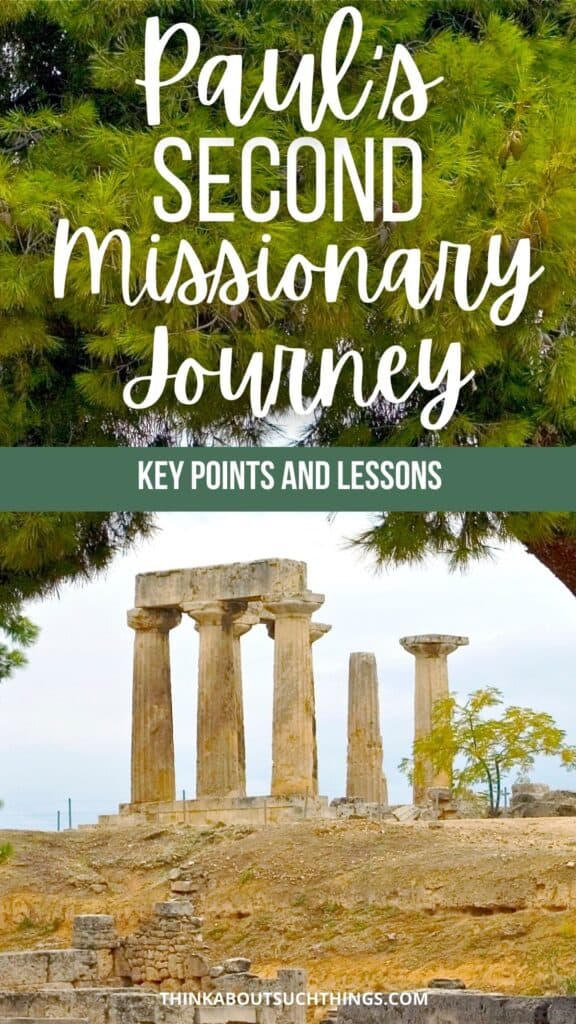
Before we get started, I do want to give a big thank you to Free Bible Images for letting me use their images of Paul’s journey.
What Happened On Paul’s Second Missionary Journey?
Paul’s second missionary journey lasted approximately 3 years, from 49 – 51 AD. After his first journey, he spent over a year in Antioch before setting out again. Paul asked Barnabas to accompany him, but a disagreement on whether Mark should join them led to them parting ways.
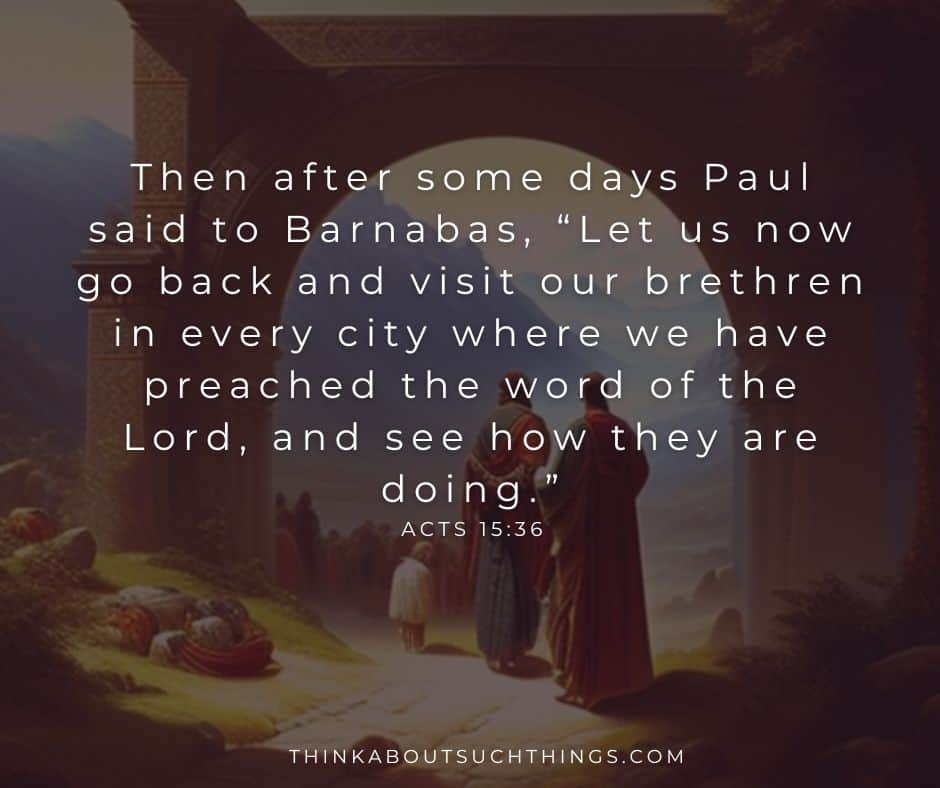
Therefore, Paul took Silas on this journey, along with others who joined him. As for Barnabas, him and Mark sailed to Cyprus to minister to the believers that they brought to Christ in Paul’s 1st missionary journey.
During their second missionary journey, Paul and his team visited many towns that had originally visited on their first journey. In this second round, many Jews and gentiles converted to Christianity.
A key thing to note is that Paul first met Timothy in Lystra. This young believer joined Paul and Silas. As the son of a Greek father and Jewish mother and being uncircumcised, Timothy was regarded as disrespecting his Jewish heritage by the Jews.
For this reason, Paul circumcised him, despite it being agreed that gentiles did not need to be circumcised to be Christians.
They traveled through Tarsus, Derbe, and Lystra, from where they headed to Troas.
In Troas, Paul’s original goal of revisiting the churches planted during his first missionary journey was altered. The Holy Spirit closed a door and prevented Paul from speaking in Asia and, through a vision, led the team to Macedonia, in the north of Greece.
In Philippi, the team went to the riverside on the Sabbath, where the Jews would meet. There they found a wealthy merchant who sold purple cloth named Lydia , who accepted the gospel. Lydia and her family converted to Christianity. The team stayed with her in her home for a while.
While still in Philippi, Paul freed a slave girl of a demon, used by her owners to generate an income through fortune telling.
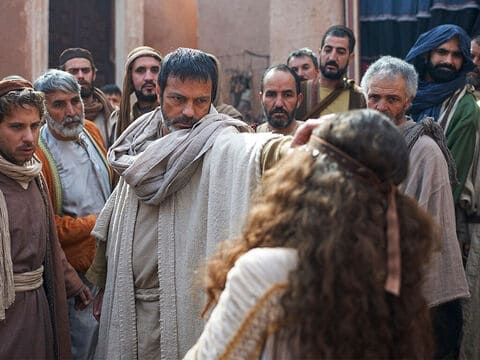
When the owners realized this, they took them to the magistrate, who had them flogged and imprisoned. At midnight in prison, while praying and singing psalms, an earthquake opened the prison doors and released their bonds!
When the prison guard noticed the doors were open, he thought all the prisoners had escaped and wanted to commit suicide. However, Paul spoke to him and told him they were all still there. The guard asked about their God, and Paul witnessed to him. The guard and his family believed and were baptized.
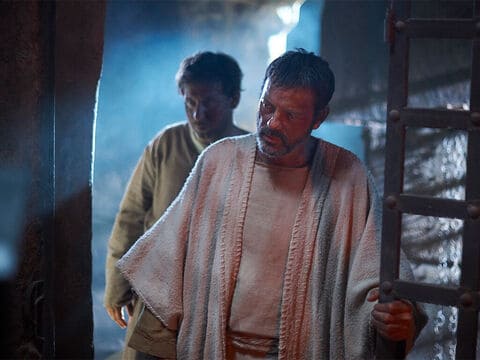
When they were released, Paul and Silas refused to leave until they received an apology from the town leaders. The leaders were shocked and came down to personally escort them out of town after learning they were Roman citizens. As Roman citizens, Paul and Silas were entitled to a trial before flogging and imprisonment.
Thessalonica
And some of them were persuaded to believe and joined Paul and Silas, along with a large number of the God-fearing Greeks and many of the leading women. – Acts 17:4 AMP
After their release from prison, Paul and his team traveled through Amphipolis and Apollonia to Thessalonica.
In Thessalonica, Paul and Silas preached the gospel to the Jews, but several refused to accept it. They also preached to gentiles and women, many of whom believed, infuriating the Jews. These non-believers then started a mob against them, which caused them to flee to Berea.
It is said in Acts 17 that the Bereans were nobler in character than the Thessalonians. Because they took what Paul said and went and examined the Scripture. They found what Paul was saying was true, and because of that man, Jews and Greeks were saved.
But word got out to those who caused problems in Thessalonica and went to Berea to stir up a mob there as well. Because of that, they sent Paul away to the coast, where he headed to Athens.
Silas and Timothy didn’t accompany him but stayed in Berea.
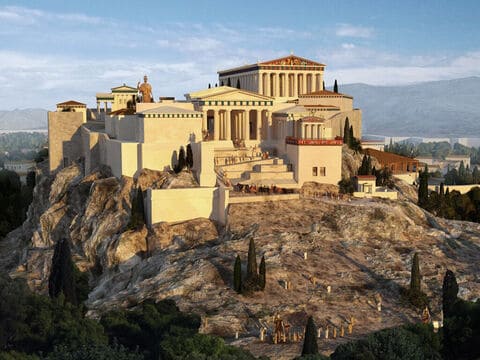
In Athens, Paul gave a famous speech to the Athenians at the Areopagus or the Hill of Ares. He had been preaching in the synagogues and marketplaces of Athens, where he had encountered some Epicurean and Stoic philosophers who were intrigued by his teachings.
They invited him to speak at the Areopagus, which was a place where philosophers and intellectuals would gather to discuss ideas.
In his speech, Paul spoke about the unknown God whom the Athenians had erected an altar to, and explained that this God was the one true God who had created everything. He also spoke about the resurrection of Jesus, which was a new and controversial idea to the Athenians.
While some Athenians were interested in what Paul had to say, others mocked him and dismissed his teachings. After his speech, Paul left Athens and continued on his journey.
Now the Lord spoke to Paul in the night by a vision, “Do not be afraid, but speak, and do not keep silent; 10 for I am with you, and no one will attack you to hurt you; for I have many people in this city.” 11 And he continued there a year and six months, teaching the word of God among them. – Acts 18:9-11 NKJV
Paul spent a significant amount of time in Corinth during his Second Missionary Journey. He arrived in around 50 AD, and stayed there for approximately 18 months, which made it one of the longest periods he spent in any one place during his missionary journeys. Silas and Timothy meet up with him there as well.
In Corinth, Paul worked as a tentmaker during the day and preached in the synagogues on the Sabbath. He was able to gain the support of some of the Jewish community in Corinth but also faced opposition from others who were resistant to his message.
One of the most significant events during Paul’s time in Corinth was his church establishment there. He worked closely with several other individuals, including Aquila and Priscilla, who became important figures in the early Christian church.
Paul faced many challenges during his time in Corinth, including physical threats and opposition from local authorities. Despite these challenges, however, he was able to establish a strong Christian community there and continued to spread the gospel throughout the region.
From there, they sailed to Ephesus, leaving Aquila, Priscilla , and Apollos there. Then returned to Caesarea and Jerusalem before returning back to Antioch in Syria.
Check Out The Other Missionary Journeys Of Paul

Maps of Paul’s 2nd Missionary Journey
As you can tell, Paul’s second journey is longer than his first, with LOTS of stops. We have covered the major events in these cities, but seeing a map is always nice. It helps give you a visual of where he and his team went.
Down below, you will find a map of Pauls’s 2nd journey route.
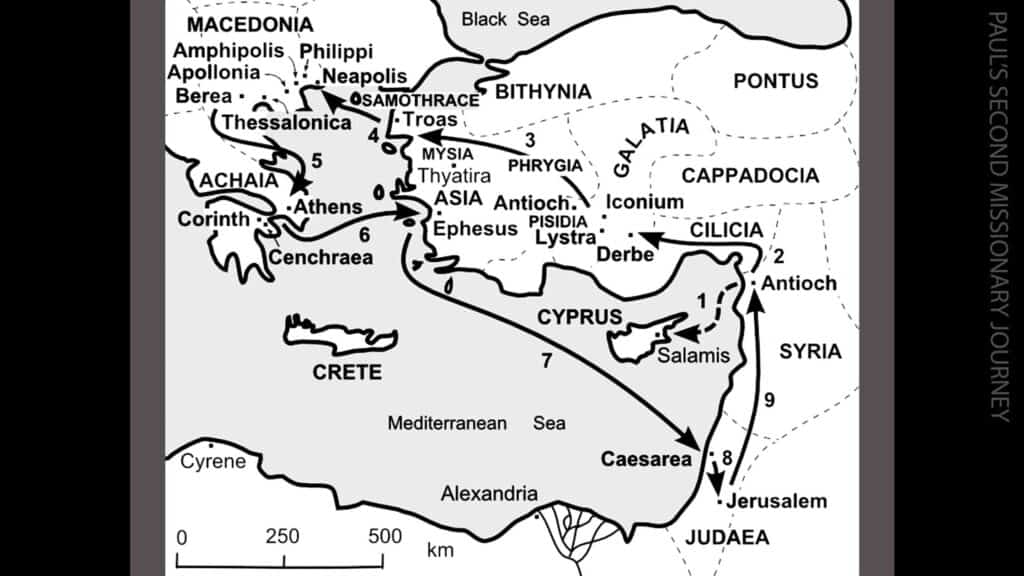
This map below gives you a nice overview of where key locations were in the Aegean sea .
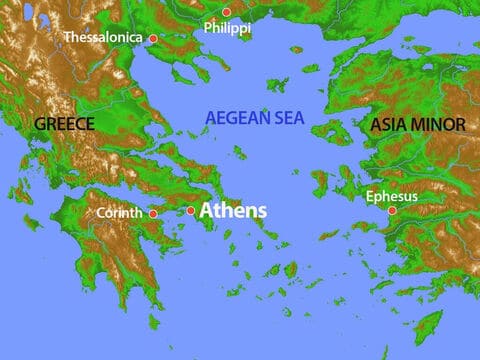
Key People On Paul’s 2nd Journey
Now, let’s take a look at the key players on this trip:
Paul, also known as Saul of Tarsus, was one of the most influential leaders in the New Testament. He was born a Jew and was a Pharisee. He later converted to Christianity after experiencing a vision of Jesus Christ while on his way to Damascus.
Paul played a crucial role in spreading the teachings of Christianity throughout the Roman Empire and authored many of the epistles or letters found in the New Testament. He faced numerous challenges and persecution as he traveled to various cities to share his faith.
Silas was a Jewish leader in Jerusalem and played an important role in the early Christian church. Silas was known for his eloquent speaking and persuasion skills, which made him a valuable asset to the apostle Paul on his missionary journeys.
Timothy is a young and faithful disciple of Paul, who played a significant role in spreading the gospel message throughout the ancient world. As an important figure in the early Christian church, Timothy was mentioned frequently in Paul’s letters to the Corinthians, Philippians, and Thessalonians, where he was described as a trusted co-worker and a dedicated leader.
Priscilla and Aquilla
Priscilla and Aquila were a couple who played a prominent role in the early Christian community. They are mentioned several times in the New Testament, including in Acts and Romans. Priscilla is believed to have been a Jewish woman from Rome, while her husband Aquila was likely of Jewish and Greek heritage.
Together, they were tent makers and worked alongside the Apostle Paul in his ministry. Priscilla and Aquila not only supported Paul financially, but they also taught and mentored other believers. Their partnership in both work and ministry sets an excellent example for couples and demonstrates the significant impact a husband and wife can make together in serving God.
Luke was a physician and companion of the apostle Paul. He was also one of the four Gospel writers, along with Matthew, Mark, and John. He also wrote the book of Acts.
FAQ About Paul’s Second Missionary Journey
You can read about the Apostle Paul’s second journey in Acts 15:36-18:22.
The second journey took place between 49-51AD.
It varies throughout the journey, but Silas, Timothy, Priscilla, and Aquilla accompany the apostle Paul.
Paul and his companions traveled through Syria, Turkey, Greece, and Jerusalem.
Paul traveled around 2,800 miles, making his first journey of 1,400 look like a cakewalk!
Important Lessons From Paul’s Second Missionary Journey
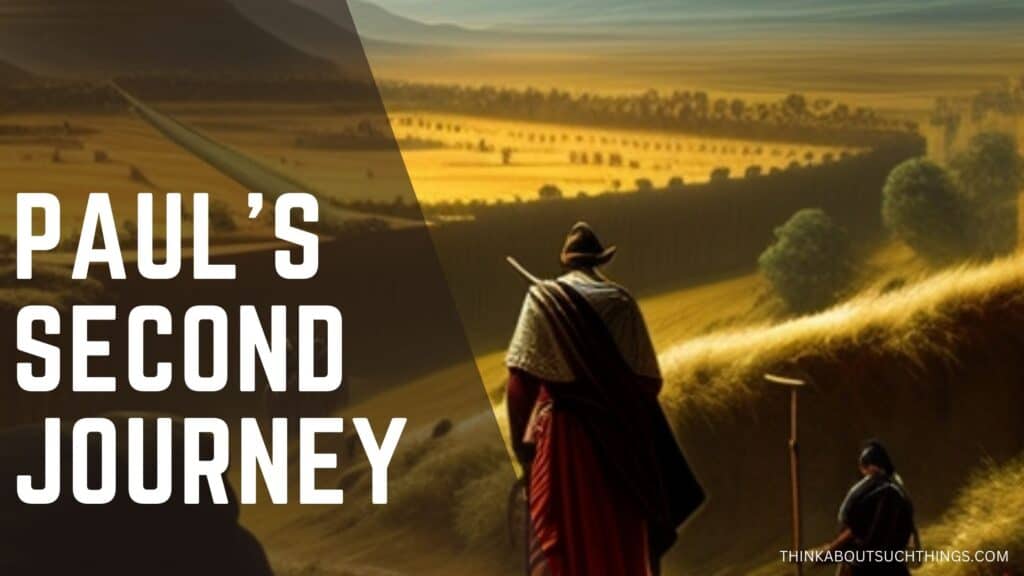
There are many lessons that Christian believers can learn from Paul’s life and letters. But here are few that I have found while studying his second journey.
- Consideration for the beliefs of fellow Christians – Through the circumcision of Timothy, Paul shows that Christians should consider the beliefs of fellow Christians to be able to evangelize to them. Although the circumcision was unnecessary, Timothy would not have been able to preach in the synagogues if he wasn’t circumcised, thus enabling him to reach more people.
- Be open to the prompting of the Holy Spirit – If Paul weren’t open to the prompting of the Holy Spirit and stuck to his original plans, many people who came to faith in Christ would not have been reached. As Christians, our plans should always be subjected to the will and plans of God.
- Praise God in all circumstances – Paul and Silas prayed and worshipped God while imprisoned. Christians are also encouraged to be steadfast in prayer (Colossians 4:2) and to praise God in all circumstances (1 Thessalonians 5:16-18).
- Always look out for persons to evangelize – As Paul traveled, he preached the gospel to whoever was prepared to listen. He preached the gospel to the prison guard in Philippi, saving his whole family, and even debated Christianity with Greek philosophers in Athens.
- Be prepared to do the right thing, even if it would cost you your freedom – Paul must have known that driving the fortune-telling demon out of the slave girl in Philippi would upset her owners, but he was prepared to do the right thing, even if it would land him in prison.
- We can talk to anyone about Jesus – Paul’s time in Athens is significant because it illustrates how he adapted his message to different audiences and engaged with people of different cultures and beliefs. Even though it was hard ground Paul was willing to try to reach the Greeks.
On Paul’s second missionary journey from 49-51 AD, he set out to revisit the churches planted during his first missionary journey. The Holy Spirit led him in a different direction, and he ended up preaching the gospel to multitudes in and around Greece and saw the salvation of many. Paul, with his resilience and connection to the will of God, is an excellent example to Christians today.
If you would like to leave me a comment below I would love to hear from my readers!
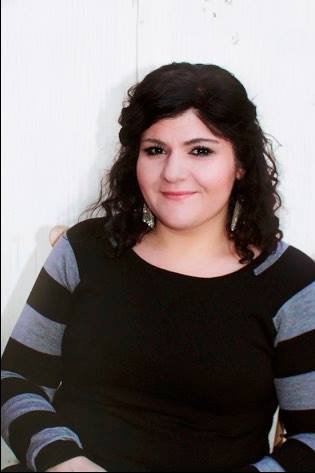
Melissa is a passionate minister, speaker and an ongoing learner of the Bible. She has been involved in church and vocational ministry for over 18 years. And is the founder of Think About Such Things. She has the heart to equip the saints by helping them get into the Word of God and fall more in love with Jesus. She also enjoys family, cooking, and reading.
She has spoken in churches in California, Oregon, Texas, and Mexico and has been featured in Guidepost Magazine and All Recipes Magazine. Read More…
I accept the Privacy Policy

What happened on Paul's second missionary journey?
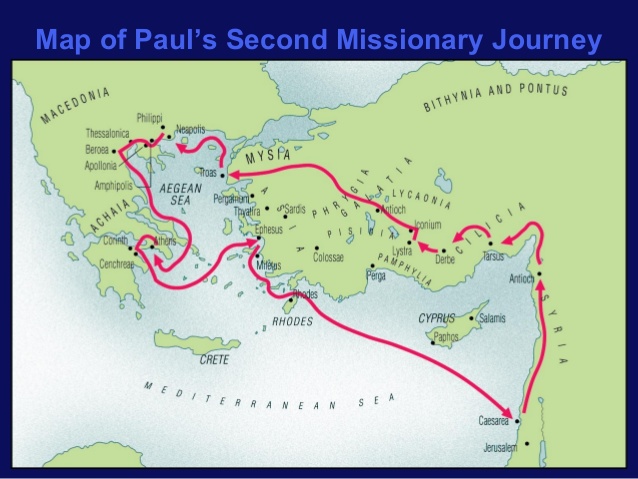

Paul’s Missionary Journeys: The Beginner’s Guide
by Ryan Nelson | Jul 6, 2020 | Bible topics
Paul’s missionary journeys helped spread the gospel throughout much of the ancient world. Over the course of his ministry, the Apostle Paul traveled more than 10,000 miles and established at least 14 churches.
The Book of Acts records three separate missionary journeys that took Paul through Greece, Turkey, Syria, and numerous regions you won’t find on modern-day maps. Some scholars argue that Paul also took a fourth missionary journey, since parts of the New Testament appear to reference travels that may have taken place after the events in Acts.
Paul’s travels played a crucial role in the formation and development of the early Christian church. Many of the communities he encountered on these missionary journeys were the same ones he wrote to in his pastoral epistles.
In this guide, we’re going to follow Paul’s footsteps as he travelled across the ancient world, looking at the places he went and the major events that took place along the way. At times it can be challenging to distinguish between ancient cities, provinces, and regions (and there are sometimes multiple names that refer to the same area), so as we go, we’ll make some of those distinctions more clear.
Paul’s first missionary journey (Acts 13–14)
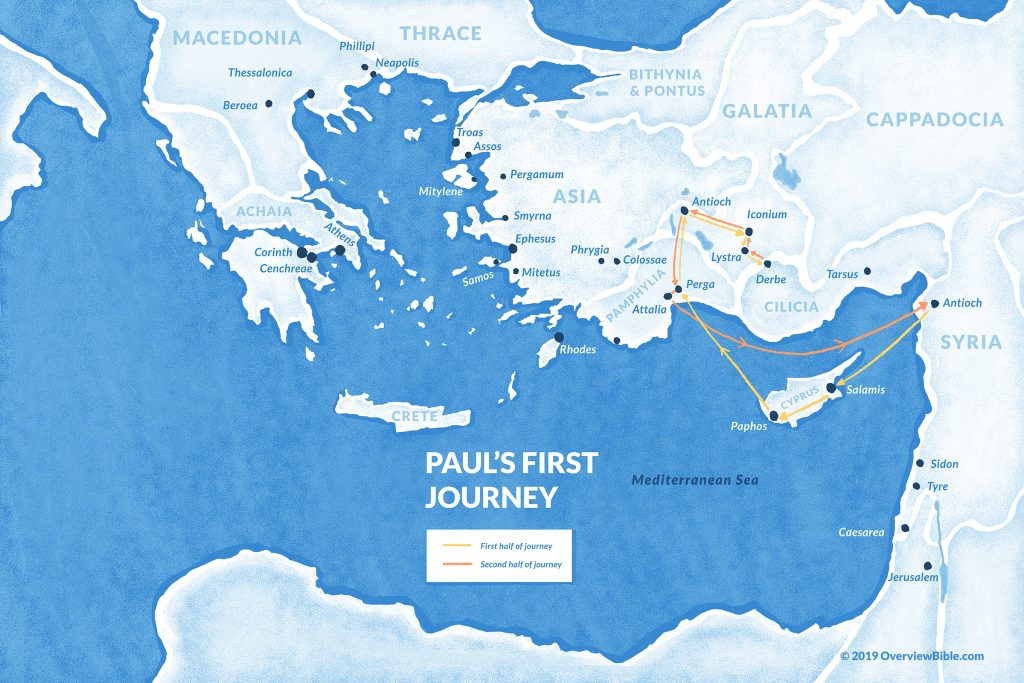
Paul’s first missionary journey began in Antioch. You may notice that maps of the ancient world often have two cities labelled Antioch. They’re both named after Antiochus, father of Seleucid I. The Antioch in Acts 13 was the third largest city in ancient Rome and capital of the province of Syria. Today, it’s part of southern Turkey. The other Antioch was part of Pisidia, an ancient region which is also now part of Turkey. Your Bible likely refers to it as Pisidian Antioch or Antioch of Pisidia.
In Antioch (the big city in Syria), the Holy Spirit singled out Paul and Barnabas from the believers worshiping there, and sent them on their first missionary journey.
Paul’s first journey took him by boat to the Roman province of Cyprus. Today, Cyprus is a country known as the Republic of Cyprus. It’s a mediterranean island south of Syria. Paul and Barnabas arrived in the port city of Salamis, where John Mark (who was possibly Barnabas’ cousin), helped them share the gospel in Jewish synagogues.
From Salamis, the group moved across the island to Paphos, where they were met by a Jewish sorcerer named Bar-Jesus (also known as Elymas the sorcerer). This sorcerer worked for the governor—Sergius Paulus—who sent for Paul and his companions because he wanted to hear the word of God. Elymas opposed them and tried to turn Sergius from the faith, and so Paul, filled with the Holy Spirit, called him a “child of the devil” and struck him blind. Sergius saw what happened, and believed.
Ironically, Elymas meant to steer Sergius away from Christ, but he became the very vehicle God used to draw Sergius toward him.
From Paphos, Paul and company set sail for the Roman province of Pamphylia, located in modern day Turkey. They arrived in the city of Perga, where John Mark left them and returned to Jerusalem (which, interestingly, was in the opposite direction from where they just came). We don’t know why John Mark decided to leave, but this would later create a rift between Paul and Barnabas.
Together, Paul and Barnabas travelled to Pisidian Antioch, where local synagogue leaders invited them to speak. Initially, the Jewish people were receptive to the gospel, but a week later, the entire city gathered to hear Paul and Barnabas, and the Jewish leaders became jealous. They resisted the message of the gospel, and so Paul and Barnabas made an important pivot: they began preaching to the Gentiles.
Many of the Gentiles believed the gospel, and Luke (the traditional author of Acts) tells us that:
“The word of the Lord spread through the whole region. But the Jewish leaders incited the God-fearing women of high standing and the leading men of the city. They stirred up persecution against Paul and Barnabas, and expelled them from their region.” —Acts 13:49–50
Driven out of Pamphylia, Paul and Barnabas travelled to Iconium, an eastern city in the region of Phrygia. Iconium still exists today as the Turkish city of Konya.
Once again, Paul and Barnabas spoke in the synagogue, where Jews and Greeks alike accepted the gospel. But the Jews who didn’t accept it stirred up trouble, even as Paul and Barnabas began performing signs and wonders (Acts 14:3). As support for Paul and Barnabas grew, so did the opposition they faced, and eventually, they became aware of a plot to abuse and stone them. So they left.
Fleeing the threat in Iconium, Paul and Barnabas left Phrygia altogether and travelled to Lystra, a city in the province of Lycaonia. Here, Paul healed a man who was lame.The locals who witnessed this miracle thought Paul and Barnabas were gods in human form, calling Barnabas Zeus and Paul Hermes. The priest from the temple of Zeus brought bulls and wreaths to offer sacrifices to them.
Paul and Barnabas attempted to redirect their praise to God, but struggled to keep the crowds from offering sacrifices to them.
Jews came from Antioch and Iconium and continued what they’d started. They riled up the crowds and convinced them to stone Paul. Believing he was dead, they dragged him outside the city. When the disciples gathered around him, Paul got up and went back inside the city.
Then Paul and Barnabas went to Derbe, another city in Lycaonia. There, they “won a large number of disciples” (Acts 14:21).
The return to Antioch
After a time in Derbes, Paul and Barnabas went back the way they came, working their way through Lystra, Iconium, Pisidian Antioch, and Perga. In each city, they encouraged the believers there and strengthened their faith, as they would continue doing on their future missionary journeys. They did, however, stop in a new Pamphylian city on the way: Attalia. Acts only mentions it in passing, but presumably, they established a community of believers there as well.
From there, they skipped a return voyage to the island of Cyprus and went straight back to Antioch (the big one), where they told the church what happened on their journey.
Paul’s second missionary journey (Acts 16:23–20:38)
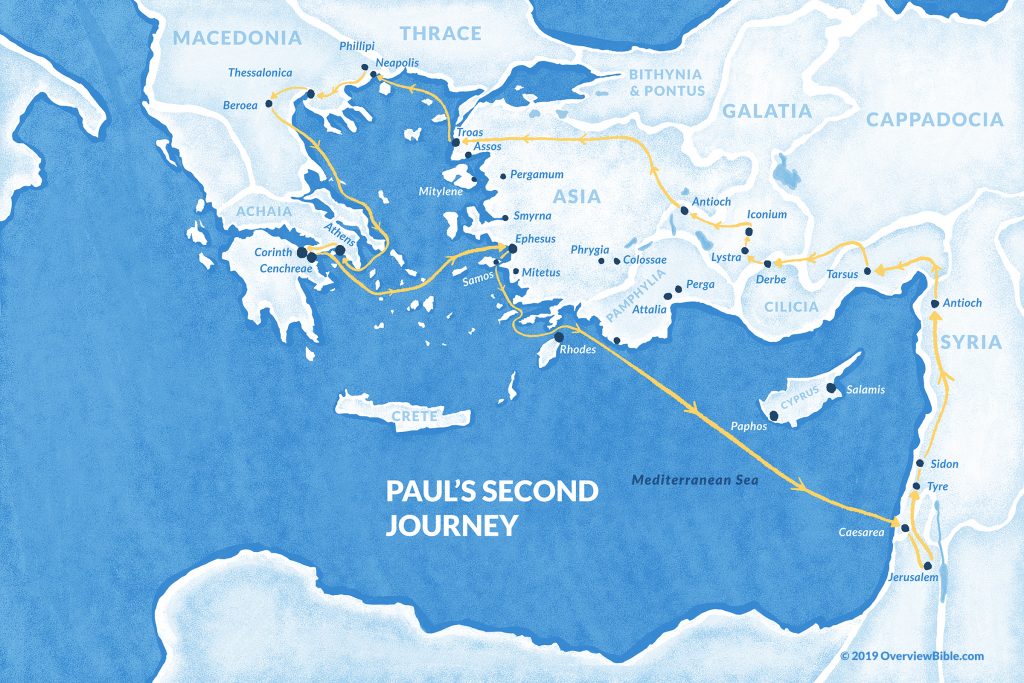
Paul’s second missionary journey established many of the churches he would later write to in his pastoral epistles. Interestingly, this may have happened in part because of a “sharp disagreement” he had with Barnabas. Paul’s original plan was to essentially have a rerun of their first trip, strengthening the communities they’d formed in each city and telling them what the Council of Jerusalem had ruled in regards to Gentile believers.
But Barnabas wanted to take John Mark—who had left them shortly into their previous journey. Paul was so opposed to the idea that they parted ways, initiating two separate missionary journeys. Barnabas took John Mark and went with the original plan, making their way back to the island of Cyprus. Paul took a man named Silas and travelled through the provinces of Syria and Cilicia.
The first cities that Acts mentions by name on Paul’s second journey are Derbe and Lystra. At this time, Paul and Silas picked up a new companion: Timothy.
The locals spoke highly of Timothy, and Paul wanted to bring him along even though he was half Greek, which meant local Jews would have a harder time accepting their message. Out of concern for these local Jews, Paul circumcised Timothy—even though, ironically, one of the things they were coming to tell Christians was that Gentiles didn’t have to be circumcised. (See Acts 16:3–4.)
Acts doesn’t specify where in Phrygia Paul and his companions stopped, but since he’d established a church in Iconium on the first trip, that community would’ve been on his mind (even though last time he was there, people had plotted to stone him). Interestingly, Acts notes that Paul and his companions journeyed here after they were “kept by the Holy Spirit from preaching the word in the province of Asia” (Acts 16:6).
Just north of Phrygia was the province of Galatia. Acts makes no mention of what happened here, but this is the province Paul wrote to in his letter to the Galatians . Interestingly, part of the purpose of Paul’s second trip was to share the news from the Council of Jerusalem regarding the Law of Moses and whether or not Gentiles (or Christians in general) should be expected to follow it. The council decided the Torah didn’t apply to Gentile believers (though they did hang on to a few rules). But by the time Paul wrote the Book of Galatians, Christians there were feeling pressure to obey the law (particularly in regards to circumcision) in order to be saved.
From Galatia, Paul’s group traveled west, until they reached the border of Mysia—a western region in the province of Asia, which is now part of Turkey. They intended to head north to the region of Bithynia, “but the spirit of Jesus would not allow them to” (Acts 16:7). So they passed by Mysia and headed to the city of Troas. Here, Paul had a vision of a man in Macedonia, begging him to “Come over to Macedonia and help us.” Paul took this vision as a sign that God was calling them to Macedonia, which was across the Aegean Sea.
From Troas, Paul and his companions sailed across the Aegean Sea, making a pitstop on the island of Samothrace before landing in Neapolis and then traveling to Philippi. In Philippi, they spoke with women outside the city gate. One of them was a wealthy cloth dealer named Lydia. After her household was baptised, she persuaded Paul’s group to stay with her for a while.
Later, Paul, Silas, and the others were confronted by a spirit-possessed slave woman who could predict the future. She followed them for many days, shouting, “These men are servants of the Most High God, who are telling you the way to be saved” (Acts 16:17). Paul became so annoyed that he cast out the spirit. Her owners were furious, because they had been profiting off of her fortune telling. So they turned the local magistrates against them, claiming Paul and Silas were stirring up trouble and trying to get Roman citizens to believe and do illegal things.
The authorities had Paul and Silas severely flogged and thrown in prison. Late at night, while they were worshiping, an earthquake shook the foundations of the prison, opened the doors, and freed the prisoners from their chains. When the jailer awoke and saw the doors open, he prepared to kill himself. But Paul stopped him and assured him everyone was still in the prison.
After listening to Paul and Silas share the gospel, the jailer believed in Jesus and had his whole household baptized.
The next morning, the magistrates ordered Paul and Silas released. Paul revealed that they were Roman citizens, who had just been beaten and imprisoned without trial, and the authorities became afraid. Paul and Silas returned to Lydia’s house, and then left the city of Troas.
After passing through the Macedonian cities of Amphipolis and Apollonia, they arrived in Thessalonica. Since Thessalonica had a synagogue, Paul turned to his usual method—preaching the gospel on the Sabbath. Over the course of three weeks, he achieved the usual result—many Jews and Greeks alike embraced the gospel . . . and those who didn’t were outraged by it.
At night, the Thessalonian believers sent Paul and his companions away to the nearby city of Berea.
The Bereans listened eagerly to the gospel and carefully examined the Scriptures to see if they supported Paul’s claims. Many Jews and Greeks became believers, but some agitators from Thessalonica heard Paul was in Berea, and they stirred up the crowds. Silas and Timothy stayed in Berea, while Paul was escorted out of Macedonia to Athens.
In the first century, Athens was in the region of Achaia, just south of Macedonia. Today, it’s the capital of Greece, and the largest city in the country.
Paul was essentially waiting around for Silas, Timothy, and the others to rejoin him. But while he waited, he noticed that Athens was full of idols. He debated with philosophers in both the synagogue and marketplace. Some Athenians were open to his ideas, and they were eager to discuss them. One idol in particular caught his eye—it had an inscription that read: “to an unknown god.” He seized on this as an opportunity to tell them about the “unknown God” who died and rose so that all might have eternal life.
Paul’s message in Athens incorporated observations about what he saw around him as well as quotes from famous Greek philosophers to point back to the gospel. After establishing a group of believers in Athens, Paul headed west to the city of Corinth.
In Corinth, Paul stayed and worked with a couple of Jewish tentmakers named Priscilla and Aquila. Every Sabbath, he preached to Jews and Greeks in the synagogue. Silas and Timothy rejoined Paul here, and Paul began focusing his energy on testifying about Jesus to the Jews.
When the Jews opposed his message, Paul devoted himself to reaching Gentiles, and he left the synagogue. As more Greeks embraced the gospel, the Corinthian Jews brought Paul before the governor, who basically told them to take a hike and refused to help.
Paul stayed in Corinth for a year and a half, and he left with Priscilla and Aquila.
The return journey
Before setting off for Syria, Paul stopped for a vow-fulfilling haircut in the port city of Cenchreae, which was just a hop, skip, and a jump from Corinth. With his companions, he sailed across the Aegean Sea to Ephesus, where he dropped of Priscilla and Aquila, and promised to come back if he could. After a short stay in Ephesus, Paul set sail for Caesarea, which was across the Mediterranean and far to the southeast. From there, he made the trek south to Jerusalem.
Paul’s second missionary journey ended in Jerusalem.
Paul’s third missionary journey (Acts 18:23–20:38)
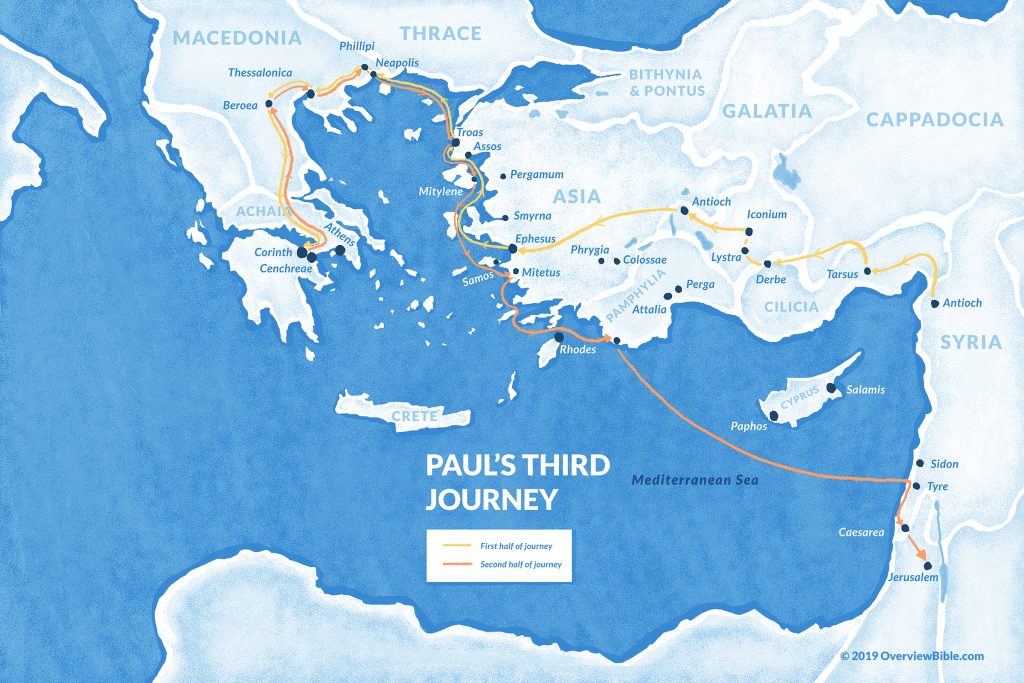
When you read Acts, there’s no transition from Paul’s second missionary journey to his third. His arrival in Jerusalem almost immediately began his next trip. But while his second journey ends in Jerusalem, the beginning of his third journey is actually in Antioch, which is about 300 miles north.
Phrygia and Galatia
From Antioch, Paul once again worked his way west, passing “from place to place throughout the region of Galatia and Phrygia, strengthening all the disciples” (Acts 18:23). This included Derbe, Lystra, and Iconium.
Paul traveled west to Ephesus, the capital of the province of Asia, where he’d left Priscilla and Aquila on his previous journey. Since he’d last visited, a man named Apollos had been preaching part of the gospel, but he didn’t know about the Holy Spirit. So when Paul arrived, he taught the Ephesians about the difference between water baptism and the baptism of the Spirit.
For three months, Paul preached in the synagogues. When people started criticizing Christianity, he left and began holding discussions in a lecture hall.
This went on for two years, and all the while, God used Paul to perform miracles. Even things Paul had touched—handkerchiefs and aprons—healed the sick and drove out evil spirits.
Some Jews thought invoking Paul’s name would let them drive out demons. Seven sons of a chief priest named Sceva said to an evil spirit, “In the name of the Jesus whom Paul preaches, I command you to come out” (Acts 19:13). The spirit replied that it knew Jesus and Paul, but not them, and then it pulverized all seven of them.
As word spread about what happened, people began to revere the name of Jesus. Local sorcerors came to repent, and they burnt scrolls that would have been worth more than 130 years’ worth of wages (Acts 19:19).
Around this time, a local silversmith named Demetrius realized that the future of his business (making idols) was jeopardized by the gospel. The demand for idols was going down all across the province of Asia, but especially in Ephesus, where he lived. So Demetrius gathered all the craftsmen and workers whose businesses were impacted, and stirred the entire city into an uproar. They seized two of Paul’s companions and brought them into a theater.
Paul wanted to address the crowd, but the disciples didn’t let him. Instead, a city clerk told everyone that unless they were going to bring formal charges against the men in a legal assembly, they were in danger of being charged with rioting.
Macedonia and Greece
After things settled down in Ephesus, Paul headed across the Aegean Sea to Macedonia. He traveled throughout the region, encouraging believers, and eventually arrived in Greece, where he stayed for three months. He intended to sail back to Syria (where his journey started), but some people plotted against him, so he took another lap through Macedonia instead.
Along the way, disciples joined Paul from many of the communities he’d ministered to. He had companions from Berea, Thessalonica, Derbe, and the province of Asia. These followers went ahead of Paul to Troas, in Asia. Paul stayed briefly in Philippi, then joined them.
Paul stayed in Troas for seven days. The night before he left, he stayed up late talking in a room upstairs. A young man sat in a window, drifted off to sleep, and fell to his death. Paul threw his arms around the man and declared that he was alive, and he was. Then Paul went back upstairs and continued talking until daylight.
Paul walked from Troas to Assos, which was just to the south, and then sailed for the nearby city of Mitylene. Eager to reach Jerusalem before Pentecost, Paul sailed past Ephesus and stopped in Miletus. There, he met with the leaders of the Ephesian church and essentially told them that he had taught them everything they needed to know, that he would not see them again, and that they needed to be on guard against false teachers. This is when Paul also famously quoted Jesus, sharing words that aren’t recorded in any of the gospels: “It is more blessed to give than to receive” (Acts 20:35).
And then he set sail.
Paul and his companions stopped briefly in Kos, Rhodes, and Patara before heading across the Mediterranean Sea to Phoenicia (the coastal region south of ancient Syria, which is now part of Syria). They arrived in Tyre, where “through the Spirit” (Acts 21:4), the local disciples urged Paul not to go to Jerusalem. He ignored them.
From Tyre, the voyage continued to the port city of Ptolemais, and then Caesarea, where the group stayed with Philip the evangelist (not to be confused with Philip the apostle ). Here, a prophet warned Paul that he would be bound by the Jews in Jerusalem and handed over to the Gentiles.
Still, he pressed on to Jerusalem, and by the end of Acts, the Jewish leaders had handed him over to Roman rulers.
Paul’s fourth missionary journey
Acts explicitly records three distinct missionary journeys. But some scholars and even ancient Christian writers have claimed that there was also a fourth missionary journey which was only hinted at in the Bible.
The argument for a fourth journey is primarily based on clues from Paul’s letters. He occasionally refers to events and visits that may not be accounted for in Acts or the epistles.
For example, Paul suggested he would travel to Spain (Romans 15:24), but he provides no record of this journey in his letters. However, early church fathers claimed Paul did, in fact, travel to Spain.
In his letter to the Corinthians, first-century church father Clement of Rome said Paul “had gone to the extremity of the west,” which at the time presumably meant Spain. Fourth-century church father John of Chrysostom said, “For after he had been in Rome, he returned to Spain, but whether he came thence again into these parts, we know not.” And Cyril of Jerusalem (also from the fourth century) wrote that Paul “carried the earnestness of his preaching as far as Spain.”
In 2 Timothy 4, Paul makes an ambiguous reference to “my first defense” and claims he was “delivered from the lion’s mouth” (2 Timothy 4:16-17). Some have interpreted this as a reference to his first defense before Emperor Nero, which he was heading for at the end of Acts.
Paul’s letters make other references to events not recorded in Acts, but since there is so much overlap in the locations mentioned, and Paul spent multiple years in some of these places on his three recorded journeys, it’s difficult to say whether or not this fourth journey ever actually happened.
Take a closer look at Paul’s footsteps
Paul’s missionary journeys are a key part of the New Testament. Paul’s epistles were originally written to the communities he formed on these journeys, and they show us exactly how Christianity spread to the Gentiles so rapidly.
Here at OverviewBible, we’ve charted each of Paul’s missionary journeys into beautiful, full-color posters you can display in your classroom or church office. Each comes in multiple sizes on fine art paper with a matte finish.

Get an overview of the entire Bible
The Bible is huge. Together, its 66 books are three times longer than Moby Dick . It’s so big that even if you’ve been reading it your whole life, you can still miss the point. Jeffrey Kranz, founder of OverviewBible, wrote The Beginner’s Guide to the Bible to help Christians and non-Christians alike get a better grasp of this important text.
This non-preachy, jargon-free guide will walk you through the Bible’s major themes and characters and help you see how each book fits into the larger story of Scripture.
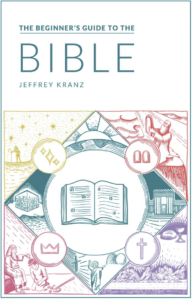
Explore the Bible with us!
We create research-based articles and handy infographics to help people understand the Bible.
Join our email list, and we’ll send you some of our best free resources—plus we’ll tell you whenever we make something new.
You have Successfully Subscribed!

- Bible Books
- Bible characters
- Bible facts
- Bible materials
- Bible topics
Recent Posts
- Interesting Facts about the Bible
- Logos Bible Software 10 review: Do you REALLY need it?
- Who Was Herod? Wait… There Were How Many Herods?!
- 16 Facts About King David
- Moses: The Old Testament’s Greatest Prophet

Privacy Overview
Author: Ron Graham
simplybible.com

Outline of Paul’s Second Missionary Journey —Much farther afield
This is our second study on the journeys of Paul. We look at Paul’s second missionary journey (Acts 15:36 to 18:22).
On the first journey, Barnabas had been Paul's main companion. On this second missionary journey, he chooses Silas for that role. Paul and Barnabas had intended to go together, but they disagreed about taking John Mark with them.
John had quit the first missionary journey early (Acts 13:13) apparently to Paul's great displeasure. To resolve the matter, Barnabas took John Mark with him and they sailed to Cyprus, while Paul took Silas with him, and they started north over land.
1. Paul and Silas leave Syrian Antioch. They travel through Syria and into Cilicia (Acts 15:36-41).
2. They worked in Derbe and Lystra, where Timothy was recruited to join them. They travel on to Iconium. In these cities they have success in strengthening the disciples and making new converts (Acts 16:1-5).
3. They pass through the regions of Phrygia and Galatia because the Holy Spirit would not let them go to Asia. In Mysia the Spirit changed their plans again and sent them to Troas (Acts 16:6-8).
4. They were now far out of the territory covered by the first journey. But they were to be called further yet. Paul received a vision calling him to Macedonia (Acts 16:9-12).
5. In Philippi they convert Lydia (Acts 16:13-15).
6. They cure a slave girl of her evil spirit and are thrown into prison (Acts 16:16-24).
7. Their jailer is converted (Acts 16:25-34).
8. They are released from prison with some embarrassment to the authorities (Acts 16:35-40).
9. Next they go to Thessalonica, preach in the synagogue and make converts. But some Jews make trouble (Acts 17:1-9).
10. Paul and Silas are sent by night to Berea. Working in Berea, they find ready minds to receive the gospel. But the trouble makers arrive and Paul is taken to Athens to avoid them (Acts 17:10-15).
11. Paul's sermon in Athens (Acts 17:16-34).
12. After Athens Paul went to work in Corinth, where he met Aquila and Priscilla. In Corinth, Silas and Timothy rejoined Paul (Acts 18:1-5).
13. In Corinth, some Jews make serious trouble again (Acts 18:6-17).
14. Paul sets sail to go back to Syria. From Corinth Paul went to Ephesus via Cenchrea. He stayed at Ephesus only a short time on that occasion (Acts 18:18-21).
15. He took a ship to Caesarea (south of Tyre and Ptolemais), visiting the church there, then went back to Syrian Antioch where his journey had begun (Acts 18:22).
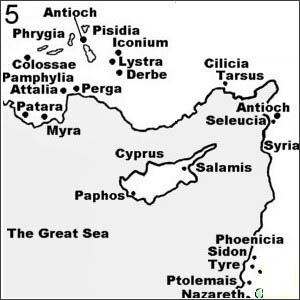
➤ DONATE
to simplybible.com Webservant Ron Graham
Home | Bible Topics | The Hub | List | Next www.simplybible.com Copyright © Ron Graham 2001
Bible Study Resources - Tips, Online Bible Search, Devotions
- BROWSE TOPICS X
- Devotionals
- Newsletters
What Should We Know about Paul's Second Missionary Journey?
- Jennifer Heeren Crosswalk.com Contributing Writer
- Updated Sep 14, 2022

Think of the book of Acts in the bible as a travel log that is full of adventures. Paul’s second missionary journey had him traveling around the eastern end of the Mediterranean Sea. His route started in Jerusalem, then he traveled north through Syria, then west through Turkey, then even further west to Greece. Finally, he traveled back home along the shoreline of Greece and Turkey.
When Was Paul's Second Missionary Journey?
The Apostle Paul’s first missionary journey took place in approximately 47-48 AD. Then about a year later, he began his second missionary journey in approximately 49-52 AD. You can read about this second missionary journey in Acts 15:36-18 :22.
During this time, he revisited some of the churches where he had previously preached. It’s good to check on new believers to make sure they are still learning from sound teaching. However, he was also always on the lookout for new people to preach to. Various churches were strengthened in their faith during this missionary journey, and the Church grew larger daily. During this time, the Apostle Paul wrote 1 st and 2 nd Thessalonians while he was visiting Corinth.
Things We Should Know about Paul's Second Missionary Journey
At the beginning of this second missionary journey, Paul and Barnabas separated. Barnabas took John Mark and sailed to Cyprus. Paul took Silas on his journey around the eastern Mediterranean Sea. Then in Syria and Cilicia, Paul met and began discipling Timothy. In Lystra and Iconium, they instructed believers to follow what the apostles in Jerusalem were doing.
They met a slave girl that was possessed by a demon. The girl wouldn’t leave them alone and kept calling out to them. Finally, they commanded the demon to come out of her in Jesus’s name. It did! This, however, angered her master, who began speaking out against the Apostle Paul and his team. This master got them thrown into the inner dungeon of a prison with their feet in stocks. But Paul and Silas didn’t lose their courage. They kept singing hymns to their God, even from prison! And around midnight, an earthquake shook the prison. The cell doors flew open! Their chains fell off! The jailer woke and thought that all his prisoners had escaped, so he started to kill himself in shame until he heard Paul shout for him to stop. The jailer was amazed that he hadn’t lost his prisoners after all. He realized that there must be a mighty God behind this incredible incident and asked Paul and Silas what he should do to be saved. They told him to believe in the Lord Jesus, so he and his household did just that and asked to be baptized. Paul and Silas were officially released the next morning.
But some Jews there didn’t like Paul’s message, so they escorted him all the way to Athens so they wouldn’t have to hear it anymore. Then they returned to Berea and told Silas and Timothy to join Paul.

Photo Credit: ©iStock/Getty Images Plus/artisteer
In Athens, the Apostle Paul was very troubled by all the idols he saw. There were also many opportunities to debate. The Epicurean and Stoic philosophers there loved to debate everything. Paul told them about Jesus and his resurrection , but most didn’t understand.
Paul tried to explain it more clearly to them in a way they might understand. The people of Athens had many shrines and altars in their land. Paul pointed out that one of them simply said, To an Unknown God , and then said that this was the God that he was preaching about. The God who made the world and everything in it. He gives life and breath to every living thing. He satisfies every need. His main purpose was for all people to seek after Him as the source of life. And this same God is also a God of justice who demands that His people repent of their sins. For no man is without sin.
When they heard this, some laughed in contempt, others said they wanted to hear more later, and still others joined Paul and became believers. Hearts must be softened before they are ready to hear the good news of the gospel. It takes patience and time.
Then Paul traveled to Corinth, where he met Aquila and his wife Priscilla and re-joined up with Silas and Timothy. Paul continued to preach the Word, and when he encountered opposition, he figuratively shook their dust away and went on to preach to other people. Paul saw many more people become believers and be baptized.
One night, Paul had another vision from the Lord. The Lord said, “Don’t be afraid! Speak out! Don’t be silent! For I am with you, and no one will attack and harm you, for many people in this city belong to Me.” So Paul stayed in Corinth another year and a half, teaching and preaching. Finally, Paul set off to go back home to the port of Caesarea and Jerusalem, and he took Priscilla and Aquila with him.
What Does This Missionary Journey Teach Us?
2. Learn to speak the gospel plainly and simply but don’t forget the part about the crucifixion and resurrection because that is where the power is.
3. Be like the Berean believers. Search the scriptures to make sure that everything you’re being told is God’s truth. Don’t simply believe that everything spoken from a pulpit is true.
4. Remember that when you speak about the gospel and God’s ways, many people will scoff and even laugh at you. Don’t let their ignorance get to you. Wipe their dust from your shoes and keep praying to and speaking about the God you know so well. Because not everyone will be critical; some will believe.
5. Imagine Jesus saying this to you, just as He spoke to Paul, “Don’t be afraid! Speak out! Don’t be silent! For I am with you, and no one will attack and harm you, for many people in this city belong to Me.” Let that infuse you with courage because God continues to say that to His people every day.
6. Read 1 st and 2 nd Thessalonians in the Bible as an encouragement message from Paul directly to you.
Conclusion to Paul’s Second Missionary Journey
Paul’s second missionary journey included seeing old friends, discipling people, preaching to a lot of new people, hearing disgruntled people balk their message, and even witnessing miracles. And God was in the midst of every single encounter. It’s not that different from our Christian walk today. Jesus is still in the middle of all our encounters with people. He will help you spread His message.
Paul made it his life-long pursuit to follow Jesus’s great commission, even through much turmoil and opposition. He kept going forward, knowing that he was following the Way, the Truth, and the Life. You can too.
Jesus came and told his disciples, “I have been given all authority in heaven and on earth. Therefore, go and make disciples of all the nations, baptizing them in the name of the Father and the Son and the Holy Spirit. Teach these new disciples to obey all the commands I have given you. And be sure of this: I am with you always, even to the end of the age.” Matthew 28:18-20 NLT
Photo Credit: ©iStock/Getty Images Plus/krisanapong detraphiphat

Recently On Bible Study

Editor's Picks

Popular Today

- Privacy Policy
- Terms of Use
- Crosswalk App
- California - Do Not Sell My Personal Information
- California - CCPA Notice
Explore the context and learn about the different movements in the book of Jeremiah in our Biblical Overview Videos. Explore all our videos
Navigate the Chapters
Chapter 1: Introduction
Chapter 2: pentecost, chapters 3-7: in jerusalem, chapters 8-12: judea & samaria, chapters 13-20: the missionary journeys, chapters 21-28: paul's witness spreads to rome.
Paul’s Second Missionary Journey
1 Paul went first to Derbe and then to Lystra, where there was a young disciple named Timothy. His mother was a Jewish believer, but his father was a Greek. 2 Timothy was well thought of by the believers in Lystra and Iconium, 3 so Paul wanted him to join them on their journey. In deference to the Jews of the area, he arranged for Timothy to be circumcised before they left, for everyone knew that his father was a Greek. 4 Then they went from town to town, instructing the believers to follow the decisions made by the apostles and elders in Jerusalem. 5 So the churches were strengthened in their faith and grew larger every day.
A Call from Macedonia
6 Next Paul and Silas traveled through the area of Phrygia and Galatia, because the Holy Spirit had prevented them from preaching the word in the province of Asia at that time. 7 Then coming to the borders of Mysia, they headed north for the province of Bithynia, but again the Spirit of Jesus did not allow them to go there. 8 So instead, they went on through Mysia to the seaport of Troas.
9 That night Paul had a vision: A man from Macedonia in northern Greece was standing there, pleading with him, “Come over to Macedonia and help us!” 10 So we decided to leave for Macedonia at once, having concluded that God was calling us to preach the Good News there.
Lydia of Philippi Believes in Jesus
11 We boarded a boat at Troas and sailed straight across to the island of Samothrace, and the next day we landed at Neapolis. 12 From there we reached Philippi, a major city of that district of Macedonia and a Roman colony. And we stayed there several days.
13 On the Sabbath we went a little way outside the city to a riverbank, where we thought people would be meeting for prayer, and we sat down to speak with some women who had gathered there. 14 One of them was Lydia from Thyatira, a merchant of expensive purple cloth, who worshiped God. As she listened to us, the Lord opened her heart, and she accepted what Paul was saying. 15 She and her household were baptized, and she asked us to be her guests. “If you agree that I am a true believer in the Lord,” she said, “come and stay at my home.” And she urged us until we agreed.
Paul and Silas in Prison
16 One day as we were going down to the place of prayer, we met a slave girl who had a spirit that enabled her to tell the future. She earned a lot of money for her masters by telling fortunes. 17 She followed Paul and the rest of us, shouting, “These men are servants of the Most High God, and they have come to tell you how to be saved.”
18 This went on day after day until Paul got so exasperated that he turned and said to the demon within her, “I command you in the name of Jesus Christ to come out of her.” And instantly it left her.
19 Her masters’ hopes of wealth were now shattered, so they grabbed Paul and Silas and dragged them before the authorities at the marketplace. 20 “The whole city is in an uproar because of these Jews!” they shouted to the city officials. 21 “They are teaching customs that are illegal for us Romans to practice.”
22 A mob quickly formed against Paul and Silas, and the city officials ordered them stripped and beaten with wooden rods. 23 They were severely beaten, and then they were thrown into prison. The jailer was ordered to make sure they didn’t escape. 24 So the jailer put them into the inner dungeon and clamped their feet in the stocks.
25 Around midnight Paul and Silas were praying and singing hymns to God, and the other prisoners were listening. 26 Suddenly, there was a massive earthquake, and the prison was shaken to its foundations. All the doors immediately flew open, and the chains of every prisoner fell off! 27 The jailer woke up to see the prison doors wide open. He assumed the prisoners had escaped, so he drew his sword to kill himself. 28 But Paul shouted to him, “Stop! Don’t kill yourself! We are all here!”
29 The jailer called for lights and ran to the dungeon and fell down trembling before Paul and Silas. 30 Then he brought them out and asked, “Sirs, what must I do to be saved?”
31 They replied, “Believe in the Lord Jesus and you will be saved, along with everyone in your household.” 32 And they shared the word of the Lord with him and with all who lived in his household. 33 Even at that hour of the night, the jailer cared for them and washed their wounds. Then he and everyone in his household were immediately baptized. 34 He brought them into his house and set a meal before them, and he and his entire household rejoiced because they all believed in God.
35 The next morning the city officials sent the police to tell the jailer, “Let those men go!” 36 So the jailer told Paul, “The city officials have said you and Silas are free to leave. Go in peace.”
37 But Paul replied, “They have publicly beaten us without a trial and put us in prison—and we are Roman citizens. So now they want us to leave secretly? Certainly not! Let them come themselves to release us!”
38 When the police reported this, the city officials were alarmed to learn that Paul and Silas were Roman citizens. 39 So they came to the jail and apologized to them. Then they brought them out and begged them to leave the city. 40 When Paul and Silas left the prison, they returned to the home of Lydia. There they met with the believers and encouraged them once more. Then they left town.
Apostle Paul's Second Missionary Journey Map
Late summer 49 a.d. to late autumn.
Pharisaic Judaizers come down to Antioch (Acts 15:1, 5) in the late summer of 49 A.D. and teach that circumcision is necessary before a person can be saved. Paul, Barnabas, Titus and certain others (Galatians 2:1 - 2) are sent to Jerusalem to confer with other apostles, elders and brethren concerning the relationship between circumcision and salvation.
The gathering of Paul and countless others to discuss this huge controversy in the early church is commonly referred to as the Jerusalem Conference. This conference occurs in the Fall of 49 A.D. around the time of the Feast of Tabernacles (Acts 15:2).
Paul and Barnabas have a private meeting with the apostles James, Peter and John about the circumcision question (Galatians 2:4 - 10). They agree that circumcision is not required for Gentiles to be saved. The ministry of Paul and Barnabas is confirmed.
The Question of Circumcision
The circumcision question is discussed further among the conference attendees. Peter offers his judgment then Paul and Barnabas tell the conference about the miracles and wonders God has wrought among the Gentiles through them (Acts 15:12). James then renders his judgment (Acts 15:13 - 21).

The apostles, elders and the whole church agree with James that the Gentiles do not need to be circumcised in order to become a believer and receive salvation. The conference has Judas (Barsabas) and Silas travel with the two evangelists to Antioch to deliver a letter, written by James, summarizing what was decided in Jerusalem regarding the circumcision question (Acts 15:30 - 32).
Late Autumn 49 A.D.
Paul and Barnabas stay in Antioch a certain number of days until they have a sharp disagreement over whether to take John Mark with them on another missionary journey. The argument becomes so heated that they separate (Acts 15:36 - 41).
Late Autumn 49 to Late Summer 50
Paul takes Silas with him to Tarsus. From there they travel to Derbe and Lystra. It is in Lystra that he meets Timothy, who would become his frequent traveling companion, fellow laborer in spreading the gospel and his best friend (Acts 16:1; 1Timothy 1:2, 4:14).
The apostle has Timothy circumcised (Acts 16:3). He then takes him and Silas to churches in the regions of Galatia (Iconium) and Phrygia (Antioch) to deliver the decision rendered at the Jerusalem conference.
Forbidden to Preach
Paul, as he journeys to the northwest of Antioch, desires to preach the gospel in western Asia. God's spirit, however, forbids him to do so (Acts 16:6). The apostle and his group continues to travel north toward the region of Mysia. He wants to travel East to the province of Bithynia but again is forbidden to do so (Acts 16:7). Him and his companions then decide to go to the port city of Troas on the Aegean Sea.
It is in Troas that Luke, the writer of the book of Acts, joins Paul and company. God then gives him a vision of a man in Macedonia (Greece) begging him for help (Acts 16:8 - 9). The group then immediately boards a ship, which sails near the island of Samothrace (Samothracia), then arrives at Neapolis (Acts 16:10 - 11).
First European Convert
From Neapolis the group goes to Philippi, where a woman named Lydia hears Paul's preaching. On Pentecost in 50 A.D. Lydia is baptized along with her entire household (Acts 16:12 - 15).
Paul, while in Philippi, casts a demon out of a female slave (Acts 16:16 - 18). Her masters, however, angry that they have lost the ability to make more money from the slave's demonic divination, stir up the city against him and Silas. The two evangelists are arrested, beaten and put in prison (Acts 16:19 - 24).
Soon after the evangelists arrive in jail a miraculous earthquake causes all the cell doors to open and the bonds of all prisoners to be loosed. This event leads to the conversion of the prison guard.
Evangelizing Thessalonica
A freed Paul and Silas, along with Timothy and Luke, travel through the cities of Amphipolis and Apollonia and arrive in Thessalonica (Acts 17:1). In Thessalonica Paul visits a Jewish synagogue and for three consecutive Sabbaths (Saturdays) explains why Jesus is the Old Testament prophesied Savior of Mankind (Acts 17:2 - 4).
Although many believe what is said certain Jews, envious of the Gospel's success, form a mob and start a riot (Acts 17:4 - 5). The riotous crowd go to the house of Jason seeking him and Silas. When they are not found, the crowd drags Jason and some brethren to the local civil magistrates and accuses them of wrongdoing (Acts 17:5 - 8). In a short time, however, Jason and the brethren are let go.
The Noble Bereans
Paul and Silas preach in a synagogue in Berea. The Bereans are not only willing to listen to what they have to say they also verify what is preached against the Old Testament scriptures (Acts 17:11 - 12). Many Bereans come to believe the Gospel. Unfortunately, Jews from Thessalonica arrive in the city seeking to cause more trouble for him (Acts 17:13).
Paul immediately leaves for the coast and sets sail for Athens while the rest of his party stay in Berea (Acts 17:14). In Athens he requests Timothy and Silas come to the city (Acts 17:15).
Debate in Athens
The apostle, while waiting in Athens for his traveling companions, preaches the Gospel to any Athenian who would listen. Some who hear his message are Jews and devout people. Others are Epicureans (followers of Epicurus) who believe the highest aim of man is to seek a pleasant life while other are Stoics. The Stoics believe that man's happiness consists of bringing himself into harmony with the universe.
After hearing some of Paul's message the Epicureans and Stoics take him to the Areopagus (or Mars Hill as the Romans call it) to further explain what he teaches (Acts 17:16 - 19).
On Mars Hill Paul uses an altar he saw dedicated to "an unknown god" as a springboard for teaching the crowd about the real God that can be known (Acts 17:19, 22 - 23).
Late Summer 50 to Autumn 52 A.D.
Paul leaves Athens and travels to Corinth. It is in Corinth that he first meets Priscilla and Aquila. Since both he and the couple make a living as tentmakers he stays at their house. He preaches the gospel every Sabbath in the synagogue. Silas and Timothy join him in Corinth. (Acts 18:1 - 5). The synagogue eventually splits and a new church is formed. After the split he stays and teaches in Corinth for a year and a half.
In the winter of 51 A.D. Paul is brought before the judgment seat of Gallio (Acts 18:12 - 18) and is released. He remains in Corinth until the Spring of 52 A.D. when he then travels to the port city of Cenchrea. In the city he has his head shaved due to a vow he took (Acts 18:18). He soon boards a ship and travels to Ephesus with Priscilla and Aquila.
In Ephesus Paul preaches in a synagogue but soon leaves the couple behind so that he can be in Jerusalem to celebrate the Feast of Tabernacles (Acts 18:19 - 21). He sails from Ephesus to Caesarea, then travels to Jerusalem. After keeping the Feast he returns to Antioch (Acts 18:21 - 22).

Paul’s Four Missionary Journeys: The Complete Guide
God did many amazing things through the life and ministry of the apostle Paul. The gospel was spread to many people across the known world thanks to Paul’s efforts, despite the severe opposition and persecution Paul faced.
What were Paul’s missionary journeys? Paul took four missionary journeys. Paul’s first three missionary journeys are recorded in the book of Acts. The fourth is alluded to in Paul’s letters. On the first missionary journey Paul went through Cyrus, Pamphylia, and Galatia. On his second missionary journey he went through Galatia, Macedonia, and Achaia. Paul’s third journey took him through Galatia, Asia, Macedonia, Achaia, and ended in Jerusalem. After his third missionary journey Paul was imprisoned in Caesarea for two years and later transported to Rome where he was then placed under house arrest for another two years. His fourth missionary journey is not clear, but it may have included Spain, Crete, Asia, Achaia, and Macedonia.
By looking at Paul’s missionary journeys we can look and reflect on the beginning of the fulfillment of God’s command to “Go therefore and make disciples of all nations” (Matthew 28:19).
Timeline of Paul’s Missionary Journeys
- A.D. 37: Converted on the road to Damascus
- A.D. 37-40: Spends three years in Arabia
- A.D. 40: Brief visit to Jerusalem to meet with the apostle Peter
- A.D. 40-44: Preaches and ministers in Tarsus and surrounding regions
- A.D. 44 or 45: Relocates to Antioch in Syria
- A.D. 45 or 46: Travels with Barnabas to visit Jerusalem, brings a famine relief offering
- A.D. 46 or 47: First missionary journey with Barnabas, likely lasts 1-2 years
- A.D. 50: Attends the Jerusalem Council
- A.D. 51: Leaves on second missionary journey, trip lasts 2.5 to 3 years, including 18 months in Corinth
- A.D. 54: Leaves on third missionary journey, trip lasts more than 4 years, including 3 years in Ephesus
- A.D. 58: Arrested in Jerusalem, put on trial before the Roman governor Felix
- A.D. 58-60: Held in Caesarea for two years
- A.D. 60: Put back on trial by Festus the new Roman governor; eventually transported to Rome
- A.D. 61: Arrives in Rome
- A.D. 61-63: Placed under house arrest for two years
- A.D. 63: Released from house arrest, likely launches his fourth missionary journey
- A.D. 66 or 67: Imprisoned in Rome again
- A.D. 67 or 68: Martyred under Nero’s persecution
*Dates are approximate.
Paul’s Background
Before he was known as the apostle Paul, he was first known as Saul of Tarsus. He was a brilliant, pious, zealous, and well-educated Pharisee, from a wealthy and well-connected family. Saul was obviously intimately acquainted with the Hebrew Scriptures, but was also thoroughly acquainted with Greco-Roman history, language, and culture.
Saul became famous in Palestine because of his persecution of Christians. But things changed, dramatically. By God’s providence, Saul became a Christian after a supernatural encounter with Jesus on the road to Damascus (Acts 9).
After Saul’s conversion, he traveled to a few different places, over several years, including three years in Arabia (Gal. 1:17–18), a brief visit to Jerusalem (Gal. 1:18), and then several years of preaching in the regions of Syria and Cilicia (Gal. 1:21).
Partnership with Barnabas
After some heavy persecution of the Christians in Jerusalem, some believers ended up living in the city of Antioch. They preached the gospel there and a “great number” believed in Jesus (Acts 11:21). When the apostles in Jerusalem heard about this, they sent a man named Barnabas to Antioch to serve in the church there (Acts 11:22).
Barnabas was a prophet (Acts 13:1) and an apostle (Acts 14:14). Through his ministry a “great number of people were brought to the Lord” (Acts 11:24).
After being in Antioch a while, Barnabas traveled to Tarsus to find Saul. Barnabas recruited Saul to come teach and lead and serve in the church in Antioch in Syria (Acts 11:25-26). Saul relocated to Antioch sometime between 44 and 46 A.D. and served as one of the leaders of the church there.
Barnabas and Saul would become ministry traveling partners for the next few years, including at least one earlier trip to Jerusalem (Acts 11:27-30) in order to bring a famine relief offering to the Christians in Jerusalem (likely sometime between 45 and 46 A.D.).
First Missionary Journey
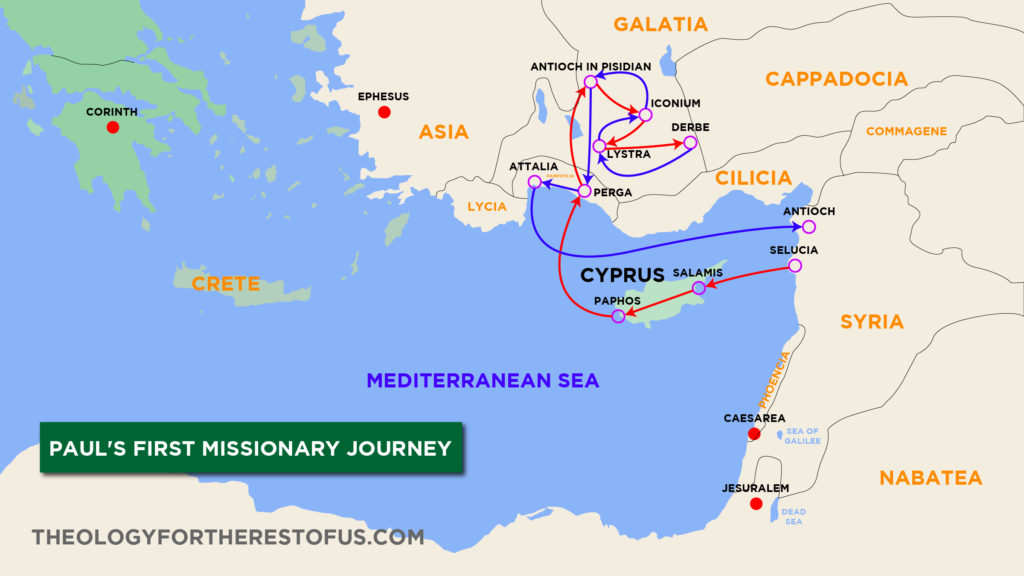
Barnabas and Saul sensed the call of the Holy Spirit to go out on their first missionary journey (Acts 13-14). Sometime around 46 A.D. (or 47 A.D.), Barnabas and Saul were set apart by the Holy Spirit and sent out on their first missionary journey by the church at Antioch.
Before Barnabas and Saul officially left on their first missionary journey, they recruited a young man named John Mark to go with them. John Mark was the son of a woman named Mary (mentioned in Acts 12:12). She owned the house where the Christians had been meeting and praying when Peter was miraculously delivered from jail by the angel.
It is likely that, as a young boy, John Mark had witnessed Jesus’ ministry first-hand. Sadly, however, during the missionary journey, John Mark would eventually abandon Barnabas and Saul. This would later lead to a significant dispute between Barnabas and Saul a few years in the future.
Barnabas and Saul sailed from Seleucia to the island of Cyprus, apx. 100 miles off the coast of Syria. They began by preaching to Jewish people in the synagogues of Salamis. The crew did ministry in several parts of the island until they got to Paphos (Acts 13:4-6).
During their ministry they faced significant opposition. One of their earliest opponents was a magician who was a Jewish false prophet. Saul performed a supernatural act that blinded this false prophet. These events led to the conversion of the Roman proconsul Sergius Paulus (Acts 13:6-12).
Saul Becomes Paul
After the events in Cyprus, the author of the book of Acts, Luke, begins to refer to Saul as Paul. Some Christians have asserted that Saul changed his name. However, it’s more likely that Saul and Paul were two different names for the same person all along; he was known by both names for many years.
After launching a Gentile-focused ministry, Paul would have been interacting with many Gentiles, and they would have likely preferred to refer to him by the Gentile name. It appears Luke sought to make this a point of emphasis. Scholar Greg Lanier says :
“When Saul Paul launches his Gentile-focused ministry among primarily Greek-speakers (beginning with Acts 13:9), it’s natural for Luke, the author of Acts, to begin referring exclusively to him by his Greek name. Nor is it surprising that he’s later referred to as ‘Paul’ in Jerusalem, since there were Greek speakers there too. Indeed, Luke could be making a thematic point by shifting from Saul to Paul around chapter 13, given the broader theme of Acts (e.g., 1:8). After all, the church’s nucleus is shifting from predominantly Jewish-centered Jerusalem to the Greek-centered ‘ends of the earth,’ such as Rome.”
Pamphylia and Galatia
Barnabas, Paul, and John Mark then traveled across the Mediterranean Sea to Perga in Pamphylia. This is where John Mark deserts Paul and Barnabas and heads back to Jerusalem (Acts 13:13).
From Perga, Paul and Barnabas then continued northward into the province of Galatia, coming to the city of Antioch in Pisidia (not to be confused with their home base city of Antioch in Syria).
Archaeologists have discovered an inscription containing the name ‘Sergius Paulus’ in the city of Antioch in Pisidia (he was the Roman proconsul that became a Christian back on the island of Cyprus). This is strong evidence that Sergius Paulus had family roots in Antioch in Pisidia. Some scholars have argued that he was the person that probably encouraged Barnabas and Paul to travel up to Antioch in Pisidia.
Once they arrived in Antioch in Pisidia, Paul went to the synagogue and preached about the good news of Jesus. Paul effectively preached in the synagogue for multiple weeks. This resulted in many people coming to faith in Jesus (Acts 13:14-44).
Unfortunately, Barnabas and Paul faced significant opposition there too. Part of the problem they faced was the jealousy of certain Jews. There were many Gentiles showing up to hear the gospel preached. Some Jews became jealous and started to contradict what Paul had to say. Since the Gentiles were more willing to hear what Paul had to say, he turned and preached to the Gentiles.
And when the Gentiles heard this, they began rejoicing and glorifying the word of the Lord, and as many as were appointed to eternal life believed. —Acts 13:48
The Gentiles’ response to the gospel was positive. The gospel continued to spread amongst Gentiles, but yet again the jealousy of the Jews became a significant issue. The Jews eventually drove Barnabas and Paul out of Antioch.
After leaving Antioch in Pisidia, they traveled eastward, further into the Galatian region, arriving at the city of Iconium. There they preached and did miracles in the name of Jesus.
Very similar to what had happened in Antioch, Paul went into the synagogue in Iconium to teach and the result was that many Jews and Greeks believed in Jesus, but the unbelieving Jews there stirred up trouble against Paul, dividing the city (Acts 14:1-4). Barnabas and Paul left the city when they heard about attempts to stone them (Acts 14:5).
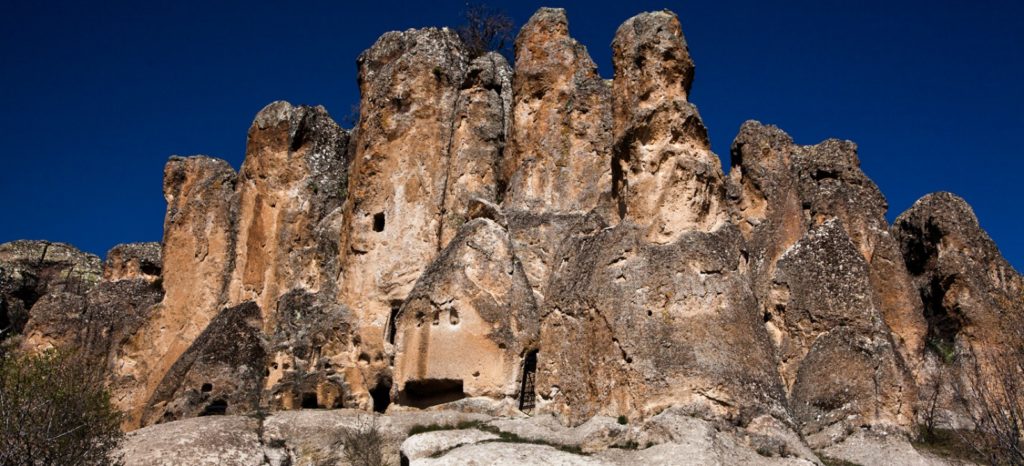
Lystra and Derbe
They then came to Lystra. There Paul performed a miracle causing a crippled man to walk again. When this occurred the people of the area assumed Barnabas and Paul were gods. The priest of Zeus brought animals to offer as sacrifices to Barnabas and Paul. When Barnabas and Paul realized what was happening, they tore their clothes in lament and told the people of the one true God (Acts 14:8-18).
The Jewish unbelievers from Antioch and Iconium had come to Lystra too, stirring up trouble. They convinced the people of Lystra to stone Paul and left him for dead outside the city. But Paul wasn’t dead. He got up walked back into the city (Acts 14:19-20).
The book of Acts doesn’t give us details about the events of that day when Paul walked back into the city, but I imagine the city’s residents were shocked. It was quite rare for anyone to survive stoning.
Barnabas and Paul then continued onto Derbe the next day. They preached and “won a large number of disciples” (Acts 14:21). Archeologists have discovered several inscriptions that show the Christian faith was a major presence in the city of Derbe after Barnabas and Paul’s visit.
Facing Tribulations for the Sake of Discipleship
Barnabas and Paul began their trek back home, but they decided that they’d first travel back through Galatia. When you look at a map, you see that it would have been much faster (and likely easier) to travel from Derbe directly to Antioch in Syria.
Derbe is less than 260 miles away from Antioch in Syria and less than 140 miles away from Paul’s original hometown of Tarsus. Barnabas and Paul could have traveled eastward through the region of Cilicia. Paul was very familiar with Cilicia and likely had friends throughout the region that could give them safe refuge along the way.
But Barnabas and Paul intentionally traveled more than 280 miles in the opposite direction of Antioch in Syria. Even though they had suffered great persecution in Galatia, they wanted to go back through the Galatian cities, before heading home, because they wanted to strengthen the disciples in those cities.
They returned to Lystra and to Iconium and to Antioch, strengthening the souls of the disciples, encouraging them to continue in the faith, and saying that through many tribulations we must enter the kingdom of God. —Acts 14:21-22
The journey through these cities for a second time gave them the opportunity to teach doctrine, establish elders in the churches, and pray with the believers.
After this, Barnabas and Paul then continued back down to Perga in Pamphylia. They preached in that region for a time. They eventually made their way over to the nearby port city of Attalia and sailed from there to Antioch in Syria (Acts 14:24-28).
Return to Antioch
Barnabas and Paul returned back home to Antioch in Syria stay there after the trip for “a long time” (Acts 14:28).
They had traveled more than 800 miles. Their first missionary journey had probably lasted between one and two years. When Barnabas and Paul arrived back in Antioch in Syria, they shared with everyone about the many people who had come to faith in Jesus and the churches that were established.
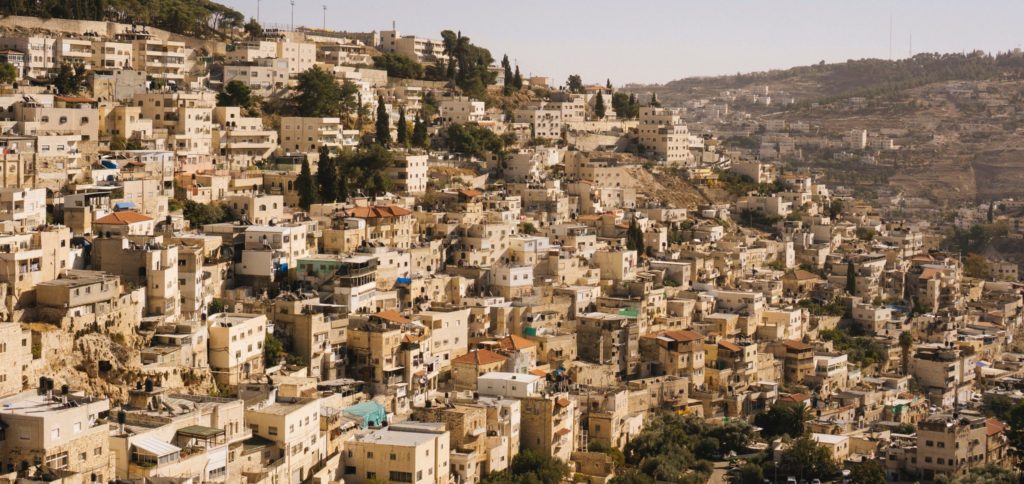
Jerusalem Council
After returning, Barnabas and Paul learned about a particular faction from Judea that had been confusing many Christians in the region by preaching a false gospel. This group had been preaching that, in order to become a Christian, the Gentiles must follow the Old Testament law, including circumcision (Acts 15:1).
Barnabas and Paul seem to have spent significant time disputing this false message and debated the Judean faction.
Eventually, this debate, about this false gospel, was appealed to the apostles in Jerusalem (Acts 15:2). This led to the Jerusalem Council (Acts 15:3-35), which likely took place sometime in 50 A.D. (some scholars date this event as early as 48 A.D. and some date it as late as 51 A.D.).
While traveling to Jerusalem for the council, Barnabas and Paul made stops along the way throughout Phoenicia and Samaria, encouraging believers wherever they went.
At the council, all the apostles concluded that the Gentiles do not need to follow the Jewish laws in order to become Christians. Barnabas and Paul (as well as several other men who had been at the council) headed back to Antioch to declare the good news. After the council they stayed in Antioch “some days” (Acts 15:36).
Paul and Barnabas Separate
Not long after the Jerusalem Council, Barnabas and Paul began planning their second missionary journey. They believed it was essential that they go to the Gentile world to proclaim the statements that came from the council.
Originally, Barnabas and Paul had intended to go out together again, however, they had a “sharp disagreement” (Acts 15:39). The source of this dispute was John Mark. Barnabas wanted John Mark to come along again, but Paul was against this idea since John Mark had deserted them on their previous missionary trip when they were in Pamphylia. Paul saw John Mark as a liability.
Due to this sharp disagreement, Barnabas and Paul would go on separate missionary journeys. Barnabas took John Mark and sailed to Cyprus. Paul took a young man named Silas and traveled by land (Acts 15:39-41).
Paul’s Second Missionary Journey
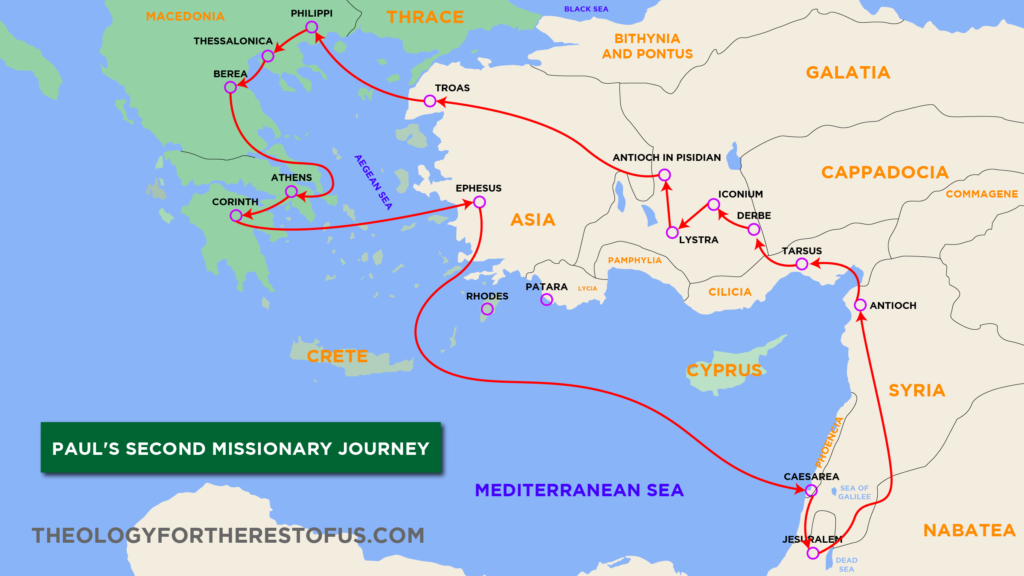
Paul likely started his second missionary journey (Acts 15-18) sometime late in 50 A.D. or early in 51 A.D. (but some scholars date both the council of Jerusalem and the launch of this missionary journey as early as 48 A.D.).
Paul and Silas started by traveling northwestward by land through the region of Cilicia. The Roman road that they would have used went directly through Paul’s hometown of Tarsus. I imagine this would have given Paul the sweet opportunity to reconnect with many old friends.
Paul and Silas made stops in the churches all throughout the region, along their way, “strengthening” believers (Acts 15:41).
Return through Galatia
Paul and Silas continued their travels westward into Galatia. They spent significant time in several Galatian cities including Derbe, Lystra, and Iconium, connecting with the churches that Paul had planted with Barnabas on this first missionary journey.
Paul and Silas taught the believers throughout Galatia what had been decided at the council in Jerusalem and the “churches were strengthened in the faith, and they increased in numbers daily” (Acts 16:5).
Paul Circumcises Timothy
Along the way, Paul and Silas meet a young man named Timothy from that region. He had a good reputation. Paul decided to let Timothy accompany them. However, Paul first circumcised Timothy (Acts 16:3).
It seems that Paul knew that having an uncircumcised man like Timothy with him could somehow impede the advance of the gospel wherever they preached.
Paul intended to continue to preach that circumcision was not necessary for salvation. But Paul knew that Timothy’s presence could potentially cause their opponents to claim that the only real reason that Paul was making these claims is because he had an uncircumcised friend (Timothy).
Paul’s Ministry Restricted
Paul and his crew traveled throughout the “region of Phrygia and Galatia” (Acts 16:6) looking for opportunities to preach the gospel in Asia (modern-day southwest Turkey), but they were restricted from doing so multiple times. They then traveled to the region of Mysia (modern-day northwest Turkey), attempting to eventually make their way northward toward Bithynia, but multiple times they were restricted or diverted by the Spirit (Acts 16:7).
It seemed that God’s providence was leading them somewhere other than what Paul had originally intended. They passed through Mysia again and eventually ended up in the city of Troas near the cost of the Aegean Sea.
Luke Joins the Team
In Troas, Luke joins their missionary crew. The book of Acts does not explicitly state this, but it’s implied. Throughout most of the book of Acts, Luke speaks in the third person. However, starting in Acts 16:10, Luke begins to speak in first person, as if he had joined the team by that point.
Luke would become one of Paul’s ministry protégés. He was a Greek physician, but he also functioned as an investigative journalist. He eventually writes both the Gospel of Luke and the book of Acts. Some scholars have also suggested that Luke wrote the book of Hebrews.
Macedonian Call and Travel to Philippi
While at Troas, Paul received a vision. This vision was of a Macedonian man asking for Paul to come and help them (Acts 16:9-10). After receiving this vision they sailed across the Aegean Sea to the island of Samothrace, and then onto Neapolis (modern-day northeastern Greece).
The missionary crew then traveled to Philippi where they stayed for “some days” (Acts 16:12). While there, they preached the gospel. One specific woman they met was Lydia. She became a believer along with the rest of her household and invited Paul and his companions to stay (Acts 16:13-15).
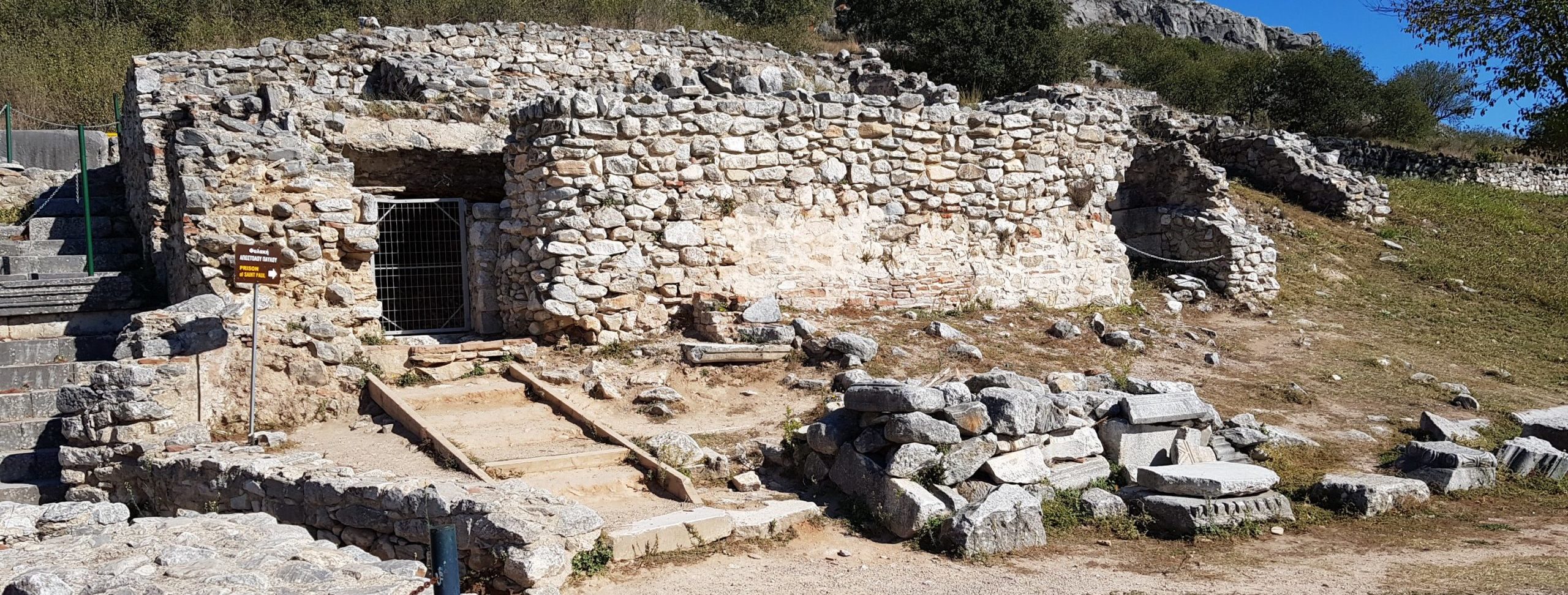
Paul and Silas Jailed in Philippi
While in Philippi, Paul and Silas met a slave girl who was demon possessed. Her owners made money off of her because the demon gave her the ability to function as a fortune-teller. For several days she followed Paul and Silas around, declaring that Paul and Silas were preachers of the one true God (Acts 16:16-18).
Paul cast the demon out of her. The girl’s owners realized that they wouldn’t make any more money from her, because she could no longer function as a fortune-teller. They were angry so they took Paul and Silas to the magistrates. Paul and Silas were beaten with rods and thrown into jail. Paul had previously been beaten and persecuted, but this marked the first time he was officially imprisoned (Acts 16:18-24).
While in prison, Paul and Silas prayed and sung hymns to the Lord. As they sang and prayed many of the other prisoners listened. Late in the night an earthquake occurred, this earthquake not only opened all the doors but broke their chains.
The jailer believed that all the prisoners had escaped and was about to kill himself (the Romans would’ve blamed the guard and likely would’ve executed him). But Paul and Silas stopped him and told him that no one had escaped. Then the jailer responded asking how to be saved.
And they said, “Believe in the Lord Jesus, and you will be saved, you and your household.” —Acts 16:31
God turned the persecution into an opportunity for gospel proclamation. Paul and Silas were not only able to witness to the jailer but all the prisoners listening to their hymns and prayers throughout the night. Paul went to the jailers home to preach and several people came to faith (Acts 16:25-34).
When the town magistrates learned that Paul and Silas were Roman citizens, the magistrates apologized for having unlawfully imprisoned them. This was a public vindication (of sorts) for Paul and Silas. Before leaving, Paul and Silas spent more time with Lydia and the other new converts in the region, encouraging them in the faith (Acts 16:35-40).
Thessalonica
Next, Paul and his crew passed through Amphipolis and Apponia and came to Thessalonica (Acts 17:1). As was his habit, Paul first went to the synagogue to preach to the Jews. He preached there on three consecutive Sabbath days. Many people believed, including many Gentiles.
Yet again, as Paul had seen before, many Jews became angry and jealous, and they caused an uproar. One of the brothers that had welcomed Paul was a man named Jason. The Jews dragged Jason before the city’s leaders. Jason was eventually released.
Paul and Silas left the city. It does seem that the church in Thessalonica continued to face persecution and trouble from their countrymen, but they flourished anyway. We read these words in Paul’s letter to the church:
For you, brothers, became imitators of the churches of God in Christ Jesus that are in Judea. For you suffered the same things from your own countrymen as they did from the Jews. —1 Thess. 2:14
Paul and his crew went to Berea. There, Paul yet again started in the Jewish synagogue, but this time he got a different response. Instead of jealousy and mobs, the Jews there examined the Scriptures to see if what Paul was saying was true. Many believed in Jesus.
Paul praised their willingness to study and pursue truth. Luke says the Jews of Berea were “more noble” than the Jews of Thessalonica (Acts 17:11).
Things seem to be going well. Many people became Christians. But the Jews from Thessalonica heard that Paul was teaching in Berea and they came to stir up the crowds and trouble. Paul was sent away by the brothers there, but Silas and Timothy stayed behind (Acts 17:13-14).
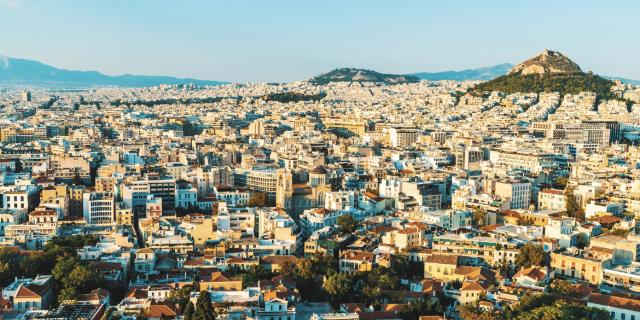
Traveling in Achaia
The apostle Paul was then escorted by some brothers more than 300 miles south, into the region of Achaia, reaching the city of Athens. When they arrived in Athens, the brothers headed back. Paul stayed in Athens, but told the brothers to tell Silas and Timothy that he wanted them to join him as soon as possible (Acts 17:15).
While Paul waited for Silas and Timothy, Paul’s “spirit was provoked within him” (Acts 17:16) because he saw an abundance of idols in the region.
Paul decided to make the best use of his time and talked with the Jews at the synagogue and preached to many Gentiles in the marketplace (Acts 17:17). Paul also talked with Epicurean and Stoic philosophers (Acts 17:18). They eventually brought Paul to the Areopagus, the court where men discussed philosophy, civics, and religion.
In the court of the Areopagus, Paul preached one of his most famous sermon (Acts 17:22-31). Paul’s sermons included quotes from famous Greek philosophers that they would have been familiar with. This gives us insights into Paul’s knowledge of their culture and insights into Paul’s missiology.
After hearing Paul’s sermon, there were some there who laughed at him, but there were also some who believed the gospel and joined Paul (Acts 17:32-34).
First Visit to Corinth
After leaving Athens, Paul traveled 53 miles southwest to Corinth. By this point in his second missionary journey, Paul had traveled more than 1,500 miles.
The apostle Paul probably arrived in Corinth apx. 8-12 months after the start of the second missionary journey, therefore, it’s likely that he got there sometime late in the year of 51 A.D. (or maybe sometime early in 52 A.D., depending on how we date his departure from Antioch in Syria). Paul stayed in Corinth for a year and a half (Acts 18:11), so Paul was likely in Corinth until the summer or fall of 53 A.D.
Silas and Timothy also rejoined Paul in Corinth.
While in Corinth, Paul met two Jews from Rome, Aquila and Priscilla. Like the apostle Paul, Aquila and Priscilla were also tentmakers. Paul stayed with them and worked while also going to the synagogues on the Sabbath to preach, seeking to convert both Jews and Greeks (Acts 18:1-4).
Paul faced some opposition from Jews in Corinth (Acts 18:5-9), but many people in the city believed anyway. Paul may have been considering leaving the city, but he stayed in Corinth after having received a vision from God that told him that “no one will attack or harm you” (Acts 18:10).
While in Corinth the apostle Paul wrote his letters to the Thessalonians, encouraging the new believers there to stand firm under the pressure and pain of persecution. He gives them instructions on how to live a godly lifestyle and gives doctrinal teaching about the future second coming of Christ.
Paul continued to preach the word of God faithfully for those 18 months. Many were saved and the church was established. But many Jews were upset.
The Jews of Corinth eventually tried to bring the apostle Paul before the Roman proconsul Gallio, who happened to be the older brother of the renowned dramatist and philosopher Seneca (the tutor of Emperor Nero). Gallio refused to even hear their case against Paul and sent them away (Acts 18:12-17).
Paul stayed in Corinth for “many days longer” (Acts 18:18) after being brought before Gallio. He then started his journey back home to Antioch in Syria, but planned to first make a stop in Ephesus. Priscilla and Aquila came with him.
Leaving from Cenchreae
Paul’s crew traveled to the nearby port city of Cenchreae, just eight miles from Corinth. We don’t know how long they stayed in Cenchreae, but they were there long enough for Paul to have his head shaved as part of a vow (Acts 18:18). It’s possible that this stop was very brief, but it’s also possible that they spent some time preaching and ministering there in the city.
There does seem to be some evidence that Paul spent some significant time in Cenchreae. But we cannot be certain. Also, we’re not sure if he spent time there during this second missionary journey or if that happened at a later time during his third missionary journey.
Brief Visit to Ephesus
When Paul arrived in Ephesus, he went into the synagogue to talk with the Jews about Jesus. His visit to Ephesus was brief. They requested that he stay in the city longer. He declined but said, “I will return to you if God wills” (Acts 18:21). Paul made plans to leave, but Priscilla and Aquila stayed in the city.
Paul traveled from Ephesus to Caesarea. Once he was there he visited with the believers in the region and preached the gospel in various towns and places. He briefly visited Jerusalem and then traveled back home to Antioch in Syria.
Paul’s second missionary journey lasted between two and a half years and three years, and likely ended back in Antioch sometime in the fall of 53 A.D. (or maybe early 54 A.D.).
Paul’s Third Missionary Journey
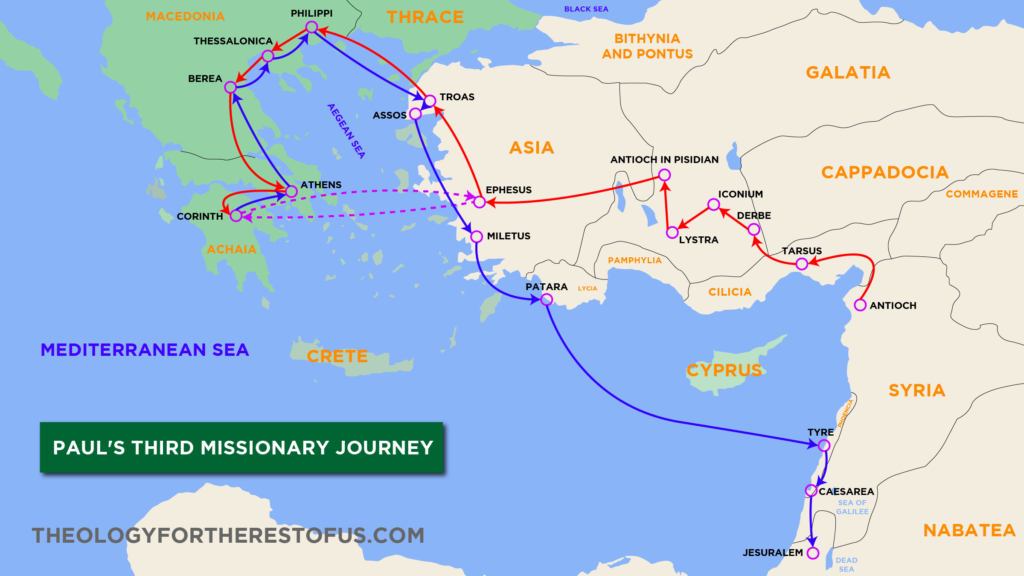
After getting back from his second missionary journey, the apostle Paul stayed Antioch for “some time” (Acts 18:23). Maybe just a few weeks or few months. He then launched his third missionary journey (Acts 18-21).
Paul likely left for his third missionary journey in the spring of 54 A.D. This third missionary journey was probably more than four years long and ended with Paul in Jerusalem in 58 A.D.
Galatia and Phrygia
Paul began his third missionary trip by visiting many of the same locations that he had visited on his first and second missionary journeys. We don’t know his exact route, but it’s likely he began by traveling through the region of Cilicia and through the city of Tarsus, on the way toward Galatia.
He spent several months traveling to the churches throughout the regions of Galatia and Phrygia, “strengthening all the disciples” (18:23). Paul passed through the “inland” route through Asia and traveled west to Ephesus (Acts 19:1).
Three Years in Ephesus
Paul spent three labor-intensive years in Ephesus (Acts 20:31). Paul was likely in Ephesus from the fall of 54 A.D. to the fall of 57 A.D.
Paul’s time in Ephesus was hard. He later says that he experienced many “afflictions” and he wasn’t confident that he would live through this season (2 Cor. 1:6-10). But God did many great things through Paul while he was in Ephesus.
For the first few months of Paul’s ministry in Ephesus, he spent time preaching in the synagogue. That was his focus. However there were many Jews stuck in unbelief, and they said evil things about Paul and the gospel message. So Paul decided to spend the last two and half years of his time in Ephesus preaching in the hall of Tyrannus, instead of the synagogue. He preached in the hall of Tyrannus daily and “all residents of Asia heard the word of the Lord” (Acts 19:10).
During Paul’s ministry, he performed many miracles in the name of Jesus, leading many to believe.
“God was doing extraordinary miracles by the hands of Paul… even handkerchiefs or aprons that had touched [Paul’s] skin were carried away to the sick, and their diseases left them and the evil spirits came out of them.” —Acts 19:11-12

God-Fearers Received the Holy Spirit
One of the most famous events from Paul’s time in Ephesus was when he corresponded with a group of disciples that had known about John’s baptism (referring to John the Baptist), but they did not know about Jesus (Acts 19:1-3). These types of believers were sometimes referred to as God-fearers.
These God-fearers had previously been taught by a great preacher named Apollos. He had taught them to revere the one true God, the God of Israel. But Apollos himself had not known about Jesus until after he had preached to this particular group of disciples. Apollos was later instructed by Paul’s friends, Priscilla and Aquila (Acts 18:24-28).
Paul taught this particular group about Jesus. They believed and received the Holy Spirit (Acts 19:4-7).
The Sons of Sceva
Another event that the book of Acts highlights, from Paul’s time in Ephesus, is about seven traveling Jewish exorcists, the sons of Sceva. These exorcists came across a demon-possessed man. They attempted to cast-out the demons (Acts 19:11-14). But one of the demons responded to them, “Jesus I know, and Paul I recognize, but who are you?” (Acts 19:15).
The demon-possessed man (under the control of the evil spirits) attacked the seven men and badly beat them (Acts 19:16). This caused many people in the region to respect Paul and his ministry. Many of the magicians in the area repented and burned their magic books (Acts 19:17-19) and “the word of the Lord continued to increase in the region” (Acts 19:20).
Demetrius, Riots, and Leaving Ephesus
Paul was planning to leave Ephesus. However, before he left Ephesus, a silversmith named Demetrius caused trouble. Demetrius made and sold idols. Paul preached against idolatry, so many people stopped buying Demetrius’ idols. This cost him money. Demetrius clearly was not happy.
There were other business owners that were also hurt financially because of Paul’s preaching. Many people had stopped buying their idols as they responded to the gospel. When these merchants got together, they started a massive riot in the city.
Paul wanted to go into the crowd to calm them down, but the disciples would not let him because they knew that Paul could get killed. Some of the Christians went into crowd and calmed the riot. Shortly after these riots, Paul set sail for Macedonia (Acts 19:21-20:1).

The “Painful” Visit
Paul had made plans to travel through Macedonia and then southward into Achaia (1 Cor. 16), which would likely include a visit to the church in Corinth.
At some point, Paul received some correspondence telling him that there were massive problems in the church of Corinth. How did Paul respond when he received this news? There are two main views from scholars.
View #1: Paul immediately changed plans and left from Ephesus to Corinth.
Some scholars argue that as soon as Paul received word that there were big problems in Corinth, Paul changed his plans and decided to visit the Corinthians immediately, skipping his original plans to travel through Macedonia.
Paul probably thought that once he was there in Corinth, that he’d be able to resolve the conflicts. But it seems that the exact opposite happened. Paul would later describe this visit as “painful” (2 Cor. 2:1). During this “painful” visit Paul was deeply hurt by someone in the church (2 Cor. 2:5).
The scholars that embrace View #1 say that Paul then left Corinth after this “painful visit” and headed back to Ephesus for a brief period of time.
It then appears that Paul was contemplating returning to Corinth, yet again, before heading over to Macedonia, but Paul ultimately decided against this additional visit, in order to “spare” the Corinthians (2 Cor. 1:23). Paul defends this decision in 2 Corinthians (vv. 1:12-2:2).
Paul then left from Ephesus to Macedonia (Acts 20:1). However, Paul would eventually make a third visit back to Corinth a few months later toward the end of this journey.
These scholars typically piece it all together like this:
- Paul (while in Ephesus) receives news of trouble in the church of Corinth and changes his plans
- Travels from Ephesus to Corinth for a second visit (known as the “painful” visit)
- Travels from Corinth back to Ephesus
- Contemplates another visit to Corinth, but decides against it
- Experiences the Demetrius-led riots in Ephesus
- Travels onto to Macedonia
- Goes from Macedonia down into Greece
- Eventually makes it back to Corinth (third overall visit)
Scholars that hold to View #1 assert that Paul ultimately made three total visits to Corinth; his first visit (the 18 months he spent there during his second missionary journey), the “painful” visit from Ephesus, and then a third visit toward the end of this third missionary journey.
View #2: Paul did not change his plans, but visited Corinth later.
Scholars that hold to View #2 say that Paul likely received some communication from Corinth (that there were indeed big problems in the church), but these scholars conclude that receiving this communication did not cause Paul to visit Corinth immediately.
The scholars that embrace View #2 argue that Paul did consider changing his plans, which would have consisted of a visit to Corinth before going through Macedonia, but these scholars argue that ultimately Paul decided against going to Corinth immediately, so he stuck to his plans to travel through Macedonia. They interpret Paul’s words in 2 Corinthians (vv. 1:12-2:2) as Paul giving a defense as to why he did not visit them.
These scholars say that eventually Paul did visit Corinth, a few months later, toward the end of his third missionary journey. Scholars that embrace View #2 often say that the word “painful” (2 Cor. 2:1) was not a description of an actual visit that ever happened, but that it was a description of the type of visit that would have ensued if Paul had indeed visited them. He knew that if he did visit, it would have been painful, so he sought to “spare” them (2 Cor. 1:23).
- Paul (while in Ephesus) receives news of trouble in the church of Corinth
- Contemplates an immediate visit to Corinth, but ultimately decides against it
- Goes from Ephesus to Macedonia
- Eventually travels to Corinth for his second visit
Scholars that hold to View #2 assert that Paul ultimately made two total visits to Corinth; his first visit (the 18 months he spent there during his second missionary journey) and then his visit to Corinth toward the end of this third missionary journey.
Leaving For Macedonia and the Sorrowful Letter
Paul leaves Ephesus and heads toward Macedonia. In the book of Acts, Luke gives us no details. He only says that Paul “departed for Macedonia” (Acts 20:1). However, by examining Paul’s letters, we get more insight into these travels.
It appears that, at some point during this journey, Paul had sent Titus to Corinth with a letter (this is sometimes referred to as the “sorrowful letter”). Paul later describes this “sorrowful” letter as having been written with “much affliction and anguish of heart and with many tears” (2 Cor. 2:4).
Some scholars contend that this “sorrowful letter” is the epistle that appears in the New Testament, that we know today as 1 Corinthians. Other scholars argue that the “sorrowful letter” is a separate correspondence that has been lost to history.
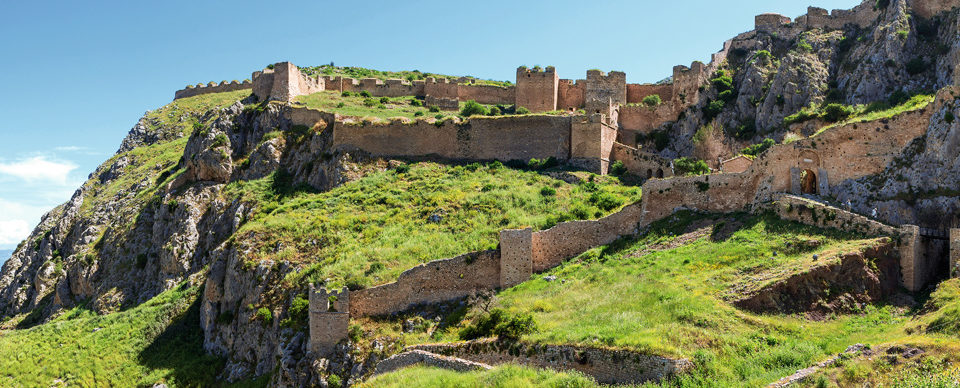
Ministry in Troas and Macedonia
On the way to Macedonia, Paul stopped in Troas to preach there and to await Titus’ return from Corinth. While waiting in Troas, Paul had great ministry opportunity. He called it an “open door” (2 Cor. 2:12).
However, when Titus’ return from Corinth appeared to be delayed, Paul was concerned for Titus’ safety. Paul decided to leave Troas and traveled to Macedonia to find Titus (2 Cor. 2:13).
Paul traveled throughout Macedonia, visiting the churches and friends in the region, and encouraging the believers in those churches (Acts 20:2).
Finally, while in Macedonia, Paul was reunited with Titus. Titus reported that many people in the church of Corinth had repented after hearing Paul’s letter (2 Cor. 2:5-11; 7:5-16). Paul was filled with joy.
However, Titus also reported that Paul’s opponents still wielded some influence over a small rebellious faction within the church questioning Paul’s authority and credibility. Paul responded to this faction by writing another letter (most likely from Philippi). This letter is in our New Testament, known today as 2 Corinthians.
Three Months in Greece
After these travels through Macedonia, the apostle Paul eventually traveled southward and finally arrived in Greece (i.e., Achaia). He stayed in the region for three months (Acts 20:2-3), including a lengthy stay in Corinth. This stay likely took place in late 57 A.D. or early 58 A.D.
While in Corinth, Paul wrote his theological masterpiece, the letter to the Romans.
As previously discussed in this article, some scholars believe that this was Paul’s second visit while others argue that this was his third visit.
Cenchreae and Phoebe
It’s also possible that during these three months in Achaia, Paul spent time in the nearby city of Cenchreae. In the book of Romans, Paul mentions Phoebe, a deaconess in the church of Cenchreae (Rom. 16:1).
Phoebe was the person that delivered Paul’s letter to the Romans, and Paul asked them to welcome her, praising her for being a “patron of many” (Rom. 16:2). It’s highly unlikely that Paul would have asked her to make this important delivery for him unless he knew her well and trusted her, pointing to the likelihood that Paul had spent time in Cenchreae before writing that letter.
As previously mentioned in this article, it’s also possible that Paul had spent some time in Cenchrea during his second missionary journey as well as this third missionary journey.
One More Lap Through Macedonia
After his time in Achaia, Paul had originally intended to sail directly to Jerusalem. Those plans were changed, however, when it was discovered that some of Paul’s opponents had been plotted against him. Paul decided to take another lap through Macedonia instead (Acts 20:3).
Paul had many companions with him, from various churches, which gave him protection while he traveled through Macedonia (Acts 20:4-5).
Throughout the spring of 58 A.D., Paul traveled through the Macedonian region, visiting towns such as Berea and Thessalonica, and eventually ending up in Philippi (again) during the “days of unleavened bread” (Acts 20:6).
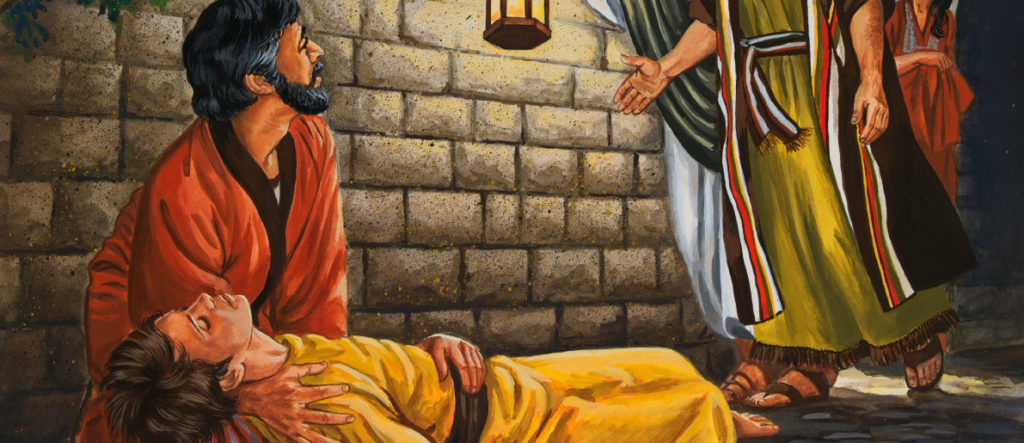
Eutychus Raises from the Dead at Troas
Paul and his companions then traveled to Troas (Acts 20:5). He ministered there again for a week. It was in Troas that a young man, Eutychus, was listening to one of Paul’s sermons and fell three stories out a window. When they found him he was dead on the ground, but Paul supernaturally restored life to this man (Acts 20:6-12).
After Troas, Paul’s companions went by ship to Assos, but Paul went by foot. Luke doesn’t tell us precisely why Paul did this. But what we do know is that distance from Troas to Assos was more than 30 miles through dangerous and mountainous terrain.
After meeting with his companions in Assos, they began their trek to Jerusalem. They made briefs stops in Chios and Samos, before arriving in Miletus (Acts 20:15).
Goodbye to the Ephesian Elders
It would make sense that Paul would have wanted to stop in Ephesus before heading to Jerusalem. considering the dear friends he had there, but he intentionally passed Ephesus because he wanted to be in Jerusalem by Pentecost, and he knew that traveling through Ephesus, and staying in Asia, would take much more time than he desired. In addition, he knew visiting Ephesus again could cause an uproar (Acts 20:13-16).
However, Paul did want to see his Ephesian friends and ministry partners, so when he arrived in Miletus, Paul called the elders from Ephesus to meet him there (Acts 20:17). In Miletus he encouraged the elders and commended them, letting them know that he would not be seeing them again since he knew that imprisonment and maybe death waited for him in Jerusalem. This was, no doubt, an emotional moment for Paul and his friends.
Paul had spent several years laboring with these men in ministry, and now he was saying goodbye for, what appeared to be, the last time. They wept and prayed together (Acts 20:17-38).
Sailing for Syria
From there, the apostle Paul and his companions then sailed towards Syria. They made brief stops in Cos, Rhodes, and Patara, before finally coming to Syria, landing at Tyre (Acts 21:1-3). Paul and his companions spent seven days with the disciples in Tyre. Through “the Spirit” they told Paul not to go onto Jerusalem, but Paul sensed that Jerusalem was the right place to go (Acts 21:4).
Then Paul and his companions went to Ptolemais (Acts 21:7), spending one day with the believers there, before heading onto Caesarea. There they were greeted by the believers there and they stayed with Philip the evangelist (Acts 21:8). While they were there, a prophet named Agabus came down from Judea and told Paul of the coming affliction he would face in Jerusalem (Acts 21:10-12).
Despite many people again urging Paul not to go to Jerusalem, Paul told them he knew what was instore and that he was ready to die.
Then Paul answered, ‘What are you doing, weeping and breaking my heart? For I am ready not only to be imprisoned but even to die in Jerusalem for the name of the Lord Jesus.’ —Acts 21:13
Paul and his companions then traveled to Jerusalem and was greeted by his brothers in Christ who lived there. He told the church there all God had been doing among the Gentiles (Acts 21:14-16). Once there, Paul visited with James and all the elders (Acts 21:17-18). He told them about all that God had done throughout the Gentiles.
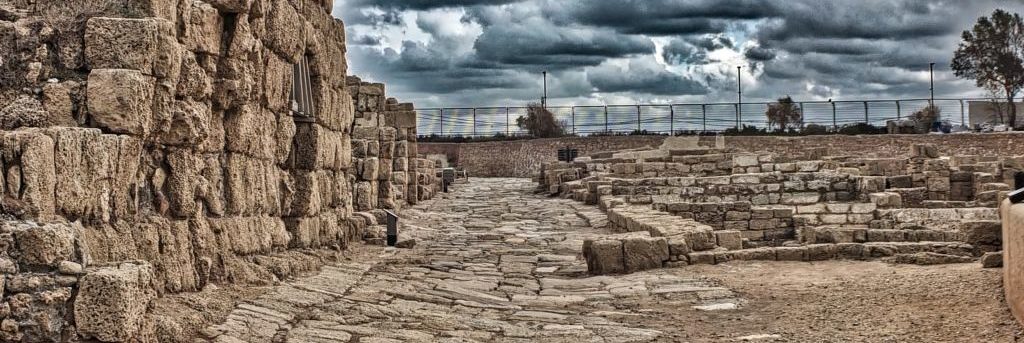
Arrested in Caesarea
While in Jerusalem, Paul went to the temple to worship and pray. While he was there, some Jews from Asia Minor stirred up trouble for Paul. They accused him of abandoning the one true God of Israel, of maligning the law of Moses, and of encouraging people to disobey the Jewish laws. Paul (obviously) denied this charge. This confrontation caused a riot in the temple. Paul was dragged out of the temple by a mob. The Romans then intervened and took Paul into custody (Acts 21:27-36).
Paul then addressed the crowd. He made it clear that he loved the law of God and that he had previously been a persecutor of Christians. But that he had become a preacher of the gospel after meeting Jesus on the road to Damascus. This caused another riot to erupt. The Romans then took Paul in their barracks. The Romans were going to flog him but Paul appeals to his own Roman citizenship (Acts 21:37-22:29).
On Trial Before Felix
Paul is taken to the Roman barracks in Caesarea. During this time the Roman governor over the region, Felix, brought Paul to trial. Ananias, the high priest, came from Jerusalem to bring charges against Paul. Felix gave Paul the opportunity to speak before the crowd. Paul shares his story and preaches truth. Felix was afraid of Paul’s message, so he doesn’t seemingly know what to do with Paul (Acts 23:23-35; 24:1-27).
Paul was imprisoned in Caesarea by the Romans for two years, but was given “some freedom” and his friends are allowed to visit him “to take care of his needs” (Acts 24:23).
On Trial Before Festus and Agrippa
When Festus became the governor of the region in 60 A.D. (or maybe earlier in 59 A.D.), he brought Paul back to trial. Some Jews came from Jerusalem again to bring charges against Paul, but they could not prove any of those charges (Acts 25:1-12).
King Herod Agrippa II visited with Festus. Festus asked him to hear Paul’s case. When Paul is called to defend himself, he gives one of his most famous defenses of the gospel and even encourages Agrippa to believe in Jesus (Acts 26:1-29). Agrippa famously responds, “Do you think that in such a short time you can persuade me to be a Christian?” (Acts 26:28). Paul says that he wants everyone to believe.
Festus calls Paul crazy (Acts 26:24), but both he and Agrippa agree that Paul had not done anything that might “deserve death or imprisonment” (Acts 26:31). Paul could have simply “been set free if he had not appealed to Caesar” (Acts 26:32). Paul had appealed to Caesar under his rights as a Roman citizen. This set into the motion the plans for Paul to be transported from Palestine to Rome to face trial in Caesar’s court.
Journey to Rome
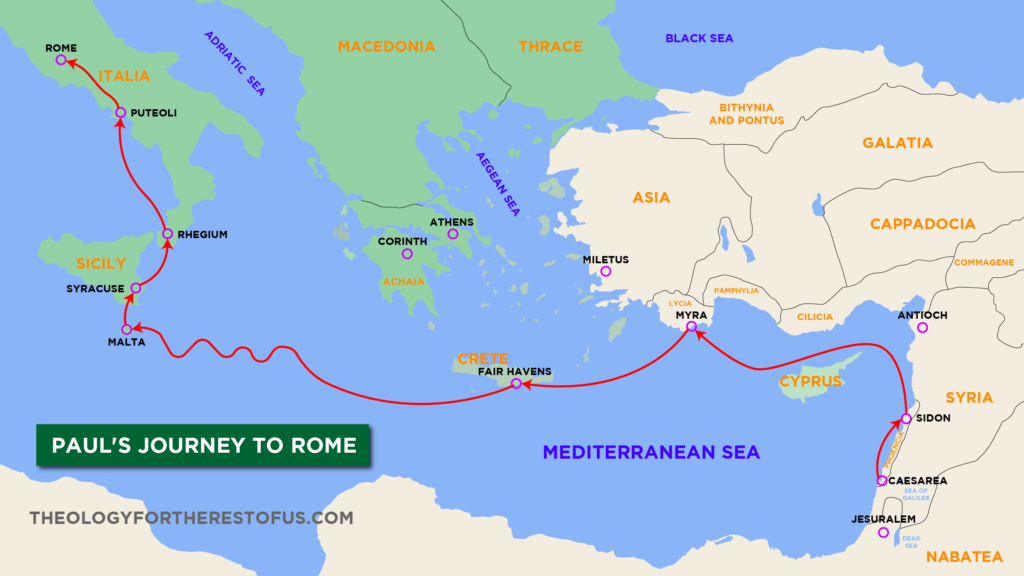
After his appeal to Rome, the apostle Paul is transported from Caesarea to Rome by ship under Roman guard (Acts 27:1-28:10). Some Bible scholars allude to this journey as Paul’s fourth missionary journey, but I don’t believe that’s the best or most accurate description for this trip.
Paul’s trip to Rome was tumultuous, filled with difficulties, including a shipwreck that caused him to be deserted on the island of Malta for three months. He also consistently faced belligerent resistance from people that opposed the gospel.
Paul and his companions eventually made it to Rome, sometime around 61 A.D. (or maybe somewhat earlier). When Paul arrived in Rome, he was placed under house arrest for two years.
Paul lived in a rented house where he served his house arrest. There he is able to visit with friends and preach the gospel to those who visit. During this time he also writes several letters that are now in the New Testament, including Philippians, Ephesians, Colossians, and Philemon.
The book of Acts ends there, with Paul under house arrest in Rome (Acts 28:11-31).
Paul’s Fourth Missionary Journey
The fourth missionary journey is not outlined in the narratives of Scripture. And there are some scholars that question whether such a journey ever really happened (we’ll cover that a bit more later in this article).
We don’t have a clear picture of what happened next in Paul’s life, after he was released from house arrest. But by carefully examining Paul’s epistles, I’m confident we can piece-it-together.
The early church father and historian Eusebius (writing in the 4th century) recorded that the most prominent church tradition had been that Paul was released from Roman house arrest and then re-arrested several years. According to this tradition, Paul’s second arrest eventually led to his martyrdom under the direction of Emperor Nero (see H.E. 2.22.6 ).
Also, Paul’s later letters (1 & 2 Timothy and Titus), commonly referred to as the Pastoral Epistles, are clearly written after the events of the book of Acts. In those letters Paul makes comments about his travels and plans. Paul is likely released from house arrest sometime around 63 A.D.
During his house arrest in Rome, Paul was clearly making plans to travel eastward. He asks Philemon to prepare a guest room for him (Philemon 22) and tells the Philippians that he intends to visit them (Phil. 2:24). Paul doesn’t strike me as the type of guy that would make plans in vain. Paul anticipated his release from house arrest.
These plans to go east make perfect sense. Paul’s habit was to go back and encourage the churches that he had previously established. That’s what he’d done on previous journeys.
Then, in 2 Timothy, written much later in life, during Paul’s second imprisonment, Paul mentions and alludes to people and moments that are connected to his post-Roman arrest ministry travels through Asia. He’s sort of looking back on past events and correspondences. Paul mentions:
- Having a significant dispute with some believers in Asia, including Phygelus and Hermogenes (2 Tim. 1:15)
- Receiving help from Onesiphorus (2 Tim. 1:18)
- Having been with Carpus at Troas (2 Tim 4:13-14)
- Being confronted by Alexander the coppersmith (2 Tim. 4:14)
- Needing to leave Trophimus in Miletus because he was ill (2 Tim 4:20)
All of these events happened after Paul’s release from Roman house arrest.
Paul says in 2 Timothy 4:20 that “Erastus remained at Corinth.” This is a clear statement that Paul had been in Corinth; he knew Erastus was there because he had first-hand knowledge, having recently visited the city.
In Titus 3:12, Paul invites Titus to join Paul in Nicopolis. Paul tells Titus that he plans on spending the winter in Nicopolis, a city in Achaia. Clearly, when Paul writes the letter to Titus he is already in Achaia or somewhere very close, hoping for Titus to meet him there.
In Paul’s letter to Titus, he alludes to having been in Crete and having left Titus in charge to help those churches flourish.
A few scholars have argued that Paul did ministry in Crete when he was shipwrecked there. Paul had been briefly shipwrecked in Crete while traveling from Caesarea to Rome, before his Roman house arrest (Acts 27).
However, Paul and the men from the shipwreck were in Crete just a short while. As we examine the events of the shipwreck, as they are described in the book of Acts, we see that Paul would not likely have had the opportunity to establish churches in the region during such a short period. Also, they didn’t travel throughout the island at all.
What seems much more likely is that Paul eventually made it back to the island of Crete, spend time preaching, establishing churches throughout the region, and that upon his departure Paul left Titus there to “complete [their] work there and appoint elders in each town” (Titus 1:5).
At the beginning of 1 Timothy Paul says “when I was going to Macedonia” (1 Timothy 1:3). When we examine this letter, we get the sense that he’s referring to events in the not-too-distant past. Seems likely Paul is referring to the moment when he had traveling to Macedonia after being released from Roman house arrest. After his time spent in Macedonia, he may have headed back to the church in Ephesus, which he asserted was his plan (1 Timothy).
Doubts about the Fourth Journey
There are clearly some comments in Paul’s letters that do not easily square with the events of the book of Acts, which means that those comments in his letters point to some missionary work that happened after Paul’s Roman house arrest.
However, a few scholars have argued that there’s significant (enough) overlap in the locations, types of events, and even the people mentioned during Paul’s first three journeys, therefore it’s hard to say for sure—they claim it’s possible that much of those things that do not seem to square with the events of the book of Acts can still potentially be things that happened on one of his first three missionary journeys.
Also, some scholars have sought to remind us that the apostle Paul spent long periods of time in some locations (like 18 months in Corinth and 3 years in Ephesus), and they’ve asserted it’s possible that many unrecorded things may have happened during those long stays, implying that those longer stays in those locations could account for some of the comments in Paul’s epistles.
These scholars claim there’s so much that we do not know about those time periods, that it’s entirely possible all of the events alluded to by Paul, in his own letters, took place during his first three journeys.
I happen to be confident that Paul did indeed take a fourth missionary journey, after his release from his Roman house arrest. I think that’s the best interpretation of the data we have. However, I also realize that there are some good New Testament scholars that don’t find the evidence as compelling as I do.
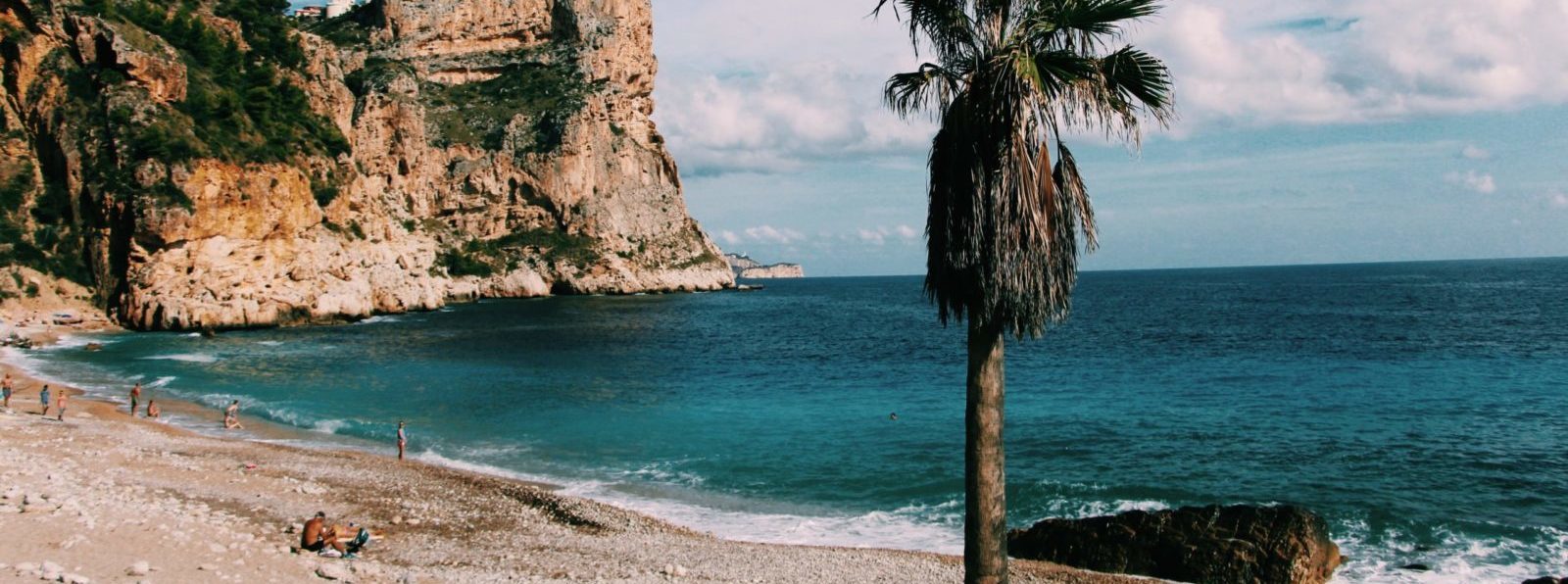
Potential Travel to Spain
Did Paul ever make it to Spain? We know from Scripture that the apostle Paul had a desire to preach in Spain (Rom. 15:22-29). After being released from Roman house arrest, he could have easily sailed westward.
Clement of Rome (writing in 95 A.D.) says that Paul had traveled and preached in “the farthest limits of the West” (1 Clement 5:5-7). This sort of language could have described a location west of Italy, such as Gaul or Britannia, but most scholars seem to think this describes Spain. However, it is also possible that Clement was speaking more broadly (or generically), referring to Paul traveling far westward from his home region, going from Palestine through much of the heart of the Roman Empire and eventually all the way to Rome. This latter interpretation seems odd to me.
The Muratorian fragment (written in apx. 170 A.D.), seems to affirm Paul’s missionary journey to Spain too, but some scholars question this; just because someone in the mid-to-late second century believed it doesn’t necessarily equate to strong evidence. However, this shows that church tradition was handing this down through the generations.
Paul’s missionary trip to Spain is also mentioned by Cyril of Jerusalem (313-386) and John Chrysostom (347-407).
There may not seem to be many significant (quality) pieces of evidence that corroborate the idea that Paul made it all the way to Spain, and there are not any comments in Paul’s later letters that point to him ever making it to Spain either. However, these extrabiblical evidences seem compelling. It’s possible that a trip to Spain may have been the first leg of Paul’s fourth missionary journey.
Paul Beheaded by Nero
In his second letter to Timothy, Paul mentions his “first defense” and says he was “delivered from the lion’s mouth” (2 Tim. 4:16-17). Most biblical scholars believe this is a reference to the first time he was in Caesar’s court, defending himself, eventually leading to his Roman house arrest (Acts 28).
Paul was released from his first Roman arrest, but there wouldn’t be a second release. Paul eventually ended up back in Rome. The second time, it wasn’t house arrest. It was a real Roman jail. This was most likely part of Nero’s persecution of Christians in the mid 60s. This was one of the most brutal times of persecution in Christian history.
When much of the city of Rome burndown in 64 A.D., Emperor Nero blamed the Christians. The emperor later requested that the apostle Paul be arrested and chained. It appears that Paul was arrested somewhat abruptly and unexpectedly, evidenced by the fact that he was not able to secure his cloak and his Old Testament parchments; Paul later requested that these be brought to him (2 Tim. 4).
Paul likely penned 2 Timothy during this second Roman imprisonment. Paul was beheaded shortly after he wrote 2 Timothy. Some scholars have concluded that Paul was killed as early as 64 A.D., but it is more likely that he was executed sometime between 67 A.D. and 68 A.D.
The legacy of the apostle Paul is second to none in Christian history. He is the greatest missionary evangelist the world has ever seen. Paul was a man on mission, focused on spreading the gospel and planting churches.
Paul was a man so impacted by Jesus, so compelled by God’s love, so humbled that the Messiah would choose him to be an ambassador, that he was willing to endure much pain and hardship to see others come to faith in Jesus Christ.
Featured illustration of Paul in prison courtesy of britannica.com. Images of the jails in Philippi and Caesarea courtesy of missionbibleclass.org. Illustration of Eutychus’ death courtesy of gfbtkingdomkids.com.
Recommended Resources:
“Handbook on Acts and Paul’s Letters” (by Thomas R. Schreiner)
“Paul: A Biography” (by N.T. Wright)
“Acts: An Expositional Commentary” (by R.C. Sproul)
“Dictionary of Paul and His Letters” (more than 100 contributors, edited by Gerald Hawthorne, Ralph Martin, and Daniel Reid)

Kenneth E. Ortiz (Th.M.) is Lead Pastor of Horizon City Church . He has 15+ years of vocational ministry experience. Kenneth previously served as a professor at Bethlehem College and adjunct faculty at Spurgeon College . Kenneth lives in Minneola, FL with his wife Malaina, they have two kids.
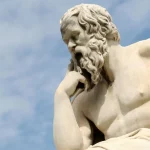
- Log In Sign Up
- Read the Bible
- Bible Versions
- Verse of the Day
- Reading Plans
- Verses by Topic
- Books of the Bible
- Bible Images
- Commentaries
- Concordances
- Dictionaries
- Encyclopedias
- Bible Atlas & Maps
- Devotionals
- Today's Devotionals
- Light of the World
- All Devotionals
- Inspirational Quotes
- Picture Quotes
- Inspirational
- Bible Study
- What The Bible Says
- Bible Q&As
- Daily Bread
- Bible by Genre
- Bible Stories
- Random Bible Verse
Life of Apostle Paul – Second Missionary Journey
Apostle Paul’s second missionary journey is recorded in Acts 15:36-18:22 . It took place from 49 AD to 52 AD.
The second missionary journey began with an unfortunate disagreement between Paul and Barnabas, which resulted in their separation, Barnabas going to the island of Cyprus, and Paul to the mainland. ( Acts 15:36-40 )
The apostle chose as his companion Silas, or Silvanus, and was afterward joined by Timothy, and Luke, the author of the third Gospel and the Acts. We may subdivide this journey into three sections, as follows:
I. The Stations in Asia, seven in number. II. The Stations in Europe, eight in number. III. The Stations of the Return, four in number.
Date : 49 AD to 52 AD Companion : Silas, Timothy and Luke Places that Paul visited (in chronological order):
The Stations in Asia: Jerusalem ( Acts 15:22 ) -> Antioch ( Acts 15:35 ) -> Syria ( Acts 15:41 ) -> Cilicia ( Acts 15:41 ) -> Derbe ( Acts 16:1 ) -> Lystra ( Acts 16:1-4 ) -> Phrygia, probably Iconium and Antioch in Pisidia ( Acts 16:6 ) -> Galatia ( Acts 16:6 ) -> Troas ( Acts 16:6-8 )
The Stations in Europe: Neapolis ( Acts 16:11 ) -> Philippi ( Acts 16:16-40 ) -> Amphipolis ( Acts 17:1 ) -> Apollonia ( Acts 17:1 ) -> Thessalonica ( Acts 17:1-9 ) -> Berea ( Acts 17:10-13 ) ->Athens ( Acts 17:15-34 ) -> Corinth ( Acts 18:1-18 ) -> Cenchrea ( Acts 18:18 )
The Stations of the Return: Ephesus ( Acts 18:19-21 ) -> Caesarea ( Acts 18:22 ) -> Jerusalem ( Acts 18:22 ) -> Antioch ( Acts 18:22 )
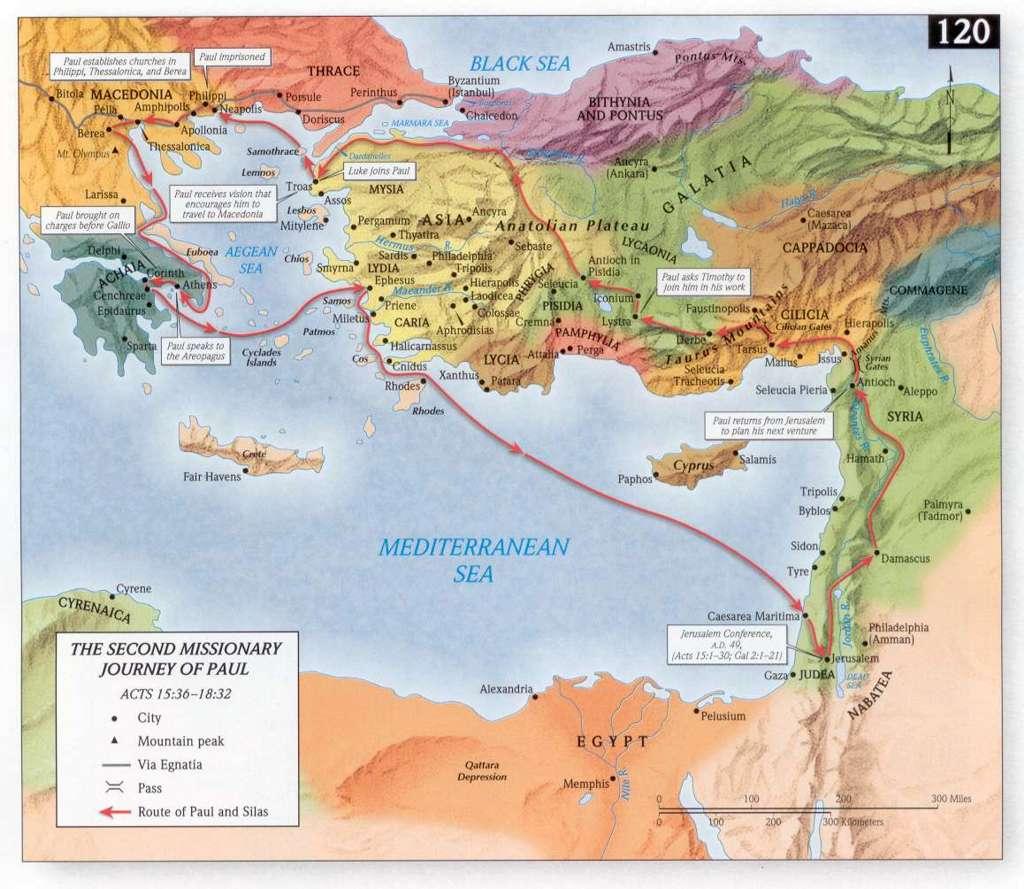
I. The Asiatic Stations
These are mostly the names of provinces in Asia Minor already described in connection with a previous map.
1. Starting from Antioch , Paul first traveled through Syria , visiting the churches. ( Acts 15:41 )
This tour was probably through northern Syria only, in the region around Antioch; and the general direction was toward Asia Minor, which he probably entered through the Syrian Gates, now the Beilan Pass in Mount Amanus. No cities are named in this region as visited by the apostle; but the principal places were Issus and Alexandria, both of which lay along the route of his journey.
2. The next province visited was Cilicia ( Acts 15:41 ), the land of Paul’s birth.
As everywhere he made the chief cities his stations of labor, we may suppose that he passed through Mopsuestia and Adana, on his way to Tarsus, the metropolis of the province. From Tarsus he journeyed westward toward Mount Taurus, the northern boundary of the province, and crossed the range through the Cilician Gates, from which he emerged upon the great Lycaonian plain.
3. We read of a station at Derbe , where he had planted a church on the first journey, and which was now strengthened by his second visit. ( Acts 16:1 )
4. Next, at Lystra , where in other days he had been first worshiped and then stoned. Here he found a church, the result of his early labors, and was joined by his life-long companion, Timothy. ( Acts 16:1-4 )
5. We read of Paul and Silas as having next “gone throughout Phrygia .” ( Acts 16:6 ). Probably this refers to a tour among the churches at Iconium and Antioch in Pisidia, the fields of former labors. There is no indication in the Acts or Epistles that he preached in any new places in this district.
6. From Antioch he turned northward and entered for the first time the province of Galatia. ( Acts 16:6 )
But W. M. Ramsay has shown that Lycaonia itself was only a district in the political province of Galatia, and that the Galatian journey (and also the Galatian epistle) may refer to the region of Derbe, Lystra, and Iconium, not to the entire province. In that case the dotted red line on the map may indicate Paul’s journey, and the line through Pessinus, Ancyra, and Tavium should be omitted.
These conclusions are not, as yet, generally accepted.
7. Paul’s desire was to preach the word throughout the Roman proconsular province of Asia, which comprised Phrygia, and the maritime districts of Mysia, Lydia and Caria. But divine influences closed up his path, both in this direction and northward toward Bithynia; so he journeyed westward across Phrygia and Mysia, and at last reached at Troas . ( Acts 16:6-8 .)
This was the site of ancient Troy, the scene of Homer’s Iliad, and has been the place of great discoveries in modern times. There was a city near the ancient site in Paul’s time; and it is probable that in it he founded a church, for there he was joined by Luke, the historian of the Acts and author of the third Gospel, and in a later journey met “the disciples” of the place. ( Acts 20:7 .)
Here the vision of the “man of Macedonia” summoned Paul from Asia to Europe ( Acts 16:9-10 ), and opened a new chapter in the history of Christianity.

II. The European Stations
All the places named as visited by the apostle in this journey were included in the two provinces of Macedonia and Greece, of which the Roman name was Achaia.
Macedonia was the province north of Greece, and famous in history from its conquering kings, Philip, and his greater son, Alexander. It consists of two great plains, watered respectively by the Axius, near Thessalonica, and the Strymon, near Apollonia. Between these two rivers projects a peninsula, having three points, like a hand of three fingers, across the palm of which, in Paul’s time, ran the great Roman road known as the Ignatian Way. It was divided by the Romans into four districts, of which the capitals were Amphipolis, Thessalonica (the residence of the provincial proconsul), Pella (the birthplace of Alexander the Great), and Pelagonia. Of these, Amphipolis had become less important than the rival city of Philippi , in the same district.
Achaia was the Roman name of the little land of Greece, whose fame has filled all history. In the later period of its independence, its ruling state had been Achaia, which gave its name to the entire province when annexed to the Roman empire. In the apostolic age, Corinth was its metropolis and political capital, though Athens still retained its fame as a centre of art and literature.
The apostle Paul and his companions sailed across the Ægean Sea from Troas, in a northwesterly direction, passing the storied isles of Tenedos and Imbros; anchored for the first night off Samothracia , “the Thracian Samos,” a rocky island near the coast of Thrace; and the next day passed northward of Thasos, and anchored in the harbor of Neapolis , on the border of Thrace. Acts 16:11
They did not remain at the seaport, but pressed inland to the larger city, which was to be memorable as the first foothold of the gospel in Europe. In the European part of the second missionary journey we notice eight places visited by the apostle.
1. Philippi ( Acts 16:12-40 ).
This was an ancient town, enlarged and renamed by Philip, the father of Alexander the Great. Near it was fought the great battle between Augustus and Antony on one side, and Brutus and Cassius on the other, in which the hope of a Roman republic perished, and the empire was ushered in. It had been made a colony; that is, a branch of Rome itself, and enjoyed certain privileges of self-government, so that its magistrates bore Roman titles, as noticed by Luke.
Here Lydia , the first convert in Europe, was baptized, and a church was planted; Paul and Silas were scourged and imprisoned, and set free by divine power; the jailer was brought to Christ; and the officials of the city were made to tremble at having inflicted violence upon citizens of Rome.
2. Amphipolis was 33 miles southwest of Philippi, and 3 miles from the Ægean Sea. It was a town of ancient fame; but, in Paul’s time, decayed in population; and, having no synagogue or Jewish population, was not yet made a field of his labors. After a delay of only a day, he journeyed on still further westward. ( Acts 17:1 )
3. Apollonia was 30 miles from Amphipolis, and an important city; but for some reason Paul did not choose to labor in its vicinity, and remained there but a day. ( Acts 17:1 )
4. Thessalonica ( Acts 17:1-9 ) was the capital of the entire province, and 40 miles from the preceding station. It was named after a sister of Alexander the Great, and had many historic associations. An arch is still standing, and was doubtless seen by the apostle, which commemorated the victory at Philippi.
There was a large Jewish population, and a synagogue, in which Paul preached for three sabbaths. He succeeded in founding a church, mostly of Gentiles, to which he soon after wrote his two earliest epistles, First and Second Thessalonians. But the Jews excited a riot, and the apostles were compelled to leave the city by night. Thessalonica, now called Saloniki, is still the second city of European Turkey, and contains 80,000 inhabitants.
5. Berea ( Acts 17:10-13 ) was a small city, chosen by the apostle on account of its retired situation. It lay on the eastern side of Mount Olympus. Its people were generous in hearing the truth, and candid in examination of its claims; so that many of them believed, and “the Bereans” have furnished a name for earnest students of the Bible in all lands. The place is now called Verria, and has a population of about 6,000.
6. Athens ( Acts 17:15-34 ) was one of the most famous cities of the world. It was situated 5 miles northeast of the Saronic Gulf, between the two little streams Cephissus and Ilissus, and connected by long walls with its two seaports, the Piræus and the Phaleric Gulf, where probably Paul landed. Around it stand mountains noted in history, and within its walls rise four important hills: the Acropolis, surmounted by the Parthenon, the most perfect specimen of Greek architecture; the Areopagus, northwest of the Acropolis, where Paul delivered his memorable discourse; the Pnyx, still further west; and, on the south, the Museum. In Paul’s time Athens was no longer the political capital, but was still the literary centre, not only of Greece, but of the civilized world. Paul’s discourse before its philosophers was not attended with immediate results, as no church appears to have been founded; but, four centuries afterward, the Parthenon became a Christian church, and the Athenians were among the most bitter foes of image worship. After many changes of fortune—at times being without inhabitants—Athens is now the growing capital of the kingdom of modern Greece, and the seat of a university.
7. Corinth ( Acts 18:1-18 ), the next station of the apostle, was 40 miles west of Athens, on the isthmus between Hellas and Peloponnesus, which is here 10 miles wide. In Paul’s time it was the commercial and political metropolis of Greece, being the residence of the Roman proconsul. It was, however, a most wicked city, and a by-word for corruption and licentiousness. Paul preached in Corinth for a year and a half, working meanwhile at his trade as a tent-maker, and during his stay wrote the two Epistles to the Thessalonians. After leaving, he wrote to the Corinthian Christians two of his longest Epistles, First and Second Corinthians. The site of the city is now desolate, except for a small and wretched village, named Gortho.
8. Cenchrea ( Acts 18:18 ), more accurately Cenchreæ, is named merely as the place from which Paul set forth on his return journey, and where he performed the Levitical service of cutting off his hair in token of a vow. We know, however, that he had, directly or indirectly, planted a church here, as its deaconess, Phebe, is named. ( Rom. 16:1, 2 .) This was the eastern harbor of Corinth, on the Saronic Gulf, 9 miles from the city. It is now called Kekhries.
III. The Return Stations
In his journey from Corinth to Antioch, are given as four in number, though the journey was more than a thousand miles in length.
1. Sailing eastward across the Ægean Sea, and passing many celebrated islands, after a voyage of 250 miles, he reached Ephesus . ( Acts 18:19-21 .) He had been hindered from preaching in this region before, and now remained but a few weeks, though urged by the Jews to remain longer. He left behind him his friends Aquila and Priscilla, by whose labors the brilliant young Apollos of Alexandria was led into the church, and the way was prepared for Paul’s labor on his second visit, in connection with which Ephesus will be noticed again.
2. A voyage around the southwestern border of Asia Minor, thence past the isle of Rhodes in a southeasterly direction, leaving Cyprus on the northeast, brought the apostle to Caesarea ( Acts 18:22 .) This was the Roman capital of Palestine, and a harbor. Here Paul debarked from the vessel on which he had sailed 600 miles, and entered once more the Holy Land.
3. Jerusalem . ( Acts 18:22 ) The apostle climbed the mountains, and for the fourth time since his conversion entered the Holy City. He stayed only to salute the church, and perhaps leave the gifts of the Gentile Christians to the poorer saints of Judea, and then left once more.
4. He traveled, overland most probably, to Antioch, his home, if any place might be so named; for here were his nearest friends, here he had begun his missionary journey, and here he doubtless received a glad welcome from the church. He brought with him, on his return, not only Silas, who had set out as his companion, but Timothy, and perhaps also Aristarchus, Gaius and Erastus, whose names we find associated with Paul’s soon after.
Related Topics
Be the first to react on this!
Get Bible verse every day in your inbox
Read on Mobile
Group of Brands

- Statement of Faith
- Privacy Policy
- Terms and Conditions
- Permissions Policy
- BP ScriptureTagger
- VotD RSS Feeds
- Article RSS Feeds
6200 2nd St NW Washington, DC 20011
on to Part 5, Acts 18:23b-20 - Paul's Third Missionary Journey OR back to J B Phillips New Testament
15:40-41 - ..... while Paul chose Silas and set out on his journey , commended to the grace of the Lord by the brothers as he did so. He travelled through Syria and Cilicia and strengthened the churches. CHAPTER 16 Paul chooses Timothy as companion 16:1-5 - He also went to Derbe and Lystra. At Lystra there was a disciple by the name of Timothy whose mother was a Jewish Christian, though his father was a Greek. Timothy was held in high regard by the brothers at Lystra and Iconium, and Paul wanted to take him on as his companion. Everybody knew his father was a Greek, and Paul therefore had him circumcised because of the attitude of the Jews in these places. As they went on their way through the cities they passed on to them for their observance the decisions which had been reached by the apostles and elders in Jerusalem. Consequently the churches grew stronger and stronger in the faith and their numbers increased daily. Paul and Silas find their journey divinely directed 16:6-9 - They made their way through Phrygia and Galatia, but the Holy Spirit prevented them from speaking God's message in Asia. When they came to Mysia they tried to enter Bithynia, but again the Spirit of Jesus would not allow them. So they passed by Mysia and came down to Troas, where one night Paul had a vision of a Macedonian man standing and appealing to him in the words: "Come over to Macedonia and help us!" 16:10 - As soon as Paul had seen this vision we made every effort to get on to Macedonia, convinced that God had called us to give them the good news. The Gospel comes to Europe: a business-woman is converted 16:11-15 - So we set sail from Troas and ran a straight course to Samothrace, and on the following day to Neapolis. From there we went to Philippi, a Roman garrison-town and the chief city in that part of Macedonia. We spent some days in Philippi and on the Sabbath day we went out of the city gate to the riverside, where we supposed there was a place for prayer. There we sat down and spoke to the women who had assembled. One of our hearers was a woman named Lydia. (She came from Thyatira and was a dealer in purple-dyed cloth.) She was already a believer in God, and she opened her heart to accept Paul's words. When she and her household had been baptised, she appealed to us, saying, "If you are satisfied that I am a true-believer in the Lord, then come down to my house and stay there." And she insisted on our doing so. Conflict with evil spirits and evil men 16:16-18 - One day while we were going to the place of prayer we were met by a young girl who had a spirit of clairvoyance and brought her owners a good deal of profit by foretelling the future. She would follow Paul and the rest of us, crying out, "These men are servants of the most high God, and they are telling you the way of salvation." She continued this behaviour for many days, and then Paul, in a burst of irritation, turned round and spoke to the spirit in her. "I command you in the name of Jesus Christ to come out of her!" 16:19-21 - And it came out immediately. but when the girl's owners saw that their hope of making money out of her had disappeared, they seized Paul and Silas and dragged them before the authorities in the market-square. There they brought them before the chief magistrates, and said, "These men are Jews and are causing a great disturbance in our city. They are proclaiming customs which it is illegal for us as Roman citizens to accept or practise." 16:22-24 - At this the crowd joined in the attack, and the magistrates had them stripped and ordered them to be beaten with rods. Then, after giving them a severe beating, they threw them into prison, instructing the jailer to keep them safe. On receiving such strict orders, he hustled them into the inner jail and fastened their feet securely in the stocks. The midnight deliverance: the jailer becomes a Christian 16:25-28 - But about midnight Paul and Silas were praying and singing hymns to God while the other prisoners were listening to them. Suddenly there was a great earthquake, big enough to shake the foundations of the prison. Immediately all the doors flew open and everyone's chains were unfastened. When the jailer woke and saw that the doors of the prison had been opened he drew his sword and was on the point of killing himself, for he imagined that all the prisoners had escaped. But Paul called out to him at the top of his voice, "Don't hurt yourself - we are all here!" 16:29 - Then the jailer called for lights, rushed in, and trembling all over, fell at the feet of Paul and Silas. 16:30 - He led them outside, and said, "Sirs, what must I do to be saved?" 16:31 - And they replied, "Believe in the Lord Jesus and then you will be saved, you and your household." 16:32-34 - Then they told him and all the members of his household the message of God. There and then in the middle of the night he took them aside and washed their wounds and he himself and all his family were baptised without delay. Then he took them into his house and offered them food, he and his whole household overjoyed at finding faith in God. Paul, in a strong position, makes the authorities apologise 16:35-36 - When morning came, the magistrates sent their constables with the message, "Let those men go." The jailer reported this message to Paul, saying, "The magistrates have sent to have you released. So now you can leave this place and go on your way in peace." 16:37-37 - But Paul said to the constables, "They beat us publicly without any kind of trial; they threw us into prison despite the fact that we are Roman citizens. And now do they want to get rid of us in this underhand way? Oh no, let them come and take us out themselves!" 16:38-40 - The constables reported this to the magistrates, who were thoroughly alarmed when they heard that they were Romans. So they came in person and apologized to them, and after taking them outside the prison, requested them to leave the city. But on leaving the prison Paul and Silas went to Lydia's house, and when they had seen the brothers and given them fresh courage, they took their leave. CHAPTER 17 Bitter opposition at Thessalonica -
17:1 - Next day they journeyed through Amphipolis and Apollonia and arrived at Thessalonica . Here there was a synagogue of the Jews which Paul entered, following his usual custom. 17:2-9 - On three Sabbath days he argued with them from the scriptures, explaining and quoting passages to prove the necessity for the death of Christ and his rising again from the dead. "This Jesus whom I am proclaiming to you," he concluded, "is God's Christ!" Some of them were convinced and threw in their lot with Paul and Silas, and they were joined by a great many believing Greeks and a considerable number of influential women. But the Jews, in a fury of jealousy, got hold of some of the unprincipled loungers of the market-place, gathered a crowd together and set the city in an uproar. Then they attacked Jason's house in an attempt to bring Paul and Silas out before the people. When they could not find them they hustled Jason and some of the brothers before the civic authorities, shouting, "These are the men who have turned the world upside down and have now come here, and Jason has taken them into his house. What is more, all these men act against the decrees of Caesar, saying that there is another king called Jesus!" By these words the Jews succeeded in alarming both the people and the authorities, and they only released Jason and the others after binding them over to keep the peace. - followed by encouragement at Beroea 17:10-14 - Without delay the brothers despatched Paul and Silas off to Beroea that night. On their arrival there they went to the Jewish synagogue. The Jews proved more generous-minded than those in Thessalonica, for they accepted the message most eagerly and studied the scriptures every day to see if what they were now being told were true. Many of them became believers, as did a number of Greek women of social standing and quite a number of men. But when the Jews at Thessalonica found out that God's message had been proclaimed by Paul at Beroea as well, they came there too to cause trouble and spread alarm among the people. The brothers at Beroea then sent Paul off at once to make his way to the sea-coast, but Silas and Timothy remained there.
17:15 - The men who accompanied Paul took him as far as Athens and returned with instructions for Silas and Timothy to rejoin Paul as soon as possible. Paul is irritated by the idols of Athens 17:16-18a - Paul had some days to wait at Athens for Silas and Timothy to arrive, and while he was there his soul was exasperated beyond endurance at the sight of a city so completely idolatrous. He felt compelled to discuss the matter with the Jews in the synagogue as well as the God-fearing Gentiles, and he even argued daily in the open market-place with the passers-by. While he was speaking there some Epicurean and Stoic philosophers came across him, and some of them remarked, "What is this cock-sparrow trying to say?" Others said,"He seems to be trying to proclaim some more gods to us, and outlandish ones at that!" 17:18b-21 - For Paul was actually proclaiming "Jesus" and "the resurrection". So they got hold of him and conducted him to their council, the Areopagus. There they asked him, "May we know what this new teaching of yours really is? You talk of matters which sound strange to our ears, and we should like to know what they mean." (For all Athenians, and even foreign visitors to Athens, had an obsession for any novelty and would spend their whole time talking about or listening to anything new.) Paul's speech to the "gentlemen of Athens"
17:22-31 - So Paul got to his feet in the middle of their council, and began, "Gentlemen of Athens, my own eyes tell me that you are in all respects an extremely religious people. For as I made my way here and looked at your shrines I noticed one altar (one of a number in Athens) on which were inscribed the words, TO GOD THE UNKNOWN. It is this God whom you are worshipping in ignorance that I am here to proclaim to you! God who made the world and all that is in it, being Lord of both Heaven and earth, does not live in temples made by human hands, nor is he ministered to by human hands, as though he had need of anything - seeing that he is the one who gives to all men life and breath and everything else. From one forefather he has created every race of men to live over the face of the whole earth. He has determined the times of their existence and the limits of their habitation, so that they might search for God, in the hope that they might feel for him and find him - yes, even though he is not far from any one of us. Indeed, it is in him that we live and move and have our being. Some of your own poets have endorsed this in the words, 'For we are indeed his children'. If then we are the children of God, we ought not to imagine God in terms of gold or silver or stone, contrived by human art or imagination. Now while it is true that God has overlooked the days of ignorance he now commands all men everywhere to repent (because of the gift of his son Jesus). For he has fixed a day on which he will judge the whole world in justice by the standard of a man whom he has appointed. That this is so he has guaranteed to all men by raising this man from the dead."
17:32 - But when his audience heard Paul talk about the resurrection from the dead some of them laughed outright, but others said, "We should like to hear you speak again on this subject." 17:33-34 - So with this mixed reception Paul retired from their assembly. Yet some did in fact join him and accept the faith, including Dionysius a member of the Areopagus, a woman by the name of Damaris, and some others as well. CHAPTER 18 At Corinth Paul is yet again rejected by the Jews 18:1-6 - Before long Paul left Athens and went on to Corinth where he found a Jew called Aquila, a native of Pontus. This man had recently come from Italy with his wife Priscilla because Claudius had issued a decree that all Jews should leave Rome. He went to see them in their house and because they practised the same trade as himself he stayed with them. They all worked together, for their trade was tent-making. Every Sabbath Paul used to speak in the synagogue trying to persuade both Jews and Greeks. By the time Silas and Timothy arrived from Macedonia Paul was completely absorbed in preaching the message, showing the Jews as clearly as he could that Jesus is Christ. However, when they turned against him and abused him he shook his garments at them, and said, "Your blood be on your heads! From now on I go with a perfectly clear conscience to the Gentiles." 18:7-8 - Then he left them and went to the house of a man called Titius Justus, a man who reverenced God and whose house was next door to the synagogue. Crispus, the leader of the synagogue, became a believer in the Lord, with all his household, and many of the Corinthians who heard the message believed and were baptised. Then one night the Lord spoke to Paul in a vision. 18:9-10 - "Do not be afraid, but go on speaking and let no one silence you, for I myself am with you and no man shall lift a finger to harm you. There are many in this city who belong to me." 18:11 - So Paul settled down there for eighteen months and taught them God's message. Paul's enemies fail to impress the governor 18:12-13 - Then, while Gallio was governor of Achaia the Jews banded together to attack Paul, and took him to court, saying, "This man is perverting men's minds to make them worship God in a way that is contrary to the Law." 18:14-15 - Paul was all ready to speak, but before he could utter a word Gallio said to the Jews, "Listen, Jews! If this were a matter of some crime or wrong-doing I might reasonably be expected to put up with you. But since it is a question which concerns a word and names and your own Law, you must attend to it yourselves. I flatly refuse to be judge in these matters." 18:16-17 - And he had them ejected from the court. Then they got hold of Sosthenes, the synagogue-leader, and beat him in front of the court-house. But Gallio remained completely unmoved. Paul returns, reports to Jerusalem and Antioch 18:18a - Paul stayed for some time after this incident .... 18:18b-23a - ......... and then took leave of the brothers and sailed for Syria, taking Priscilla and Aquila with him. At Cenchrea he had his hair cut short, for he had taken a solemn vow. They all arrived at Ephesus and there Paul left Aquila and Priscilla, but he himself went into the synagogue and debated with the Jews. When they asked him to stay longer he refused, bidding them farewell with the words, "If if is God's will I will come back to you again". Then he set sail from Ephesus and went down to Caesarea. Here he disembarked and after paying his respects to the Church in Jerusalem, he went down to Antioch. He spent some time there before he left ......
to top of page
Paul’s Second Missionary Journey ( Acts 15:36–18:22 )
C. a.d. 49–51.
Paul and Silas revisited the places in Asia Minor where Paul had preached on his first journey (see map ), while Barnabas took John Mark and sailed to Cyprus. Paul and Silas visited Derbe, Lystra, and Antioch in Pisidia. From there Paul and Silas traveled to Troas, where Paul received a vision of a man from Macedonia calling to them. Crossing into Europe, they passed through several towns along the Egnatian Way and traveled to the cities of Athens and Corinth in southern Greece. Then, sailing to Ephesus and Caesarea, they visited the church in Jerusalem before returning to Antioch of Syria.

Header Text
Footer Text
- The Landscapes of Palestine
- The Rulers of Palestine
- The Climate of Palestine
- Major Jewish Religious Festivals
- What is the New Testament?
- Who wrote the Gospels?
- English Translations of the New Testament
- John's mission foretold
- The birth of John
- John's message
- John begins baptising
- John criticises Herod
- Was John the promised Elijah?
- Jesus's birth announced
- Mary & Joseph go to Bethlehem
- The birth of Jesus
- Shepherds visit the infant
- Jewish religious rituals
- Wise men visit Jerusalem
- The holy family flees to Egypt
- The holy family returns to Nazareth
- Jesus grows up
- Jesus starts his ministry
- Jesus is tempted
- Jesus returns to Galilee
- Jesus goes back to Nazareth
- Jesus travels to Jerusalem
- Jesus passes through Samaria
- Jesus performs healing miracles
- Jesus teaches in Capernaum
- Jesus's teachings on a hillside
- Jesus upsets the Pharisees
- Jesus crosses the Sea of Galilee
- Jesus heals & teaches in Jerusalem
- Jesus teaches how to receive the Holy Spirit
- Jesus journeys among the Gentiles
- Jesus walks on the Sea of Galilee
- Jesus in Tyre and Sidon
- Who is Jesus?
- Jesus is changed on the slopes of Mount Hermon
- Jesus pays the Temple Tax
- Jesus claims God's personal name
- The Parable of the Good Samaritan
- The Parable of the Prodigal Son
- Lazarus, Come out!
- Jesus's entry into Jerusalem
- Jesus curses a fig tree
- Jesus heralds the end of the sacrificial system
- Jesus in Jerusalem during Passover week
- The Parable of the Sheep & the Goats
- Paying taxes to Caesar
- Jesus is betrayed
- The Last Supper
- Jesus crosses the Kidron Valley
- Jesus is arrested
- Jesus is taken to the Praetorium
- Jesus is tried by Pilate
- The death of Judas
- Jesus is executed by crucifixion
- The Pharisees mount a guard on the tomb
- Jesus rises from the tomb
- Jesus appears to his followers
- Jesus is taken into God's presence
- Jesus appears to Peter, James & Paul
- Who were Jesus's followers?
- The believers are filled with the Holy Spirit
- Peter & John heal a crippled man
- The believers share their possessions
- Opposition in Jerusalem
- Stephen is killed & the believers are scattered
- Philip's Journeys
- Peter's Journeys
- Peter hands over the leadership to James
- The Gentile Church at Antioch
- Saul's Early Life
- Saul persecutes the believers
- The beginning of Saul's ministry
- Saul & Barnabas in Antioch & Jerusalem
- Paul starts his 1st Missionary Journey
- Paul, Barnabas & Mark in Cyprus
- Paul, Barnabas & Mark sail to Pamphylia
- Paul & Barnabas travel inland
- Paul & Barnabas in Iconium
- Paul & Barnabas in Lystra
- Paul & Barnabas return to Perga
- Paul & Barnabas return to Antioch in Syria
- Paul & Barnabas attend the Council of Jerusalem
- Paul & Barnabas take the decision to Antioch
Paul starts his 2nd Missionary Journey
- Paul travels to Troas
- Paul sails across to Europe
- Paul arrives in Philippi
- Paul travels to Amphipolis & Apollonia
- Paul in Thessalonica
- Paul in Berea
- Paul in Athens
- Paul in Corinth
- Paul returns to Jerusalem
- Paul starts his 3rd Missionary Journey
- The Ephesians are filled with the Holy Spirit
- The silversmiths riot in Ephesus
- Paul travels to Corinth
- Paul returns to Macedonia
- Eutychus falls from a window in Troas
- Paul leaves for Assos
- Paul sails to Miletus
- Paul visits Cos and Rhodes
- Paul visits Philip in Caesarea
- Paul meets violent opposition in Jerusalem
- Paul addresses the crowds
- Paul in Caesarea
- Paul appeals to Emperor Nero
- Paul sets sail for Rome
- Paul is shipwrecked
- Paul in Malta
- Paul heads for Rome
- An Introduction to Paul's Letters
- Paul's Letter to Galatia
- Paul explains his personal background
- Alive in Christ
- Set free from Slavery
- The Fruit of the Spirit
- Paul's 1st Letter to Thessalonica
- Paul hopes to visit Thessalonica
- The Day of the Lord
- How Christians should behave
- Paul's 2nd Letter to Thessalonica
- The coming Day of the Lord
- Saved by the power of the Holy Spirit
- Paul's 1st Letter to Corinth
- The Holy Spirit helps us understand
- Temples of the Holy Spirit
- Advice on Marriage & Relationships
- Running the Race of Life
- The Lord's Supper
- Spiritual Gifts
- Worship in the early church
- The risen Lord Jesus appears to his followers
- Paul's 2nd Letter to Corinth
- Paul explains his revised plans
- Christ's Victory Parade & the New Covenant
- How God changes lives
- Paul's plans for the future
- Paul defends himself against criticism
- Paul's weaknesses
- Paul's Letter to Rome
- How to be put right with God
- God's covenant promise fulfilled
- New life in the power of the Holy Spirit
- Persecution by the Jews
- Paul's mission
- Paul's Letter to Ephesus
- God's secret plan
- The new life
- The armour of God
- Paul's Letter to Colossae
- Jesus is exactly like God
- Saved by Christ's death
- Practical advice for believers
- Paul's Letter to Philemon at Colossae
- Paul's Letter to Philippi
- To live is Christ
- Warnings about the Jewish Law
- Introduction to Paul's Pastoral Letters
- Paul's 4th Missionary Journey
- Paul's 1st Letter to Timothy in Ephesus
- Worship among the believers
- Holding onto the truth
- Paul's Letter to Titus in Crete
- Appointing Church Leaders
- Paul's 2nd Letter to Timothy at Ephesus
- The 'last days'
- Paul's Final Sacrifice
- The Letter to the Jewish believers
- God speaks through the prophets & Jesus
- Jesus is greater than Moses
- Jesus speaks to God for believers
- Jesus - a priest like Melchizedek
- The New Covenant agreement
- God does not want animal sacrifices
- Having faith
- Looking forwards, not backwards
- The General Letters: James, Jude, Peter & John
- The Letter of James to the Jewish believers
- Faith without actions is worthless
- The power of words
- The Letter of Jude to the Jewish believers
- Signs of 'the last days'
- The 1st Letter of Peter to the Jewish believers
- The living hope
- Living stones
- Baptism & the flood
- The 2nd Letter of Peter to the Jewish believers
- Peter speaks out against immorality
- The 'Last Days' & The 'Day of the Lord'
- Introduction to John & his 3 Letters
- The 1st Letter of John
- The 'logos' of God
- The 'new' commandment
- The last days
- Filled with the Holy Spirit
- Love one another
- God's love drives away fear
- The 2nd Letter of John
- The 3rd Letter of John
- Introduction to the Revelation of John
- John's Letter to the 7 Churches of Asia Minor
- The messages to the believers on the coastal plain
- The messages to the believers living inland
- John's vision of God's heavenly rule
- The satan's rebellion against God
- The downfall of Rome & it's empire
- The resurrection of the dead
- The final judgement
- The new heaven & the new earth
- Introduction to the Romano-Jewish world
- Roman Emperors in the New Testament
- Jewish Religious Leaders
- New Testament Languages
- Jewish & Greek Names
- Jewish & Roman Currency
- Jewish Nationalists
- The Romano-Jewish War
- Constantine & the Helena Churches
- Ecumenical Church Councils
- Palestine - A Land Bridge
- Routes across Palestine
- The River Jordan
- Ancient Israel
- The Message of the Old Testament
- Who wrote the Old Testament?
- Dating events in the Old Testament
- The Biblical account of Creation
- Adam's Journey from the Garden of Eden
- Cain is sent on a journey to the east of Eden
- Enoch founds a city in Mesopotamia
- Noah journeys to Aratta on the flood
- The Colonisation of the Ancient World
- The Tower of Babylonia
- Abram's Journey to Canaan
- Abram settles in Canaan
- Abram travels north to rescue Lot
- The birth of Ishmael
- Sodom and Gomorrah are destroyed
- Abraham journeys south and Isaac is born
- Abraham's sacrifice on Mount Moriah
- Abraham's wife dies at Hebron
- Abraham seeks a wife for Isaac
- Abraham dies at Hebron
- Isaac moves to Beersheba
- Jacob cheats Esau and flees to Mesopotamia
- Jacob returns to Canaan and meets Esau
- God blesses Jacob at Bethel
- Joseph is sold into slavery in Egypt
- Joseph becomes Vizier of Egypt
- Jacob's family joins Joseph in Egypt
- The Israelites in Egypt
- Prince Moses escapes to Midian
- Moses is called by God at Mt Sinai
- Egypt suffers ten plagues
- The Israelites flee from Egypt
- The Israelites cross the Sea of Reeds
- Moses receives the Ten Commandments
- Moses constructs the Ark of the Covenant
- The Israelites rebel against God
- The Israelites are counted
- Hardships encountered in the desert
- Moses sends spies into Canaan
- Korah leads a rebellion against Moses
- The Israelites remain at Kadesh Barnea
- The Israelites attempt to enter Canaan
- The Israelites journey north to Moab
- The Israelites defeat King Sihon and King Og
- Balaam blesses the Israelites
- The Israelites defeat the kings of Midian
- The boundaries of Canaan are agreed
- More laws and religious practices
- Moses dies at Mount Nebo
- The Israelites cross the River Jordan
- The Israelites conquer Jericho and Ai
- Joshua builds an altar at Mt Ebal
- Joshua is deceived by the Hivites
- Joshua conquers the Southern Cities
- Joshua embarks on the Northern Campaign
- Canaan is divided among the twelve tribes
- Six Cities of Refuge are set up
- Joshua says farewell
- The Israelites fight the remaining Canaanites
- God appoints inspirational leaders
- Israel under the 'judges': Othniel and Ehud
- Deborah and Barak defeat Sisera
- Gideon defeats the Midianites
- Abimelech becomes king
- Jephthah defeats the Ammonites
- Samson challenges the Philistines
- The conquest of Laish
- Gibeah is destroyed & the Benjamites punished
- Job is faced with adversity
- Ruth's journey to Bethlehem
- Samuel is taken to Shiloh
- The Ark of the Covenant is captured at Aphek
- The Ark is taken to Ashdod
- The Ark is moved to Ekron
- The Ark is returned to the Israelites
- Samuel administers justice from Ramah
- Saul's Journey to Kingship
- Jonathan demolishes the Philistine pillar at Geba
- Samuel condemns Saul at Gilgal
- David defeats Goliath of Gath
- Saul becomes jealous of David
- Samuel dies and is buried at Ramah
- David marries Abigail
- Saul is killed by the Philistines at Mt Gilboa
- David becomes King of Judah and Israel
- David captures Jerusalem
- The Ark of the Covenant is brought to Jerusalem
- David's victories over Israel's neighbours
- David's affair with Bathsheba
- Absalom's flight & his rebellion against David
- Further events during David's reign
- Solomon succeeds his father David
- Solomon's alliance with Egypt
- Solomon builds the Temple in Jerusalem
- Solomon builds a palace and furnishes the Temple
- The Ark of the Covenant is installed in the Temple
- Solomon rebuilds the cities of Israel
- Solomon's overseas trading expeditions
- The Queen of Sheba travels to Jerusalem
- Solomon builds a network of chariot cities
- Solomon turns away from God
- Solomon dies and the kingdom is divided
- Jeroboam builds temples to worship Baal
- Israel and Judah fight each other
- Israel descends into civil war
- Jezebel kills the prophets & Elijah escapes
- Elijah challenges the prophets of Baal
- Elijah organises the opposition to King Ahab
- King Ahab seizes Naboth's vineyard
- Elijah is taken up to heaven
- Elisha performs miracles and healings
- Elisha displays spiritual gifts
- Jehu races to Jezreel to depose King Joram
- King Joash repairs the Temple in Jerusalem
- Pharaoh Shoshenk I rescues Israel
- Jeroboam II restores the boundaries of Israel
- Tiglath-Pileser of Assyria invades Israel
- Israel falls & the exiles are led to Assyria
- Assyrians settle in Samaria
- King Hezekiah of Judah rebels against Assyria
- Sennacherib attacks and destroys Lachish
- Isaiah prophesies the destruction of Judah
- King Josiah ushers in religious reforms
- Assyria is conquered by the Babylonians
- King Nebuchadnezzar of Babylon invades Judah
- Jerusalem falls and the exile in Babylon begins
- Biblical sources relating to Judah in exile
- The middle years of exile (586-539BC)
- Daniel interprets dreams and riddles
- Daniel's vision of the 'Son of Man'
- Daniel's vision of the 'end times'
- The later years of exile & the return to Judah
- The completion of the Second Temple in Jerusalem
- A third group of exiles returns with Ezra
- A fourth group of exiles returns with Nehemiah
- Nehemiah becomes Governor of Judah
- The people renew their covenant with God
- Jerusalem's new walls are dedicated
- Esther becomes Queen of Persia
- Mordecai uncovers a plot to kill the king
- The origin of the Jewish festival of Purim
- What are the Psalms?
- Some psalms of King David
- Songs of Praise and Despair
- Later psalms ... and the earliest
- Some Memorable Sayings
- The wisdom of Solomon's words
- The Ways of the LORD
- Quarrelling, drinking & gossiping
- The Philosopher
- More wise words from the Philosopher
- More from the Lovers
- Love is as strong as death
- The Mourner
- The LORD's love and mercy continue
- Introduction to the Old Testament Prophets
- Introduction to the Book of Amos
- Amos denounces social injustice in Israel
- Introduction to Hosea's prophesy
- Hosea laments the unfaithfulness of Israel
- The Lord promises to punish Israel
- Introduction to Micah's prophesy
- Micah decries social injustice in Israel and Judah
- Introduction to the Book of Isaiah
- Prophecies written before the fall of Jerusalem
- Isaiah predicts a future golden age
- Isaiah reassures King Ahaz of God's support
- Troubled times and a glorious future kingdom
- Isaiah foresees the return of the exiles
- Isaiah warns of six catastrophes
- The final years before the fall of Judah
- Words of comfort after the fall of Jerusalem
- The LORD will help Israel
- God chooses Cyrus to save his people
- The suffering servant of the LORD
- Encouragement for those in exile
- Those returning are encouraged to follow the LORD
- The LORD's blessing will rest on Jerusalem
- Introduction to the Book of Jonah
- Jonah is thrown overboard to appease the gods
- Jonah arrives at Nineveh
- Introduction to the Book of Nahum
- Nahum predicts the fall of Nineveh
- Introduction to the Book of Jeremiah
- Jeremiah says idolatry will bring Judah's fall
- Jeremiah prophesies the destruction of Jerusalem
- Jeremiah calls for repentance
- Plots are hatched against Jeremiah
- Jeremiah is beaten and arrested
- Jeremiah is charged with treason
- Words of hope and consolation
- Miscellaneous flashbacks to earlier times
- Jeremiah attempts to leave Jerusalem
- Jerusalem falls to the Babylonians
- Gedeliah is murdered & Jeremiah goes to Egypt
- Jeremiah sees disaster in Egypt
- Messages to the surrounding nations
- Introduction to the Book of Zephaniah
- Zephaniah warns of the punishment of Judah
- Introduction to the Book of Habakkuk
- Habakkuk asks why the cruel Babylonians succeed
- Introduction to the Book of Ezekiel
- Ezekiel is called to be a prophet
- Ezekiel's vision of idolatry in the Temple
- Ezekiel speaks through prophesies and parables
- Ezekiel's message of impending doom
- Further prophecies & the fall of Jerusalem
- Hope for the future - New life for Israel
- The defeat of Gog and Magog
- Ezekiel's vision of the New Jerusalem
- Ezekiel sees the glory of the LORD
- The restored land of Israel
- Introduction to the prophecy of Obadiah
- Obadiah prophesies the resurgence of Israel
- Introduction to the Book of Haggai
- Haggai urges the exiles to re-build the Temple
- Introduction to the Book of Zechariah
- Zechariah has visions of horses & horns
- The vision of the measuring line
- Further visions about Jerusalem
- The LORD promises to restore Jerusalem
- Prophesies about the coming of the Messiah
- Prophesies about the Last Days
- An Introduction to the Book of Malachi
- Malachi announces the Day of the LORD
- God promises to send Elijah
- Introduction to the Book of Joel
- Joel foresees the Day of the LORD
- The Names of the God of Israel
- Foreign gods
- Pharaohs of the Old Testament
- The Old Testament & the Jewish Tanakh
- Sources of the History of Israel and Judah
- The Dead Sea Scrolls
- Between the Old and the New Testaments
- The Old Covenant & The New Covenant
- Who is my neighbour?
- Seeking revenge or Offering forgiveness?
- The Commandments - Impossible to keep?
- Was Jesus the Jewish Messiah?
- Was Jesus an outspoken rabbi or was he God?
- How to get right with God: Sacrifice or Faith?
- How to get right with God: By water or the Spirit?
- The power of the Holy Spirit - for everyone?
- A new nation? Or eternal life in God's kingdom?
- 1. From Cain & Abel to the Judges
- 2. From the Kingdom of Israel to the Exile
- 3. From the Exile to the Birth of Jesus
- 4. From the Birth to the Death of Jesus
- 5. From Acts of the Apostles to John's Revelation
- Find People
- Find Places
- Find Feature Articles
- Find Maps & Diagrams
- Find Photos
- What people are saying
- Privacy Statement
- 1 Jan. John 2:1-11
- 2 Jan. Luke 4:14-30
- 3 Jan. Luke 4:31-37
- 4 Jan. John 3:1-7
- 5 Jan. John 3:9-19
- 6 Jan. John 4:1-9
- 7 Jan. John 4:7-13
- 8 Jan. John 4:15-26
- 9 Jan. Mark 1:14-15
- 10 Jan. John 4:43-53
- 11 Jan. Luke 7:11-17
- 12 Jan. Mark 1:16-20
- 13 Jan. Mark 1:21-27
- 14 Jan. Mark 1:29-34
- 15 Jan. Mark 1:35-42
- 16 Jan. Matthew 4:25 - 5:10
- 17 Jan. Matthew 5:13
- 18 Jan. Matthew 5:14-16
- 19 Jan. Matthew 5:38-48
- 20 Jan. Matthew 6:5-13
- 21 Jan. Matthew 6:19-24
- 22 Jan. Matthew 7:1-5
- 23 Jan. Matthew 7:7-12
- 24 Jan. Matthew 7:13-14
- 25 Jan. Matthew 7:24-29
- 26 Jan. Mark 2:1-6
- 27 Jan. Mark 2:13-17
- 28 Jan. Mark 2:21-22
- 29 Jan. Mark 2:23-27
- 30 Jan. Mark 3:7-12
- 31 Jan. Mark 3:13-19
- 1 Feb. Mark 3:20-30
- 2 Feb. Mark 4:1-8
- 3 Feb. Mark 4:30-34
- 4 Feb. Mark 4:35-41
- 5 Feb. Mark 5:1-15
- 6 Feb. Mark 5:21-43
- 7 Feb. Mark 6:1-6
- 8 Feb. Mark 6:6-13
- 9 Feb. Mark 6:14-16
- 10 Feb. John 5:1-18
- 11 Feb. Luke 11:1-4
- 12 Feb. Luke 11:5-13
- 13 Feb. Luke 12:13-21
- 14 Feb. Mark 6:31-44
- 15 Feb. Mark 6:45-52
- 16 Feb. Mark 7:1-13
- 17 Feb. Mark 7:24-30
- 18 Feb. Mark 7:31-36
- 19 Feb. Mark 8:11-21
- 20 Feb. Mark 8:22-29
- 21 Feb. Mark 8:31-33
- 22 Feb. Mark 8:34-9:1
- 23 Feb. Mark 9:2-9
- 24 Feb. Mark 9:11-13
- 25 Feb. Mark 9:14-27
- 26 Feb. Mark 9:33-37
- 27 Feb. Matthew 17:24-27
- 28 Feb. Luke 17:11-19
- 1 Mar. John 7:14-24
- 2 Mar. John 7:37-44
- 3 Mar. John 7:44-52
- 4 Mar. John 8:12-20
- 5 Mar. John 8:21-59
- 6 Mar. John 9:1-34
- 7 Mar. Mark 9:42-43
- 8 Mar. Luke 10:25-37
- 9 Mar. Luke 15:11-24
- 10 Mar. Luke 15:25-32
- 11 Mar. Luke 17:20-21
- 12 Mar. John 10:1-10
- 13 Mar. John 10:11-18
- 14 Mar. John 10:22-33
- 15 Mar. John 10:40-11:11
- 16 Mar. John 11:17-44
- 17 Mar. John 11:45-54
- 18 Mar. Luke 19:1-10
- 19 Mar. Mark 11:1-7
- 20 Mar. Luke 19:28,35-40
- 21 Mar. Luke 19:41-44
- 22 Mar. John 12:12-19
- 23 Mar. Mark 11:12-14,20-24
- 24 Mar. Mark 11:15-19
- 25 Mar. Mark 11:27-33
- 26 Mar. Matthew 23:1-28
- 27 Mar. Matthew 25:31-46
- 28 Mar. Mark 12:1-12
- 29 Mar. Mark 12:13-17
- 30 Mar. Mark 12:18-27
- 31 Mar. Mark 12:28-34
- 1 Apr. Mark 12:41-44
- 2 Apr. Mark 14:1-9
- 3 Apr. Mark 14:12-16
- 4 Apr. John 13:1-15
- 5 Apr. John 13:21-30
- 6 Apr. John 14:1-11
- 7 Apr. John 14:15-26
- 8 Apr. John 15:1-11
- 9 Apr. Mark 14:22-25
- 10 Apr. Mark 14:26-31
- 11 Apr. Mark 14:32-42
- 12 Apr. Mark 14:43-52
- 13 Apr. John 18:12-14,19-24
- 14 Apr. Mark 14:53-59
- 15 Apr. Mark 14:60-65
- 16 Apr. Mark 14:66-72
- 17 Apr. Luke 23:1-11
- 18 Apr. John 18:28-40
- 19 Apr. Matthew 27:27-40
- 20 Apr. Matthew 27:62-66
- 21 Apr. Matthew 28:1-10
- 22 Apr. Luke 24:35-43
- 23 Apr. John 20:24-29
- 24 Apr. John 21:1-13
- 25 Apr. Matthew 28:16-20
- 26 Apr. Luke 24:45-53
- 27 Apr. 1 Corinthians 15:1-9
- 28 Apr. John 21:20-25
- 29 Apr. Acts 1:1-5
- 30 Apr. Acts 1:15-26
- 1 May. Acts 2:1-4
- 2 May. Acts 2:5-13
- 3 May. Acts 2:14-42
- 4 May. Acts 2:43-47
- 5 May. Acts 3:1-10
- 6 May. Acts 3:11-26
- 7 May. Acts 4:1-31
- 8 May. Acts 4:32-5:11
- 9 May. Acts 5:12-16
- 10 May. Acts 5:17-42
- 11 May. Acts 6:1-7
- 12 May. Acts 6:8-15
- 13 May. Acts 7:1-60
- 14 May. Acts 8:1,11:19-21
- 15 May. Acts 8:5-8
- 16 May. Acts 8:9-13
- 17 May. Acts 8:14-25
- 18 May. Acts 8:26-40
- 19 May. Acts 2:1-2,3:1-2,5:1-3,8:14-17
- 20 May. Acts 9:32-43
- 21 May. Acts 10:1-23
- 22 May. Acts 10:23-48
- 23 May. Acts 11:1-18
- 24 May. Acts 12:1-19
- 25 May. Acts 7:58-8:3,9:1-9
- 26 May. Acts 9:10-19
- 27 May. Galatians 1:11-2:2
- 28 May. Acts 11:19-26
- 29 May. Acts 11:27-13:3
- 30 May. Acts 13:1-5
- 31 May. Acts 13:4-12
- 1 June Acts 13:13
- 2 June. Acts 13:14-52
- 3 June. Acts 14:1-7
- 4 June. Acts 14:8-20
- 5 June. Acts 14:21-28
- 6 June. Acts 15:1-20
- 7 June. Acts 15:22-35
- 8 June. Acts 15:36-16:5
- 9 June. Acts 16:6-8
- 10 June. Acts 16:9-10
- 11 June. Acts 16:13-15
- 12 June. Acts 16:16-24
- 13 June. Acts 16:25-34
- 14 June. Acts 16:35-40
- 15 June. Acts 17:1
- 16 June. Acts 17:1-9
- 17 June. Acts 17:10-15
- 18 June. Acts 17:16-33
- 19 June. Acts 18:1-11
- 20 June. Acts 18:12-17
- 21 June. Acts 18:18-23
- 22 June. Acts 18:24-28
- 23 June. Acts 19:1-7
- 24 June. Acts 19:8-10
- 25 June. Acts 19:11-20
- 26 June. Acts 19:23-20:1
- 27 June. Acts 20:1-3
- 28 June. Acts 20:3-6
- 29 June. Acts 20:7-12
- 30 June. Acts 20:13-38
- 1 July Acts 21:1-7
- 2 July Acts 21:7-15
- 3 July Acts 21:17-26
- 4 July Acts 21:27-40
- 5 July Acts 22:1-29
- 6 July Acts 22:30-23:11
- 7 July Acts 23:12-32
- 8 July Acts 24:1-26
- 9 July Acts 24:27-25:12
- 10 July Acts 25:13-27
- 11 July Acts 26:1-32
- 12 July Acts 27:1-6
- 13 July Acts 27:7-20
- 14 July Acts 27:21-44
- 15 July Acts 28:1-10
- 16 July Acts 28:11-31
- 17 July Colossians 4:2-17
- 18 July 2 Peter 1:1-2,3:1-16
- 19 July Galatians 1:1-24
- 20 July Galatians 2:1-10
- 21 July Galatians 3:1-14
- 22 July Galatians 3:19-29
- 23 July Galatians 4:1-31
- 24 July Galatians 5:16-25,6:1-18
- 25 July 1 Thessalonians 1:1-10
- 26 July 1 Thessalonians 2:1-16
- 27 July 1 Thessalonians 2:17-3:13
- 28 July 1 Thessalonians 4:1-12
- 29 July 1 Thessalonians 4:13-5:11
- 30 July 1 Thessalonians 5:12-28
- 31 July 2 Thessalonians 1:1-12
- 1 Aug. 2 Thessalonians 2:1-15
- 2 Aug. 2 Thessalonians 3:1-18
- 3 Aug. 1 Corinthians 1:1-9
- 4 Aug. 1 Corinthians 1:10-17
- 5 Aug. 1 Corinthians 1:18-31
- 6 Aug. 1 Corinthians 2:1-16
- 7 Aug. 1 Corinthians 3:1-23
- 8 Aug. 1 Corinthians 4:1-17
- 9 Aug. 1 Corinthians 6:1-11
- 10 Aug. 1 Corinthians 7:1-16
- 11 Aug. 1 Corinthians 9:1-27
- 12 Aug. 1 Corinthians 10:16-17,11:20-34
- 13 Aug. 1 Corinthians 12:1-11
- 14 Aug. 1 Corinthians 12:12-31
- 15 Aug. 1 Corinthians 13:1-13
- 16 Aug. 1 Corinthians 14:1-25
- 17 Aug. 1 Corinthians 14:26-40
- 18 Aug. 1 Corinthians 15:1-26
- 19 Aug. 1 Corinthians 15:35-55
- 20 Aug. 1 Corinthians 16:1-24
- 21 Aug. 2 Corinthians 1:1-11
- 22 Aug. 2 Corinthians 2:12-17
- 23 Aug. 2 Corinthians 3:5-18
- 24 Aug. 2 Corinthians 4:1-6
- 25 Aug. 2 Corinthians 4:7-18
- 26 Aug. 2 Corinthians 5:1-10
- 27 Aug. 2 Corinthians 5:14-21
- 28 Aug. 2 Corinthians 6:1-18,7:1
- 29 Aug. 2 Corinthians 8:1-12
- 30 Aug. 2 Corinthians 11:16-33
- 31 Aug. 2 Corinthians 12:1-10
- 1 Sept. 2 Corinthians 13:5-14
- 2 Sept. Romans 1:1-7
- 3 Sept. Romans 1:18-32
- 4 Sept. Romans 2:1-11
- 5 Sept. Romans 3:19-31
- 6 Sept. Romans 4:1-16
- 7 Sept. Romans 5:1-11
- 8 Sept. Romans 6:1-14
- 9 Sept. Romans 7:1-6
- 10 Sept. Romans 8:5-17
- 11 Sept. Romans 8:18-30
- 12 Sept. Romans 8:31-39
- 13 Sept. Romans 10:1-13
- 14 Sept. Romans 12:1-21
- 15 Sept. Romans 13:1-10
- 16 Sept. Romans 14:1-12
- 17 Sept. Romans 15:1-33
- 18 Sept. Romans 16:1-27
- 19 Sept. Ephesians 1:1-10
- 20 Sept. Ephesians 1:11-22
- 21 Sept. Ephesians 2:1-10
- 22 Sept. Ephesians 2:11-22
- 23 Sept. Ephesians 3:1-13
- 24 Sept. Ephesians 3:14-21
- 25 Sept. Ephesians 4:1-16
- 26 Sept. Ephesians 4:17-32
- 27 Sept. Ephesians 5:1-20
- 28 Sept. Ephesians 5:21-33
- 29 Sept. Ephesians 6:1-9
- 30 Sept. Ephesians 6:10-18
- 1 Oct. Ephesians 6:18-24
- 2 Oct. Colossians 1:1-14
- 3 Oct. Colossians 1:15-23
- 4 Oct. Colossians 2:1-15
- 5 Oct. Colossians 2:16-23
- 6 Oct. Colossians 3:1-17
- 7 Oct. Colossians 3:18-4:6
- 8 Oct. Colossians 4:7-18
- 9 Oct. Philemon 1:1-7
- 10 Oct. Philemon 1:7-25
- 11 Oct. Philippians 1:1-11
- 12 Oct. Philippians 1:12-26
- 13 Oct. Philippians 2:1-18
- 14 Oct. Philippians 3:1-21
- 15 Oct. Philippians 4:1-23
- 16 Oct. 1 Timothy 1:1-7
- 17 Oct. 1 Timothy 1:12-20
- 18 Oct. 1 Timothy 2:1-15
- 19 Oct. 1 Timothy 3:1-13
- 20 Oct. 1 Timothy 4:1-16
- 21 Oct. 1 Timothy 5:1-22
- 22 Oct. 1 Timothy 6:3-21
- 23 Oct. Titus 1:1-14
- 24 Oct. Titus 2:1-15
- 25 Oct. Titus 3:1-15
- 26 Oct. 2 Timothy 1:1-18
- 27 Oct. 2 Timothy 2:1-26
- 28 Oct. 2 Timothy 3:1-17
- 29 Oct. 2 Timothy 4:6-22
- 30 Oct. James 1:1-21
- 31 Oct. James 2:14-19,4:11-12
- 1 Nov. Jude 1:1-24
- 2 Nov. 1 Peter 1:1-11
- 3 Nov. 1 Peter 2:1-10
- 4 Nov. 2 Peter 1:1-19
- 5 Nov. 2 Peter 3:1-16
- 6 Nov. 1 John 1:5-9
- 7 Nov. 1 John 1:1-4
- 8 Nov. 1 John 2:7-17
- 9 Nov. 1 John 2:18-19
- 10 Nov. 1 John 2:20-29
- 11 Nov. 1 John 3:11-24
- 12 Nov. 1 John 4:7-20
- 13 Nov. 2 John 1:1-13
- 14 Nov. 3 John 1:1-15
- 15 Nov. Revelation 1:1-11
- 16 Nov. Revelation 2:1-7
- 17 Nov. Revelation 2:8-11
- 18 Nov. Revelation 2:12-17
- 19 Nov. Revelation 2:18-27
- 20 Nov. Revelation 3:1-6
- 21 Nov. Revelation 3:7-13
- 22 Nov. Revelation 3:14-22
- 23 Nov. Revelation 4:1-11
- 24 Nov. Revelation 5:1-14
- 25 Nov. Revelation 6:1-17
- 26 Nov. Revelation 7:1-17
- 27 Nov. Revelation 12:1-9
- 28 Nov. Revelation 17:1-18:19
- 29 Nov. Revelation 20:1-15
- 30 Nov. Revelation 21:1-27
- 1 Dec. Luke 1:5-20
- 2 Dec. Luke 1:26,39-56
- 3 Dec. Luke 1:57-80
- 4 Dec. Luke 3:1-16
- 5 Dec. Luke 3:15-20
- 6 Dec. Mark 1:1-8
- 7 Dec. Matt 3:13-17, John 1:28-34
- 8 Dec. Mark 6:14-29
- 9 Dec. Matthew 11:2-15
- 10 Dec. Luke 1:26-38
- 11 Dec. Luke 2:1-5
- 12 Dec. Luke 2:6-7
- 13 Dec. Matthew 1:1-17,22-23
- 14 Dec. Luke 2:8-14
- 15 Dec. Luke 2:15-20
- 16 Dec. Luke 2:21-24
- 17 Dec. Luke 2:25-35
- 18 Dec. Matthew 2:1-6
- 19 Dec. Matthew 2:7-9
- 20 Dec. Matthew 2:10-12
- 21 Dec. Matthew 2:13-14
- 22 Dec. Matthew 2:14-15
- 23 Dec. Matthew 2:16-18
- 24 Dec. Matthew 2:19-23
- 25 Dec. John 1:1-14
- 26 Dec. Luke 2:40-43
- 27 Dec. Luke 2:43-52
- 28 Dec. Hebrews 1:1-4
- 29 Dec. Hebrews 3:1-4:1
- 30 Dec. Hebrews 4:14-5:6
- 31 Dec. Hebrews 9:1-5,11-15
- 1 Jan. Genesis 1:1 - 2:3
- 2 Jan. Genesis 2:4-24
- 3 Jan. Genesis 2:8-17
- 4 Jan. Genesis 3:1-23
- 5 Jan. Genesis 4:1-16
- 6 Jan. Genesis 4:17-26
- 7 Jan. Genesis 6:5-22
- 8 Jan. Genesis 7:11-24
- 9 Jan. Genesis 8:1-17
- 10 Jan. Genesis 9:1-16
- 11 Jan. Genesis 10:11-12,32
- 12 Jan. Genesis 11:1-9
- 13 Jan. Genesis 11:27&37,12:1-7
- 14 Jan. Genesis 12:6,8-20
- 15 Jan. Genesis 13:1-18
- 16 Jan. Genesis 14:8-20
- 17 Jan. Genesis 15:1-11,17-21
- 18 Jan. Genesis 16:1-16
- 19 Jan. Genesis 17:1-16
- 20 Jan. Genesis 18:1-16
- 21 Jan. Genesis 19:1-26
- 22 Jan. Genesis 21:1-21
- 23 Jan. Genesis 22:1-18
- 24 Jan. Genesis 23:1-19
- 25 Jan. Genesis 24:1-61
- 26 Jan. Genesis 24:61-67
- 27 Jan. Genesis 25:1-11
- 28 Jan. Genesis 25:19-21,24-34
- 29 Jan. Genesis 26:1-9,12-15,23-25
- 30 Jan. Genesis 27:1-23,30-33,42-45
- 31 Jan. Genesis 28:10-22
- 1 Feb. Genesis 29:1-30
- 2 Feb. Genesis 29:31-35,30:1-12,17-24
- 3 Feb. Genesis 30:25-43
- 4 Feb. Genesis 31:1-21
- 5 Feb. Genesis 31:25-55
- 6 Feb. Genesis 32:1-8,13,22-30
- 7 Feb. Genesis 33:1-11
- 8 Feb. Genesis 33:12-20
- 9 Feb. Genesis 35:1-7
- 10 Feb. Genesis 35:9-15
- 11 Feb. Genesis 35:16-21,27-29
- 12 Feb. Genesis 37:1-11
- 13 Feb. Genesis 37:12-24
- 14 Feb. Genesis 37:25-34
- 15 Feb. Genesis 39:1-6
- 16 Feb. Genesis 39:6-22
- 17 Feb. Genesis 40:1-23
- 18 Feb. Genesis 41:1-14
- 19 Feb. Genesis 41:15-37
- 20 Feb. Genesis 41:39-57
- 21 Feb. Genesis 42:1-38
- 22 Feb. Genesis 43:1-33
- 23 Feb. Genesis 45:1-28
- 24 Feb. Genesis 46:1-7,28-30
- 25 Feb. Genesis 47:1-7,11-12,27-31
- 26 Feb. Genesis 50:1-26
- 27 Feb. Exodus 1:1-14
- 28 Feb. Exodus 1:15-22
- 1 Mar. Exodus 2:1-10
- 2 Mar. Exodus 2:11-15
- 3 Mar. Exodus 2:16-22
- 4 Mar. Exodus 3:1-10
- 5 Mar. Exodus 3:11-20
- 6 Mar. Exodus 4:1-17
- 7 Mar. Exodus 4:18-31
- 8 Mar. Exodus 5:1-21
- 9 Mar. Exodus 5:22-6:9
- 10 Mar. Exodus 7:14-21
- 11 Mar. Exodus 11:1-10
- 12 Mar. Exodus 12:1-17
- 13 Mar. Exodus 12:21-30
- 14 Mar. Exodus 12:29-40
- 15 Mar. Exodus 13:17-14:4
- 16 Mar. Exodus 14:5-31
- 17 Mar. Exodus 15:1-27
- 18 Mar. Exodus 16:1-18,31
- 19 Mar. Exodus 17:1-7
- 20 Mar. Exodus 17:8-16
- 21 Mar. Exodus 18:1-27
- 22 Mar. Exodus 19:1-11,14-19
- 23 Mar. Exodus 20:1-20
- 24 Mar. Exodus 21:1-23:17
- 25 Mar. Exodus 24:12-18
- 26 Mar. Exodus 25:1-26,33
- 27 Mar. Exodus 32:1-20
- 28 Mar. Exodus 32:21-35
- 29 Mar. Exodus 34:1-22,27-29
- 30 Mar. Exodus 40:1-21,33-36
- 31 Mar. Leviticus 1;1-14:4
- 1 Apr. Numbers 1:1-2:34
- 2 Apr. Numbers 10:11-11:35
- 3 Apr. Numbers 12:1-16
- 4 Apr. Numbers 13:1-33
- 5 Apr. Numbers 14:1-38
- 6 Apr. Numbers 14:41-45
- 7 Apr. Numbers 16:1-40
- 8 Apr. Numbers 16:41-17:11
- 9 Apr. Numbers 20:1-13
- 10 Apr. Numbers 20:14-21:4
- 11 Apr. Numbers 21:4-9
- 12 Apr. Numbers 21:10-20
- 13 Apr. Numbers 21:21-35
- 14 Apr. Numbers 22:1-24:25
- 15 Apr. Numbers 25:1-18
- 16 Apr. Numbers 26:1-65
- 17 Apr. Numbers 27:12-23
- 18 Apr. Numbers 31:1-16,25-31
- 19 Apr. Numbers 32:1-38
- 20 Apr. Numbers 34:1-18,35:1-12
- 21 Apr. Deuteronomy 8:1-11
- 22 Apr. Deuteronomy 34:1-12
- 23 Apr. Joshua 1:1-18
- 24 Apr. Joshua 2:1-24
- 25 Apr. Joshua 3:1-17
- 26 Apr. Joshua 4:1-24,5:1
- 27 Apr. Joshua 6:1-27
- 28 Apr. Joshua 7:1-26
- 29 Apr. Joshua 8:1-29
- 30 Apr. Joshua 8:30-35
- 1 May. Joshua 9:1-27
- 2 May. Joshua 10:1-28
- 3 May. Joshua 10:29-43
- 4 May. Joshua 11:1-14
- 5 May. Joshua 13:1-8,14:1-4,18:1
- 6 May. Joshua 20:1-9
- 7 May. Joshua 22:1-16,21,28,30-34
- 8 May. Joshua 23:1-16,24:14-16,22-27
- 9 May. Joshua 24:29-33
- 10 May. Judges 1:1-11,17-19
- 11 May. Judges 2:1-5,10-15
- 12 May. Judges 2:16-23
- 13 May. Judges 3:5-11
- 14 May. Judges 3:12-30
- 15 May. Judges 4:1-24,5:31
- 16 May. Judges 6:1-27
- 17 May. Judges 6:33-40
- 18 May. Judges 7:1-25
- 19 May. Judges 8:4-28
- 20 May. Judges 8:29-9:21
- 21 May. Judges 9:22-49
- 22 May. Judges 9:50-57
- 23 May. Judges 10:1-16
- 24 May. Judges 10:17-11:33
- 25 May. Judges 11:30-31,34-40
- 26 May. Judges 12:1-6
- 27 May. Judges 12:7-15,13:1
- 28 May. Judges 13:2-25
- 29 May. Judges 14:1-11
- 30 May. Judges 14:12-20
- 31 May. Judges 15:1-8
- 1 June Judges 15:9-20
- 2 June Judges 16:1-3
- 3 June Judges 16:4-15
- 4 June Judges 16:16-31
- 5 June Judges 17:1-13
- 6 June Judges 18:1-31
- 7 June Judges 19:1-30
- 8 June Judges 20:1-48
- 9 June Judges 21:1-23
- 10 June Job 1:1-22
- 11 June Job 2:1-13
- 12 June Job 3:11-13:8
- 13 June Job 38:1-42:17
- 14 June Ruth 1:1-22
- 15 June Ruth 2:1-23
- 16 June Ruth 3:1-18
- 17 June Ruth 4:1-17
- 18 June 1 Samuel 1:1-20
- 19 June 1 Samuel 1:21-2:2
- 20 June 1 Samuel 2:11-12,18-26
- 21 June 1 Samuel 3:1-21
- 22 June 1 Samuel 4:1-18
- 23 June 1 Samuel 5:1-12
- 24 June 1 Samuel 6:1-21,7:1
- 25 June 1 Samuel 7:2-17
- 26 June 1 Samuel 8:1-22
- 27 June 1 Samuel 9:1-27,10:1
- 28 June 1 Samuel 10:1-11
- 29 June 1 Samuel 10:13-25
- 30 June 1 Samuel 11:1-15
- 1 July 1 Samuel 12:1-25
- 2 July 1 Samuel 13:2-7
- 3 July 1 Samuel 13:8-15
- 4 July 1 Samuel 14:1-23
- 5 July 1 Samuel 14:24-46
- 6 July 1 Samuel 14:47-15:9
- 7 July 1 Samuel 15:10-31
- 8 July 1 Samuel 16:1-13
- 9 July 1 Samuel 16:14-23
- 10 July 1 Samuel 17:1-52
- 11 July 1 Samuel 17:57-58,18:1-16
- 12 July 1 Samuel 18:17-29
- 13 July 1 Samuel 19:1-18
- 14 July 1 Samuel 20:1-47
- 15 July 1 Samuel 21:1-9
- 16 July 1 Samuel 21:10-11,22:1-5
- 17 July 1 Samuel 22:6-19
- 18 July 1 Samuel 23:1-13
- 19 July 1 Samuel 24:1-22
- 20 July 1 Samuel 25:1-44
- 21 July 1 Samuel 26:1-25
- 22 July 1 Samuel 27:1-12
- 23 July 1 Samuel 28:1-20
- 24 July 1 Samuel 29:1-11
- 25 July 1 Samuel 30:1-31
- 26 July 1 Samuel 31:1-13
- 27 July 2 Samuel 1:1-16
- 28 July 2 Samuel 2:1-7
- 29 July 2 Samuel 2:8-17
- 30 July 2 Samuel 3:1,6-21
- 31 July 2 Samuel 3:22-32
- 1 Aug. 2 Samuel 4:1-12
- 2 Aug. 2 Samuel 5:1-12
- 3 Aug. 2 Samuel 5:17-25
- 4 Aug. 2 Samuel 6:1-23
- 5 Aug. 2 Samuel 7:1-17
- 6 Aug. 2 Samuel 8:1-14
- 7 Aug. 2 Samuel 9:1-13
- 8 Aug. 2 Samuel 10:1-14
- 9 Aug. 2 Samuel 11:1-17,26-27
- 10 Aug. 2 Samuel 12:1-18
- 11 Aug. 2 Samuel 12:24-31
- 12 Aug. 2 Samuel 13:1-39
- 13 Aug. 2 Samuel 14:21-33
- 14 Aug. 2 Samuel 15:1-12
- 15 Aug. 2 Samuel 15:13-37
- 16 Aug. 2 Samuel 16:1-22
- 17 Aug. 2 Samuel 17:1-29
- 18 Aug. 2 Samuel 18:1-33
- 19 Aug. 2 Samuel 19:1-18
- 20 Aug. 1 Kings 1:5-27
- 21 Aug. 1 Kings 1:28-53
- 22 Aug. 1 Kings 2:1-12
- 23 Aug. 1 Kings 2:13-46
- 24 Aug. 1 Kings 3:1-15
- 25 Aug. 1 Kings 3:16-28
- 26 Aug. 1 Kings 4:7,20-34
- 27 Aug. 1 Kings 5:1-18
- 28 Aug. 1 Kings 6:1-22,38
- 29 Aug. 1 Kings 7:1-12
- 30 Aug. 1 Kings 7:13-30,37-38,45-46
- 31 Aug. 1 Kings 8:1-11
- 1 Sept. 1 Kings 8:22-34,54-57,62-63
- 2 Sept. 1 Kings 9:1-9
- 3 Sept. 1 Kings 10:1-10,13
- 4 Sept. 1 Kings 11:1-13
- 5 Sept. 1 Kings 11:14-40
- 6 Sept. 1 Kings 11:42-12:20
- 7 Sept. 1 Kings 12:25-33
- 8 Sept. 1 Kings 14:1-20
- 9 Sept. 1 Kings 14:21-31
- 10 Sept. 1 Kings 15:1-16
- 11 Sept. 1 Kings 15:25-29,17-24
- 12 Sept. 1 Kings 16:1-22
- 13 Sept. 1 Kings 16:23-28
- 14 Sept. 1 Kings 16:29-33
- 15 Sept. 1 Kings 17:1-16
- 16 Sept. 1 Kings 17:17-24
- 17 Sept. 1 Kings 18:1-9,15-21
- 18 Sept. 1 Kings 18:22-40
- 19 Sept. 1 Kings 18:41-46
- 20 Sept. 1 Kings 19:1-18
- 21 Sept. 1 Kings 19:19-21
- 22 Sept. 1 Kings 20:1-22
- 23 Sept. 1 Kings 21:1-16
- 24 Sept. 1 Kings 21:17-29
- 25 Sept. 1 Kings 22:1-40
- 26 Sept. 2 Kings 1:1-18
- 27 Sept. 2 Kings 2:1-15
- 28 Sept. 2 Kings 3:1-27
- 29 Sept. 2 Kings 2:19-22,4:1-7
- 30 Sept. 2 Kings 4:8-37
- 1 Oct. 2 Kings 4:38-44
- 2 Oct. 2 Kings 5:1-15
- 3 Oct. 2 Kings 6:8-23
- 4 Oct. 2 Kings 8:7-15
- 5 Oct. 2 Kings 9:1-25
- 6 Oct. 2 Kings 9:30-37
- 7 Oct. 2 Kings 12:1-12
- 8 Oct. 2 Kings 13:1-9
- 9 Oct. 2 Kings 13:14-21
- 10 Oct. 2 Kings 14:23-29
- 11 Oct. 2 Kings 15:19-20,16:15-18
- 12 Oct. 2 Kings 17:1-18
- 13 Oct. 2 Kings 17:24-34
- 14 Oct. 2 Kings 18:1-8
- 15 Oct. 2 Kings 18:13-21,28-31,36
- 16 Oct. 2 Kings 19:1-10,19-20,32-36
- 17 Oct. 2 Kings 20:1-11
- 18 Oct. 2 Kings 20:12-21
- 19 Oct. 2 Kings 22:1-13
- 20 Oct. 2 Kings 23:1-4,8-11,21-25
- 21 Oct. 2 Kings 23:29-37
- 22 Oct. 2 Kings 24:1-7
- 23 Oct. 2 Kings 24:8-18
- 24 Oct. 2 Kings 25:1-21
- 25 Oct. Daniel 1:1-17
- 26 Oct. Daniel 3:9-15,19-20,24-30
- 27 Oct. Daniel 5:1-13,16-18,20-31
- 28 Oct. Daniel 6:1-11,16-17,19-23
- 29 Oct. Daniel 7:1-9,11-14,16-18
- 30 Oct. Daniel 11:1-9
- 31 Oct. Daniel 12:1-13
- 1 Nov. Ezra 1:1-11
- 2 Nov. Ezra 2:1-70
- 3 Nov. Ezra 3:1-13
- 4 Nov. Ezra 4:1-13,19-21
- 5 Nov. Ezra 5:1-9,6:1-4.13-22
- 6 Nov. Ezra 7:1-6,11-23,8:31-36
- 7 Nov. Nehemiah 1:1-4,2:1-10
- 8 Nov. Nehemiah 2:11-20
- 9 Nov. Nehemiah 4:1-23
- 10 Nov. Nehemiah 5:1-16,6:1-3,15-16
- 11 Nov. Nehemiah 8:1-12
- 12 Nov. Nehemiah 12:27-43
- 13 Nov. Esther 2:1-18
- 14 Nov. Esther 2:19-23
- 15 Nov. Esther 3:1-13
- 16 Nov. Esther 4:1-16
- 17 Nov. Esther 5:1-14
- 18 Nov. Esther 6:1-14
- 19 Nov. Esther 7:1-10
- 20 Nov. Esther 8:1-14
- 21 Nov. Esther 9:1-17,24-28
- 22 Nov. Amos 1:1-15,2:1-2
- 23 Nov. Amos 5:1-7,10-15
- 24 Nov. Hosea 1:1-11
- 25 Nov. Hosea 9:1-9
- 26 Nov. Micah 1:1-9
- 27 Nov. Micah 4:1-5,5:1-5
- 28 Nov. Isaiah 1:1-7,11-20
- 29 Nov. Isaiah 7:1-17,8:3-4
- 30 Nov. Isaiah 9:1-7
- 1 Dec. Isaiah 10:28-34,11:1-10
- 2 Dec. Isaiah 40:1-11
- 3 Dec. Isaiah 44:1-11
- 4 Dec. Isaiah 45:1-7,13-17
- 5 Dec. Isaiah 52:13-15,53:1-12
- 6 Dec. Isaiah 60:1-14
- 7 Dec. Nahum 2:1-13
- 8 Dec. Jeremiah 6:1-8,13-23
- 9 Dec. Jeremiah 7:1-11
- 10 Dec. Jeremiah 18:1-12
- 11 Dec. Jeremiah 19:1-13
- 12 Dec. Jeremiah 23:1-8
- 13 Dec. Jeremiah 26:1-15
- 14 Dec. Jeremiah 29:1-12
- 15 Dec. Zephaniah 1:1-13
- 16 Dec. Habakkuk 1:1-13
- 17 Dec. Ezekiel 1:1-17,22-28
- 18 Dec. Ezekiel 10:1-19,11:22-24
- 19 Dec. Ezekiel 17:1-10
- 20 Dec. Ezekiel 33:21-26,34:1-24
- 21 Dec. Ezekiel 37:1-14
- 22 Dec. Ezekiel 40:1-31
- 23 Dec. Ezekiel 43:1-12
- 24 Dec. Obadiah 1:1-11
- 25 Dec. Haggai 1:1-15
- 26 Dec. Zechariah 1:1-6
- 27 Dec. Zechariah 9:9-17
- 28 Dec. Zechariah 14:1-11
- 29 Dec. Malachi 3:1-5,4:1-6
- 30 Dec. Joel 2:1-11
- 31 Dec. Joel 2:25-32
- Bible Journey 1
- 1. The World of the New Testament Journeys
- 2. John the Baptist's Journeys
- 3. Jesus's Childhood Journeys
- 4. Jesus's Journeys around Galilee
- 5. Jesus's Journeys beyond Galilee
- 6. Jesus's Last Journey to Jerusalem
- 7. Journeys of Jesus's Followers
- 8. Paul's Journey to Damascus
- 9. Paul's Journey to Cyprus, Pamphylia & Galatia
- 10. Paul's Journey to Phrygia, Macedonia & Archaia
- 11. Paul's Journey to Ephesus, Philippi & Corinth
- 12. Paul's Journey to Rome
- 13. Paul's Letters to Galatia & Thessalonica
- 14. Paul's Letters to Corinth & Rome
- 15. Paul's Letters to Ephesus, Colossae & Philippi
- 16. Paul's Letters to Timothy & Titus
- 17. The Letter to the Jewish believers in Antioch
- 18. Letters from James, Jude & Peter
- 19. John's Letters to the believers in Asia Minor
- 20. John's Revelation to the 7 Churches of Asia
- 21. The Romano-Jewish world of the New Testament
Acts 15:36-38 Some time later in 50AD, Paul suggests that he and Barnabas leave Antioch and return to the towns in Galatia and Pisidia that they visited on their previous journey (see Map 23 ). They have an argument about whether to take John Mark with them again, and agree to go their separate ways. Barnabas also disagrees with Paul, around this time, about whether Gentile believers should be circumcised and whether Jewish believers should eat with Gentiles (see Galatians 2:13). This may be the reason why Barnabas decides to re-visit the Jewish believers in Cyprus , while Paul re-visits the Gentile believers in Galatia .
Acts 15:39 Barnabas sets sail for Salamis (see 1 on Map 24 ) with his young nephew, John Mark, and revisits the Jewish believers they’d visited with Paul in Cyprus (where Barnabas was born – see Colossians 4:10 & Acts 4:36).

Map 24 Paul's Second Missionary Journey
Acts 15:40-41 Paul is joined by Silas (‘Silvanus’ in Latin – see 1 Thessalonians 1:1, 2 Thessalonians 1:1, 2 Corinthians 1:19 & 1 Peter 5:12). Silas is from the Jerusalem Christian community (see Acts 15:22-35). They travel through Syria and Cilicia encouraging the new believers there (see 2 on Map 24 ). To reach Galatia from the Mediterranean coastal plain near Tarsus , they travel through the 'Cilician Gates', a steep-sided gorge that forms a pass through the eastern block of the Taurus Mountains - and which is still followed by today's travellers on the motorway.

Paul travelled through the 'Cilician Gates' (Acts 15:41)
Acts 16:1-5 Paul and Silas pass through Derbe and go on to Lystra – where Paul had been stoned by the Jews and left for dead on his first visit (see Acts 14:19).
At Lystra , Paul wants Timothy to join them, but doesn’t wish to upset the local Jews a second time. Timothy is Jewish by birth (as his mother is Jewish), but he has not been circumcised according to Jewish custom as his father is Greek (a Gentile). As the advantages enjoyed by Paul are only open to a Jewish companion (such as preaching in the Jewish synagogues and entering the inner courts of the Temple in Jerusalem ) Paul circumcises Timothy (as a Jewish believer in Jesus Christ).
This in no way contradicts Paul’s strongly held belief that Gentile believers do not need to be circumcised.
Go to next page

Paul’s First and Second Missionary Journeys
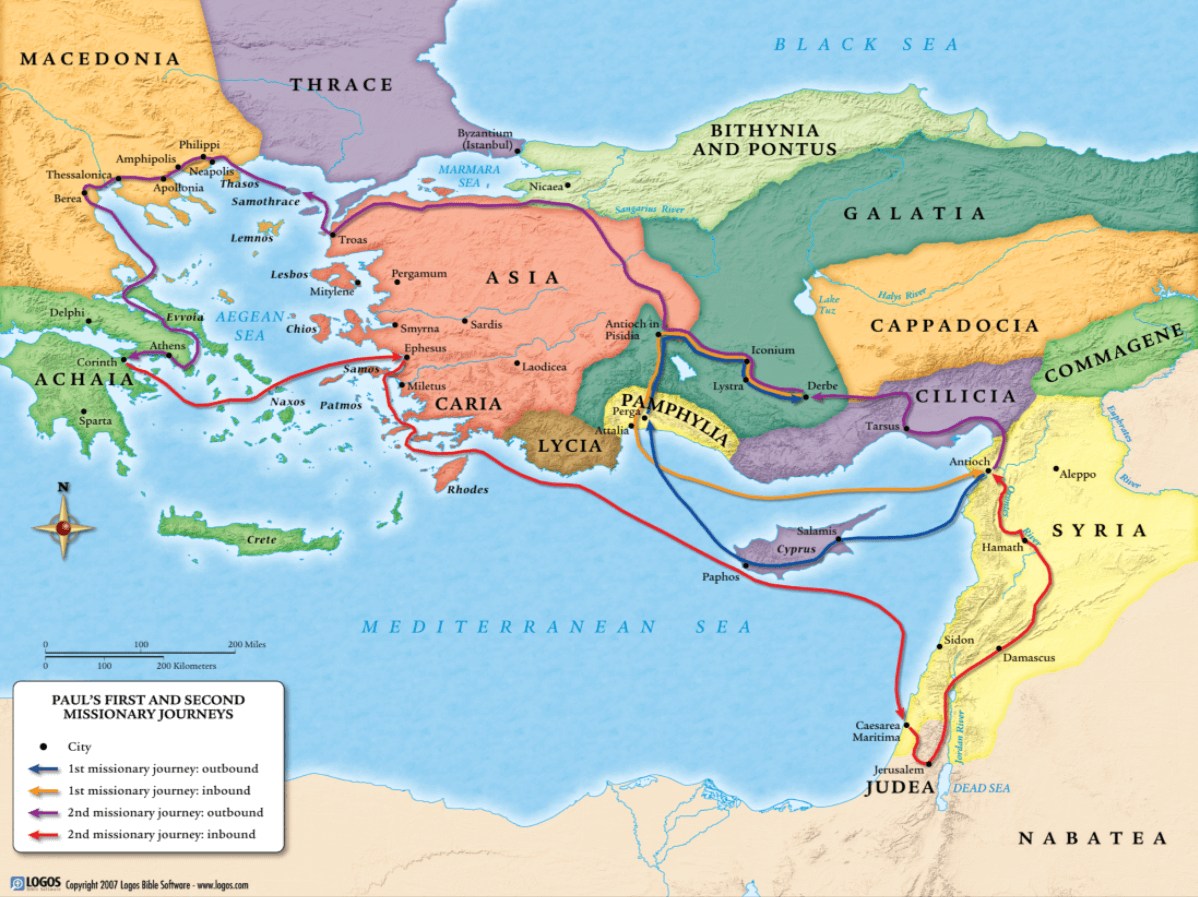
Paul and Barnabas set out from Antioch to Seleucia, where they set sail for the island of Cyprus.
Once Paul and Barnabas arrive on Cyprus, they begin to proclaim the Word of God in the Jewish synagogue. John Mark was with them as a helper.
Traveling through the whole island, they arrive at Paphos where they are opposed by a Jewish sorcerer called Elymas. The Lord causes Elymas to be blind, and Paul and Barnabas sail to Perga.
In Perga, John Mark leaves Paul and Barnabas and goes to Jerusalem. Paul and Barnabas then head for Pisidian Antioch.
In Pisidian Antioch, Paul stands up and delivers a sermon in the synagogue, prompting the people to invite him and Barnabas back the following week. However, the next week they are opposed by jealous Jewish leaders, who eventually convince the people to expel Paul and Barnabas. They declare they will turn their mission efforts to the Gentiles (non-Jews).
Arriving at Iconium, Paul and Barnabas once again speak in the synagogue. With the city divided on their teachings, Paul and Barnabas find out about a plot to stone them and leave the city for Lystra and Derbe.
In Lystra, Paul heals a man who was lame from birth. When the crowds see what Paul does, they hail him and Barnabas as Greek gods and try to sacrifice to them. However, after Jews in the city incite the people against Paul and Barnabas, they stone Paul and drag him outside of the city, assuming he is dead. The next day, he and Barnabas depart for Derbe.
Paul and Barnabas preach the Word of God successfully in Derbe, and then head back to the cities they had already visited to strengthen the brothers and sisters in each city before they return to Syrian Antioch. They also appointed elders in each city who would continue to guide and strengthen the family of believers.
Paul and Barnabas return to Lystra to encourage the believers there on their way to Iconium.
Paul and Barnabas return to Iconium to encourage the believers there on their way to Pysidian Antioch.
Paul and Barnabas return to Pysidian Antioch to encourage the believers there on their way to Perga.
Paul and Barnabas preach the Word in Perga, then set sail from Attalia back to Syrian Antioch.
Paul and Barnabas completed the First Missionary Journey in the late 40s AD. It does not appear that they spent much time in the cities they visited, so the entire journey could have been done in about a year and a half. Between the First and Second Missionary Journeys, Paul writes his letter to the Galatians (most likely the churches he visited on the First Journey) and also travels to Jerusalem for the Jerusalem Council around 49 AD (see Acts 15). Some time later, Paul and Barnabas decide to conduct a Second Missionary Journey, but they disagree as to whether they should bring John Mark with them again because he left them early on the First Journey. They split, with Barnabas taking John Mark and traveling to Cyprus, while Paul takes Silas and travels through Syria and Cilicia on their way to Derbe, thus beginning the Second Journey.
Paul travels from Derbe to Lystra, where he meets a young man named Timothy. Everyone in the surrounding towns spoke well of him, so Paul has him circumcised and brings him along on the journey. As he travels through Galatia, he delivers the decisions made at the Jerusalem Council and strengthens each church in the region on his way to Asia.
Paul and his companions were kept from preaching the gospel in the province of Asia by the Holy Spirit, so they head north toward Bithynia.
Luke tells us in Acts that “the Spirit of Jesus would not allow them” to enter Bithynia, so Paul and his companions head west to Troas.
While in Troas, Jesus’ plan for them on this journey is revealed to Paul in a vision. In the vision, Paul sees a man from Macedonia begging him, “Come over to Macedonia and help us.” Due to the abrupt change from third person to first person pronouns, it is also believed that this is where Luke, the physician and author of the Gospel of Luke and Acts, joins Paul and his other companions. In response to Paul’s vision, they all set out for Samothrace and Neapolis on their way to Philippi in Macedonia.
At Philippi, Paul and his companions meet a woman named Lydia who was a worshiper of God. After baptizing her and the members of her household, they accept an invitation to stay at her house while they were in Philippi.
Later, Paul and those with him were followed by a girl who had a spirit that allowed her to predict the future. For many days she would follow them and say, “These men are servants of the Most High God, who are telling you the way to be saved.” Paul eventually got annoyed and commanded the spirit to come out of the girl in the name Jesus Christ. The men who used the girl’s telling the future to make money were upset and had Paul and Silas thrown in prison.
While they were in prison, an earthquake shook the foundations of the prison and the prison doors and chains were all opened. With the jailer about to kill himself in fear of punishment from his superiors, he asks Paul and Silas what he must do to be saved. They tell him, “Believe in the Lord Jesus, and you will be saved—you and your household.” The jailer invited them over to his house, and that night he and his whole household believed and were baptized.
The next day, Paul and Silas were released from prison and left the city with the rest of their companions.
Paul and his companions travel to Thessalonica, where Paul spends three Sabbaths in the synagogue proclaiming Jesus as the Messiah. A number of Jews and Greeks believed, but some Jews became jealous and started a riot in the city. Looking for Paul at the house of a man named Jason, they dragged Jason and some other believers before the city officials. The officials made Jason and the others post bond, while Paul and his companions were sent away by the believers during the night.
When they arrive at Berea, according to their custom they enter the synagogue and begin preaching about Jesus. The Berean Jews are much more open to their message than the Thessalonicans were, so they examine the Scriptures every day to verify what Paul was saying about Christ.
The Jews in Thessalonica find out that Paul is in Berea and send people to agitate the crowds in the city. The believers in Berea then send Paul to the coast and eventually Athens, but Silas and Timothy stay behind.
While Paul waits for Silas and Timothy to join him in Athens, he reasons with the Jews in the synagogue as well as the Greeks in the marketplace that Jesus is the promised Messiah. Some philosophers bring him to a meeting of the Areopagus, a council of city elders and leaders, and have him explain this “new teaching” of Jesus as the Messiah. This is where Paul delivers his famous sermon using an Athenian altar inscription to an “UNKNOWN GOD.” Paul explains to them that the one, true God does not live in temples and that he has raised Jesus from the dead to prove that he is the Savior of the world. After some believe, Paul then travels to Corinth.
When Paul arrives in Corinth he meets a Jew named Aquila and his wife, Priscilla. Since they are tentmakers as he is, he stays and works with them, preaching Jesus as the promised Messiah each Sabbath in the synagogue. When Timothy and Silas arrive, Paul then dedicates his whole time to gospel ministry. With the Jews denying his message, he concentrates reaching out to the Gentiles (non-Jews). After Jesus appears in a vision to Paul and tells him to keep preaching in Corinth, he stays there for a year and a half. During this time, Paul writes the letters we know as 1 and 2 Thessalonians to the church he began earlier on this journey in Thessalonica. Also at this time, Gallio, the proconsul of Achaia, dismisses the non-believing Jews’ attempts to stop Paul, a very important decision for the spread of the gospel in Achaia. Paul eventually leaves Corinth with Aquila and Priscilla for Ephesus on his way back home to Syrian Antioch.
Paul stays briefly in Ephesus, preaching to the Jews in the synagogue and declining their request to stay. He tells them he will return if it is the Lord’s will (and from what we see during the Third Missionary Journey, it certainly was). Leaving Aquila and Priscilla in Ephesus, he sets sail for Caesarea.
Landing in Caesarea, Paul visits the believers in Jerusalem before heading back up north to Syrian Antioch.
Paul arrives back in Antioch having spent roughly 2.5 to 3 years on his Second Missionary Journey, being blessed to have preached the gospel in Europe. Perhaps up to one year later he begins his Third Missionary Journey.
- First Missionary Journey and Jerusalem Council – Acts 13-15
- Second Missionary Journey – Acts 16-18:22
Chronology of Jesus’ Life and Ministry
Chronology of paul’s ministry, chronology of the old testament kings, chronology of latter prophets and intertestamental period, chronology of the prophets, paul’s third missionary journey, genesis genealogical charts, chronology of the flood, the events of holy week, order of resurrection events, chronology of the old testament books, chronology of the new testament books, composite of the four gospels, timeline of salvation history.
This site uses cookies. By continuing to browse the site, you are agreeing to our use of cookies. Privacy Policy
Cookie and Privacy Settings
We may request cookies to be set on your device. We use cookies to let us know when you visit our websites, how you interact with us, to enrich your user experience, and to customize your relationship with our website.
Click on the different category headings to find out more. You can also change some of your preferences. Note that blocking some types of cookies may impact your experience on our websites and the services we are able to offer.
These cookies are strictly necessary to provide you with services available through our website and to use some of its features.
Because these cookies are strictly necessary to deliver the website, refusing them will have impact how our site functions. You always can block or delete cookies by changing your browser settings and force blocking all cookies on this website. But this will always prompt you to accept/refuse cookies when revisiting our site.
We fully respect if you want to refuse cookies but to avoid asking you again and again kindly allow us to store a cookie for that. You are free to opt out any time or opt in for other cookies to get a better experience. If you refuse cookies we will remove all set cookies in our domain.
We provide you with a list of stored cookies on your computer in our domain so you can check what we stored. Due to security reasons we are not able to show or modify cookies from other domains. You can check these in your browser security settings.
These cookies collect information that is used either in aggregate form to help us understand how our website is being used or how effective our marketing campaigns are, or to help us customize our website and application for you in order to enhance your experience.
If you do not want that we track your visit to our site you can disable tracking in your browser here:
We also use different external services like Google Webfonts, Google Maps, and external Video providers. Since these providers may collect personal data like your IP address we allow you to block them here. Please be aware that this might heavily reduce the functionality and appearance of our site. Changes will take effect once you reload the page.
Google Webfont Settings:
Google Map Settings:
Google reCaptcha Settings:
Vimeo and Youtube video embeds:
The following cookies are also needed - You can choose if you want to allow them:
You can read about our cookies and privacy settings in detail on our Privacy Policy Page.
What happened on Paul’s second missionary journey?
Bible question:.
What happened on Paul's second missionary journey?
Bible Answer:
Paul started his second missionary journey in the summer of A.D. 50. He and Barnabas traveled together. Their adventures are described in Acts 15:36-18:22. During this journey Paul returned to the churches in Galatia that God had started through Paul and Barnabas during the first missionary journey. During Paul’s third missionary journey he will revisit them again. During both the second and third missionary journeys, he and Barnabas visited Greece.
Paul’s Second Missionary Journey (Acts 15:36–18:22)
Paul and Silas revisited the places in Asia Minor where Paul had preached on his first journey (cf. map), while Barnabas took John Mark and sailed to Cyprus. Paul and Silas visited Derbe, Lystra, and Antioch in Pisidia. From there Paul and Silas traveled to Troas, where Paul received a vision of a man from Macedonia calling to them. Crossing into Europe, they passed through several towns along the Egnatian Way and traveled to the cities of Athens and Corinth in southern Greece. Then sailing to Ephesus and Caesarea, they visited the church in Jerusalem before returning to Antioch of Syria.
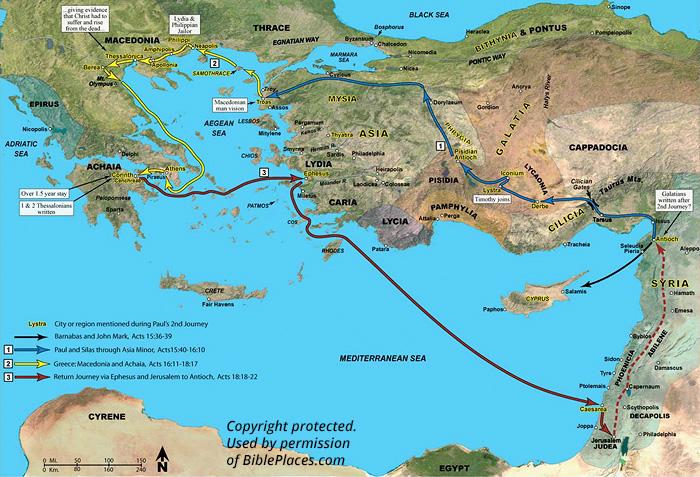
The following is the itinerary of Paul and Barnabas. The timeline indicates that they spent about three months revisiting the churches in Asia Minor or the region of Galatia.
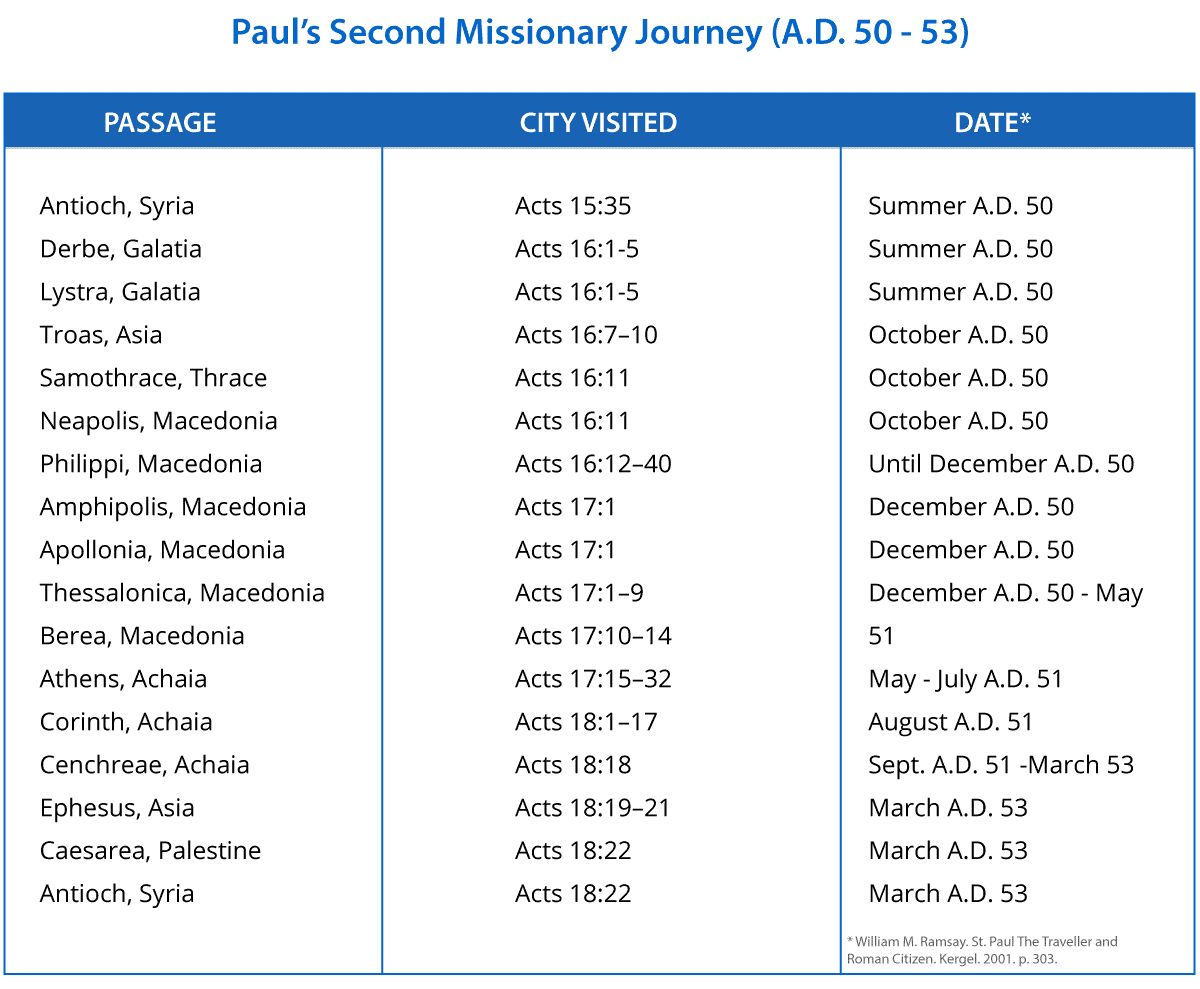
Conclusion:
One of the most significant conversions that occurred during this trip was in Philippi. Acts 16:14 reports that Lydia, a seller of purple fabrics, believed in Jesus Christ and became a Christian. Another significant event occurred when the Bereans examined Scripture to determine if the apostle Paul was telling the truth about Christ. In Acts 17:22-32 Paul shared Christ with the men in Athens. In Acts 18:1-17 some Corinthians became Christians.
Suggested Links:
To the glory of god.
Thus says the LORD, “Let not a wise man boast of his wisdom, and let not the mighty man boast of his might, let not a rich man boast of his riches; but let him who boasts boast of this, that he understands and knows Me . . . Jeremiah 9:23-24
Like The Master Ministries
P.O. Box 31976 Tucson, AZ 85751
A non-profit, 501(c)3 corporation. Donations to this ministry are tax-deductible.
Getting Acquainted
- Our Purpose
- Origin of Our Name
- What We Believe
- About the Author
- Copyright Policy
- Privacy Policy
- Terms of Use
- Donate to NeverThirsty
- Submit A Bible Question
- Newsletter Signup
Search a pre-defined list
The Whole Bible The Old Testament The New Testament ────────────── Pentateuch Historical Books Poetical Books Wisdom Literature Prophets Major Prophets Minor Prophets ────────────── The Gospels Luke-Acts Pauline Epistles General Epistles Johannine Writings ────────────── Genesis Exodus Leviticus Numbers Deuteronomy Joshua Judges Ruth 1 Samuel 2 Samuel 1 Kings 2 Kings 1 Chronicles 2 Chronicles Ezra Nehemiah Esther Job Psalms Proverbs Ecclesiastes Song of Songs Isaiah Jeremiah Lamentations Ezekiel Daniel Hosea Joel Amos Obadiah Jonah Micah Nahum Habakkuk Zephaniah Haggai Zechariah Malachi Matthew Mark Luke John Acts Romans 1 Corinthians 2 Corinthians Galatians Ephesians Philippians Colossians 1 Thessalonians 2 Thessalonians 1 Timothy 2 Timothy Titus Philemon Hebrews James 1 Peter 2 Peter 1 John 2 John 3 John Jude Revelation
OR Select a range of biblical books
Select a Beginning Point Genesis Exodus Leviticus Numbers Deuteronomy Joshua Judges Ruth 1 Samuel 2 Samuel 1 Kings 2 Kings 1 Chronicles 2 Chronicles Ezra Nehemiah Esther Job Psalms Proverbs Ecclesiastes Song of Songs Isaiah Jeremiah Lamentations Ezekiel Daniel Hosea Joel Amos Obadiah Jonah Micah Nahum Habakkuk Zephaniah Haggai Zechariah Malachi Matthew Mark Luke John Acts Romans 1 Corinthians 2 Corinthians Galatians Ephesians Philippians Colossians 1 Thessalonians 2 Thessalonians 1 Timothy 2 Timothy Titus Philemon Hebrews James 1 Peter 2 Peter 1 John 2 John 3 John Jude Revelation
Select an Ending Point Genesis Exodus Leviticus Numbers Deuteronomy Joshua Judges Ruth 1 Samuel 2 Samuel 1 Kings 2 Kings 1 Chronicles 2 Chronicles Ezra Nehemiah Esther Job Psalms Proverbs Ecclesiastes Song of Songs Isaiah Jeremiah Lamentations Ezekiel Daniel Hosea Joel Amos Obadiah Jonah Micah Nahum Habakkuk Zephaniah Haggai Zechariah Malachi Matthew Mark Luke John Acts Romans 1 Corinthians 2 Corinthians Galatians Ephesians Philippians Colossians 1 Thessalonians 2 Thessalonians 1 Timothy 2 Timothy Titus Philemon Hebrews James 1 Peter 2 Peter 1 John 2 John 3 John Jude Revelation
OR Custom Selection:
Use semicolons to separate groups: 'Gen;Jdg;Psa-Mal' or 'Rom 3-12;Mat 1:15;Mat 5:12-22'

Click to Change
Return to Top

Paul's Second Missionary Journey
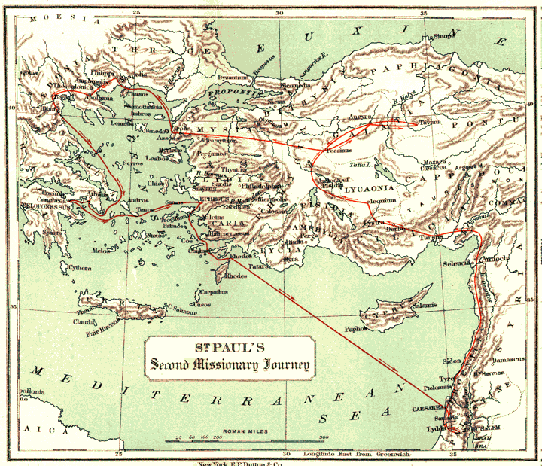
Life and Work of St. Paul (1879) by Farrar (Click image to enlarge)
Search Results in Other Versions
Search results by book, blb searches, search the bible.
Advanced Options
There are options set in 'Advanced Options'
Theological FAQs
Other Searches
Multi-Verse Retrieval
* 'Number Delimiters' only apply to 'Paragraph Order'
Let's Connect
Daily devotionals.
Blue Letter Bible offers several daily devotional readings in order to help you refocus on Christ and the Gospel of His peace and righteousness.
- BLB Daily Promises
- Day by Day by Grace
- Morning and Evening
- Faith's Checkbook
- Daily Bible Reading
Daily Bible Reading Plans
Recognizing the value of consistent reflection upon the Word of God in order to refocus one's mind and heart upon Christ and His Gospel of peace, we provide several reading plans designed to cover the entire Bible in a year.
One-Year Plans
- Chronological
- Old Testament and New Testament Together
Two-Year Plan
- Canonical Five Day Plan
Recently Popular Pages
- H1788 - dîšôn - Strong's Hebrew Lexicon (kjv)
- Spurgeon's Morning and Evening
- Wisdom for the Asking by C. H. Spurgeon
- David Guzik :: Study Guide for Matthew 27
- David Guzik :: Hechos 2 – El Espíritu Santo Es Derramado Sobre la Iglesia
- David Guzik :: Éxodo 33 – El Camino de Israel hacia una Relación Restaurada
- H1791 - dēḵ - Strong's Hebrew Lexicon (kjv)
- G3859 - diaparatribē - Strong's Greek Lexicon (kjv)
- David Guzik :: Study Guide for 2 Corinthians 3
Recently Popular Media
- Jehovah's Witnesses, Jesus and the Holy Trinity (Walter Martin)
- Who Is Jesus Christ? (Tony Clark)
- Genesis 2-3 (1979-82 Audio) (Chuck Smith)
- Amos 6-9 (Raul Ries)
- The Upper Room Connection (Chuck Missler)
- Revelation 6:12-14 (Dr. J. Vernon McGee)
- 2 Thessalonians 1:8-12 (Dr. J. Vernon McGee)
- 2 Corinthians 3 (All) (Dr. J. Vernon McGee)
- Acts 2 (All) (Dr. J. Vernon McGee)
- Judges 13-15 (Jon Courson)
CONTENT DISCLAIMER:
The Blue Letter Bible ministry and the BLB Institute hold to the historical, conservative Christian faith, which includes a firm belief in the inerrancy of Scripture. Since the text and audio content provided by BLB represent a range of evangelical traditions, all of the ideas and principles conveyed in the resource materials are not necessarily affirmed, in total, by this ministry.
Bible Commentaries
Bible reference, biblical language resources, theological resources, topical indexes, help & support, devotionals.
Blue Letter Bible study tools make reading, searching and studying the Bible easy and rewarding.
Blue Letter Bible is a 501(c)(3) nonprofit organization
©2024 Blue Letter Bible | Privacy Policy
Copy Translation Order [?]
Translation selection order copied to bibles tab order, bibles tab order copied to translation selection order, translation selection order and bibles tab order have been reset.
You can copy the order of your preferred Bible translations from the Bibles Tab to the Version Picker (this popup) or vice versa. The Bibles Tab is found in the Tools feature on Bible pages:
Cite This Page
Note: MLA no longer requires the URL as part of their citation standard. Individual instructors or editors may still require the use of URLs.
Chicago Format
Share this page, email this page.
You must be logged in to send email.
Follow Blue Letter Bible
Subscribe to the newsletter.

Blue Letter Bible
Login to your account.
Email / username or password was incorrect!
Check your email for password retrieval
Keep me logged in!
Did you forget your password?
Register a new BLB account
Complete the form below to register [?]
Error: That Email is already registered
Error: Please provide a valid Email
Error: Passwords should have at least 6 characters
Error: Passwords do not match
Error: Please provide a valid first name
Error: That username is already taken
Error: Usernames should only contain letters, numbers, dots, dashes, or underscores
← Login to Your Account
Passwords should have at least 6 characters. Usernames should only contain letters, numbers, dots, dashes, or underscores.
Thank you for registering. A verification email has been sent to the address you provided.
Did You Know BLB Is User Supported?
Your partnership makes all we do possible. Would you prayerfully consider a gift of support today?
Cookie Notice: Our website uses cookies to store user preferences. By proceeding, you consent to our cookie usage. Please see Blue Letter Bible's Privacy Policy for cookie usage details.
Old Testament
New testament.
- Our Ministry
- The Gap We See
- Partner with Us
- Newsletters

- Partner With Us
Christian History
Time Periods
- Early Church • 1 - 500 AD
- Middle Ages • 500 - 1500 AD
- Reformation • 1500 - 1650 AD
- Early Modern • 1500 - 1800 AD
- Modern • 1800 - Present
- Full Timeline
- Story Behind
- Denominations & Traditions
- Literature & the Arts
- Missions & World Christianity
- Preachers & Evangelists
- The American Experience
- Theologians
- 100 Events in Church History
Key Figures by Category
- Today in Christian History

- Subscribe to CT magazine for full access to the Christian History Archives
- Give a Gift
Featured Holidays

- All Holidays

Featured People

- Denominational Founders
- Pastors and Preachers
- All Categories
- On the Road With Paul Edwin M. Yamauchi
- Bald, Blind & Single? Stephen Miller
- Boundary Breaker James D. Smith III
- The Apostle Paul and His Times: Christian History Timeline Janet Meyer Everts
- Subversive Conservative Craig Keener
On the Road With Paul
- Early Church
- Middle Ages
- Reformation
- Early Modern
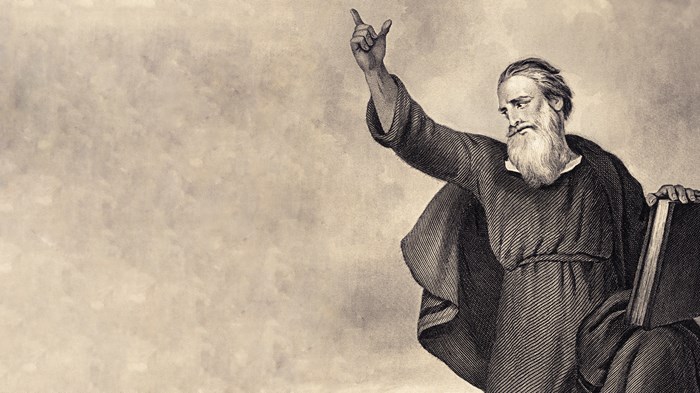
- Current Issue

- How to Pray with ADHD
- The Struggle to Hold It Together When a Church Falls Apart
- The Secret Sin of ‘Mommy Juice’
The first two centuries of the Christian era were great days for a traveler, writes historian Lionel Casson: “He could make his way from the shores of the Euphrates to the border between England and Scotland without crossing a foreign frontier.… He could sail through any waters without fear of pirates, thanks to the emperor’s patrol squadrons. A planned network of good roads gave him access to all major centers, and the through routes were policed well enough for him to ride them with relatively little fear of bandits.”
Because of the Pax Romana (Roman Peace) of Emperor Augustus (27 B.C. – A.D. 14), such conditions prevailed when Paul traveled the Roman world. The Stoic philosopher Epictetus (d. about 135) declared, “There are neither wars nor battles, nor great robberies nor piracies, but we may travel at all hours, and sail from east to west.”
New Testament archaeologist W.M. Ramsay concludes, “The Roman roads were probably at their best during the first century after Augustus had put an end to war and disorder.… Thus St. Paul traveled in the best and safest period.”
What would it have been like to travel with Paul during this unique era of ancient history?
Roads Built to Last
By the time of Emperor Diocletian (c. A.D. 300), the Romans had built a marvelous network of over 53,000 miles of roads throughout the Empire, primarily for military purposes. They were generally 10 to 12 feet wide and models of road construction. Plutarch writes about one official’s work:
“The roads were carried through the country in a perfectly straight line, and were paved with hewn stone and reinforced with banks of tight-rammed sand. Depressions were filled up, all intersecting torrents or ravines were bridged, and both sides were of equal and corresponding height, so that the work presented everywhere an even and beautiful appearance. Besides all this, he measured off all the roads by miles … and planted stone pillars as distance markers.”
The Roman mile (a word derived from mille passus , “thousand paces”) was one thousand five-foot paces, or about 95 yards shorter than our mile. Mile markers—inscribed stone columns five to six feet tall—marked distances.
During his first missionary journey, after he crossed inland from the southern coast of Turkey, Paul used the Via Sebaste, a road built under Augustus in 6 B.C., which connected six military colonies, including Antioch in Pisidia. Much of his other travels in Galatia and Phrygia, however, were on unpaved tracks.
During his second missionary journey, after landing at Neapolis, Paul took the Via Egnatia from Philippi to Thessalonica. This major highway was built by the Romans after they had taken over Macedonia in 148 B.C. It spanned Greece and was eventually extended east beyond Philippi to Byzantium. Paul left this road when he went south to Berea, but he must have taken it later when he evangelized Illyricum (Yugoslavia; see Rom. 15:19).
After landing at Puteoli, Italy, Paul traveled the most famous Roman road, the Via Appia, the road from Rome to points south, which had been built in the third century B.C.
On such sturdy roads, soldiers could march four miles per hour, and on forced marches, five miles per hour. The average traveler walked three miles per hour for about seven hours a day—or about 20 miles per day. For example, Peter’s trip from Joppa to Caesarea, a distance of 40 miles, took two days (Acts 10:23–24). Paul traveled from Troas to Assos on foot, a distance of about 20 miles (Acts 20:13–14), so it probably took him a day.
Even with sound roads, travelers did well to wear heavy shoes or sandals, to have capes and broad-brimmed hats, and to carry bedding, tents, and provisions. Though traveling during the winter was possible, snows sometimes blocked high passes, and rains in October and May flooded the rivers and made them difficult to cross. In some isolated areas, travelers faced dangers from robbers, as well as from wild animals such as bears, wolves, and boars.
Paul no doubt had some of these problems in mind when he wrote to the Corinthians, “I have been in danger from rivers, in danger from bandits … in danger in the country” (2 Cor. 11:26).
Highway Speeds
Some extraordinary records were accomplished by determined travelers on horseback. Julius Caesar covered 800 miles from the Rhone River in France to Rome in eight days. Tiberius raced 500 miles in three days to reach his mortally wounded brother Drusus.
The official messenger system, the Cursus Publicus , used couriers who changed horses at stationes every 10 miles, or at mansiones every 20 to 30 miles. They were expected to cover 50 miles per day. The same messenger (rather than a relay of messengers) carried such important tidings as the death or accession of an emperor. A courier could travel from Rome to Palestine in 46 days, from Rome to Egypt in 64 days.
Those who traveled by carriage could cover between 25 and 50 miles per day. Roman vehicles had no springs, so the passengers felt every bump on the road. The Romans had such vehicles as the carpentum , a two-wheeled deluxe carriage, the redda , a four-wheeled wagon, and the carruca , a covered wagon. Wealthy individuals, like the Ethiopian treasurer of Queen Candace of Meroe, could afford a chauffeur-driven chariot (see Acts 8:28, 38).
For the most part, only military personnel and government officials traveled by horse. The one time that Paul used a horse was when he was escorted by soldiers from Jerusalem to Caesarea (Acts 23:23–24).
Inns of Ill-Repute
After a long-day’s journey, where did travelers lodge? Well-to-do Romans avoided inns if possible, and either set up their own tents or stayed with friends. Roman writers (such as Horace and Apuleius) uniformly criticized inns for their adulterated wine, filthy sleeping quarters, extortionate innkeepers, gamblers, thieves, and prostitutes. The apocryphal Acts of John relates the amusing story of the apostle who, coming to a bed infested with bugs, ordered the insects to depart for the night.
In literary texts we learn of rather comfortable inns in Asia Minor, and less reputable ones in Greece, though the New Testament never mentions Paul’s staying in one. Christians from Rome traveled 40 miles south to meet Paul and his party coming from Puteoli at a place known as the Forum of Appius and the Three Taverns (Acts 28:15), but it is not likely the party stayed in any of these tavern-inns.
That’s because Christians were urged to practice hospitality for traveling believers. The elder John, for example, commended his friend Gaius for opening his home to traveling preachers: “You are faithful in what you are doing for the brothers even though they are strangers to you.… You will do well to send them on their way in a manner worthy of God” (3 John 5, 6).
An early Christian document, the Didache , indicates, though, that this hospitality could be abused:
“Let every apostle who comes to you be welcomed as if he were the Lord. But he is not to stay for more than one day, unless there is need, in which case he may stay another. But if he stays three days, he is a false prophet. And when the apostle leaves, he is to take nothing except bread until he finds his next night’s lodging. But if he asks for money, he is a false prophet.”
On his journeys, Paul enjoyed the hospitality of Lydia in Philippi (Acts 16:15), of Jason in Thessalonica (Acts 17:5), and of Gaius in Corinth (Rom. 16:23)—to name three of his hosts.
Dangers on the Seas
By far the fastest form of long-distance travel was to go by ship—at least in one direction. It is significant that Paul sailed from the Aegean to Palestine but always went overland from Palestine to the Aegean. The one time he sailed west was as a Roman prisoner.
The reason for eastward sailing is simple: the prevailing winds during the summer, the sailing season, generally blew from the northwest. This greatly eased an eastward voyage, which could be made directly from Rome to Alexandria in from 10 to 20 days. By the same token, these same winds would hinder the westward journey, which could take from 40 to 65 days or even more. This had to be accomplished by sailing from Egypt northward along the coast of Palestine and then west along the southern coast of Turkey. Ancient ships generally had but one main square sail, so their ability to tack against the wind was limited.
There were no passenger ships as such. Passengers sailed on cargo ships as space was available. The ships left when the winds and omens were favorable. The expense for passage was not high; it cost a family but two drachma (about two-days’ wages) to sail from Alexandria to Athens. The fare included the provision of water but not of food and of cabins.
Alexandrian grain ships, upon one of which Paul traveled to Rome, played a key role in the ancient world. The wheat of Egypt supplied at least a third of the grain necessary to feed the population of Rome. Rome needed to import annually between 200,000 and 400,000 tons to feed its population of about a million. Lucian (second century A.D.) gave a vivid description of an Alexandrian grain ship, the Isis, which was blown off its course into Piraeus, the harbor of Athens: the ship was huge, 180 feet long, with a beam about 45 feet, and a depth also about 45 feet. Such ships could carry 1,200 tons of grain.
The safe sailing season was from May 27 to September 14. Risky seasons were from March 10 to May 26 and from September 15 to November 11. The winter season, from November 12 to March 9, was avoided except for emergencies or military campaigns.
Even travel on land was avoided during winter—hence Paul’s plan to spend one winter at Corinth (1 Cor. 16:5–6) and another at Nicopolis (Titus 3:12), as well as his urgent plea to Timothy, “Do your best to come before winter” (2 Tim. 4:21).
The greatest danger of winter sailing, of course, was shipwrecks. In his second letter to Corinth, Paul mentions being shipwrecked three times, and on one of these occasions, spending a night and a day floating in the open sea. Yet we know of another shipwreck still, and Luke’s description of it (in Acts 27) is one of the most vivid narratives in all of ancient literature.
At Caesarea Paul was placed on board a ship from Adramyttium; at Myra, in southern Turkey, he was transferred to an Alexandrian grain ship headed to Rome. (One ancient manuscript of Acts says the trip to Myra took 15 days.) Luke’s reference to the Day of Atonement (about October 5) indicates that this ship was sailing late in the season.
After reaching the southern coast of Crete, the captain wished to get to the larger harbor at Phoenix to winter, but a ferocious northeasterner, the Euroclydon, cast the ship helplessly adrift westward for many days without sight of sun or stars. The ship took such a battering it had to be abandoned. Ancient ships carried small boats for the transfer of passengers to the shore but no life rafts or life vests. It was miraculous that all 276 passengers and crew survived.
Paul and the others found themselves shipwrecked at Malta, where they were forced to stay for three months. Underwater archaeological surveys have plotted 538 Roman shipwrecks in the Mediterranean, 142 from A.D. 1 to 150—eight of these are known from the island of Malta. After spending the winter there, Paul was transferred to another Alexandrian grain ship, which, Luke notes, had the figureheads of the twin gods, Castor and Pollux, whom pagans believed provided protection in storms! After short stops in Syracuse and Rhegium, Paul and his guard arrived safely at Puteoli, Italy.
All in all, especially compared to previous centuries, Paul’s travel conditions were ideal. As Irenaeus, the second century bishop of Lyons, put it, “The Romans have given the world peace, and we travel without fear along the roads and across the sea wherever we will.” And Paul the missionary eagerly took advantage of such conditions.
Edwin M. Yamauchi is professor of history at Miami (Ohio) University. He is co-author (with Richard Pierard and Robert Clouse) of The Two Kingdoms: The Church and Culture Throughout the Ages (Moody, 1993).

Support Our Work
Subscribe to CT for less than $4.25/month

Read These Next

The Magazine

- Issue Archives
- Member Benefits
Special Sections
- News & Reporting
- Español | All Languages
Topics & People
- Theology & Spirituality
- Church Life & Ministry
- Politics & Current Affairs
- Higher Education
- Global Church
- All Topics & People
Help & Info
- Contact Us | FAQ

IMAGES
VIDEO
COMMENTS
Learn about Paul's second missionary journey with Silas and Timothy, from Antioch to Philippi, Thessalonica, Berea, Athens, and Corinth. Read the biblical account of their preaching, persecution, miracles, and conversions.
Paul's Second Missionary Journey. 16 Paul went first to Derbe and then to Lystra, where there was a young disciple named Timothy. His mother was a Jewish believer, but his father was a Greek. 2 Timothy was well thought of by the believers [] in Lystra and Iconium, 3 so Paul wanted him to join them on their journey. In deference to the Jews of the area, he arranged for Timothy to be ...
Learn about Paul's second missionary journey in Acts 15:36-18:22, where he preached the gospel in new areas and faced persecution and imprisonment. See the locations, people, and lessons from his journey on a map and in detail.
Here is a map of Paul's second missionary journey to help you follow along: Paul's second missionary journey is recorded in Acts 15:36—18:22. A year or two after completing their first missionary journey, Paul suggested that he and Barnabas revisit the churches they had planted. A disagreement arose over whether or not John Mark, who had left ...
Learn about Paul's second missionary journey from Antioch to Tarsus, Cilicia, and Asia Minor in 49 A.D. Find out how he confirmed the churches, faced the Judaizers, and met Timothy.
Learn about Paul's first missionary journey, which took him from Antioch to Cyprus, Pamphylia, Pisidia, Phrygia, and Lycaonia. See the places he visited, the people he met, and the events that shaped the early church.
Learn about Paul's second missionary journey from Syria to Macedonia and Greece, as recorded in Acts 15:36 to 18:22. See the places, events, and people he encountered along the way, and how he preached the gospel and faced opposition.
Learn about Paul's second missionary journey around the eastern Mediterranean Sea, where he revisited and strengthened churches, wrote letters, and faced persecution. Discover what this journey teaches us about God's power, grace, and love.
Second Missionary Journey - After some days Paul said to Barnabas, "Let's return and visit the brothers and sisters in every city in which we proclaimed the word of the Lord, and see how they are." Barnabas wanted to take John, called Mark, along with them also. But Paul was of the opinion that they should not take along with them this man who had deserted them in Pamphylia and had not ...
Read the biblical account of Paul and Silas' travels in Macedonia, where they met Lydia, a believer in Jesus, and were imprisoned and freed by a miracle. Learn about the vision, the conversion, the earthquake, and the response of the jailer and his household.
Learn about Paul's second missionary journey from Acts 15:36-18:22, where he revisited Asia Minor and traveled to Europe. See the map and the ESV Global Study Bible notes on this journey.
Paul and Barnabas stay in Antioch a certain number of days until they have a sharp disagreement over whether to take John Mark with them on another missionary journey. The argument becomes so heated that they separate (Acts 15:36 - 41). Late Autumn 49 to Late Summer 50. Paul takes Silas with him to Tarsus. From there they travel to Derbe and ...
Learn about the apostle Paul's four missionary journeys, from his conversion to his martyrdom, and the places, people, and events he encountered along the way. Find out the timeline, the partners, the persecution, and the progress of the gospel in the book of Acts.
Apostle Paul's second missionary journey is recorded in Acts 15:36-18:22. It took place from 49 AD to 52 AD. The second missionary journey began with an unfortunate disagreement between Paul and Barnabas, which resulted in their separation, Barnabas going to the island of Cyprus, and Paul to the mainland. (Acts 15:36-40) The apostle chose as his… Continue reading Life of Apostle Paul ...
The order of Paul's Second Missionary Journey with Silas around AD49-52, returning to Asia Minor and on into Europe. 15:40-41 - ..... while Paul chose Silas and set out on his journey, commended to the grace of the Lord by the brothers as he did so. He travelled through Syria and Cilicia and strengthened the churches.
Paul's Second Missionary Journey (Acts 15:36-18:22) c. A.D. 49-51. Paul and Silas revisited the places in Asia Minor where Paul had preached on his first journey (see map), while Barnabas took John Mark and sailed to Cyprus. Paul and Silas visited Derbe, Lystra, and Antioch in Pisidia. From there Paul and Silas traveled to Troas, where ...
Map 24 Paul's Second Missionary Journey. Acts 15:40-41 Paul is joined by Silas ('Silvanus' in Latin - see 1 Thessalonians 1:1, 2 Thessalonians 1:1, 2 Corinthians 1:19 & 1 Peter 5:12). Silas is from the Jerusalem Christian community (see Acts 15:22-35). They travel through Syria and Cilicia encouraging the new believers there (see 2 on Map ...
First Missionary Journey and Jerusalem Council - Acts 13-15. Second Missionary Journey - Acts 16-18:22. This map with captions will guide you through the apostle Paul's first and second missionary journeys as they are described in the book of Acts.
Learn about Paul's travels with Silas and Barnabas in A.D. 50-53, revisiting the churches in Asia Minor and Greece. Find out the significant conversions and challenges they faced in Philippi, Athens, Corinth and Ephesus.
Paul's Second Missionary Journey approx. 51 A.D. Found in Acts 15:39-41; Acts 16-17; Acts 18:1-22. This is a map, Life and Work of St. Paul (1879) by Farrar. ... Paul's 2nd Journey. ← Back to Chronology of Acts and the Epistles. Paul's Second Missionary Journey Life and Work of St. Paul (1879) by Farrar (Click image to enlarge) Search Results ...
During his second missionary journey, after landing at Neapolis, Paul took the Via Egnatia from Philippi to Thessalonica. ... On his journeys, Paul enjoyed the hospitality of Lydia in Philippi ...